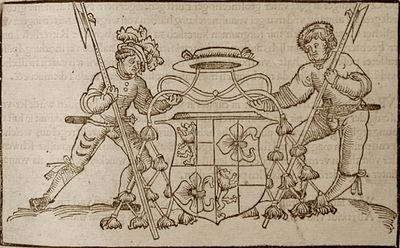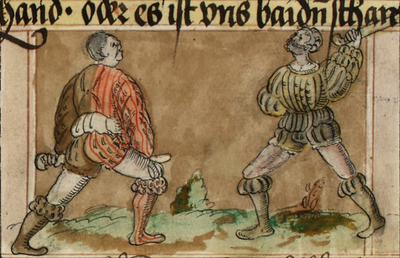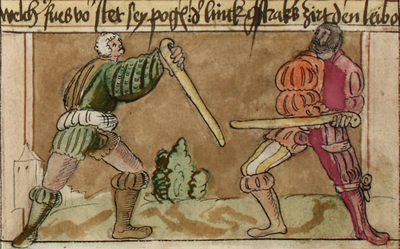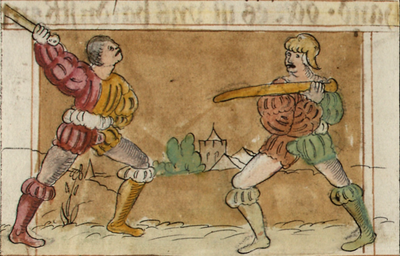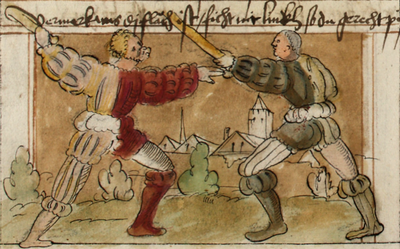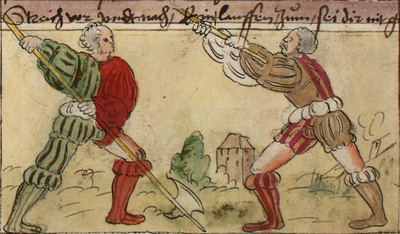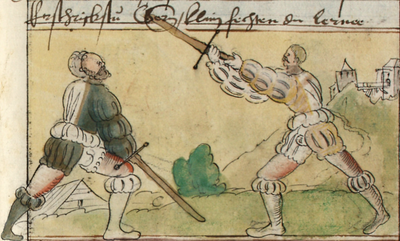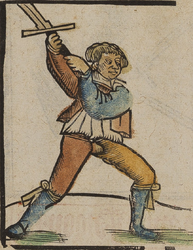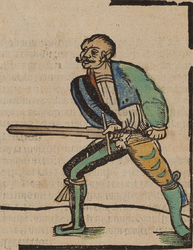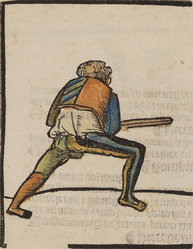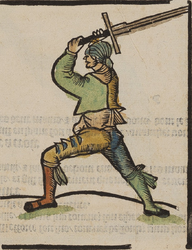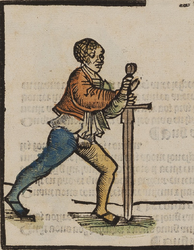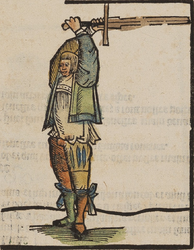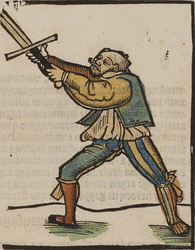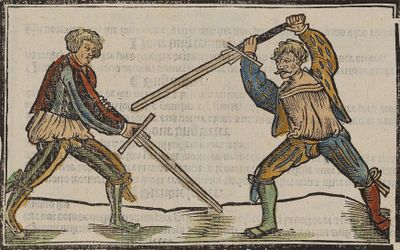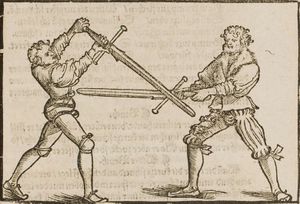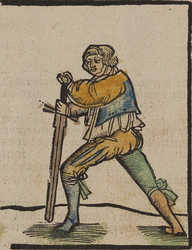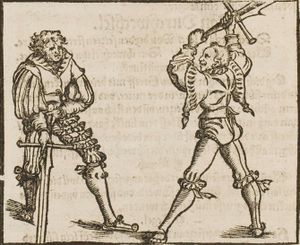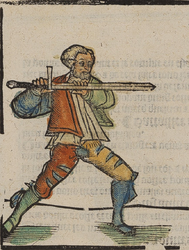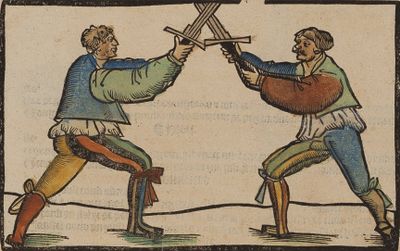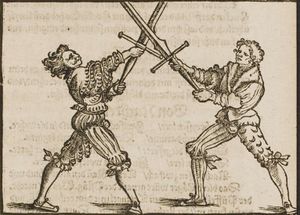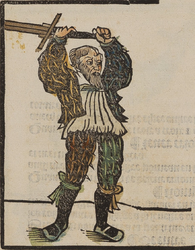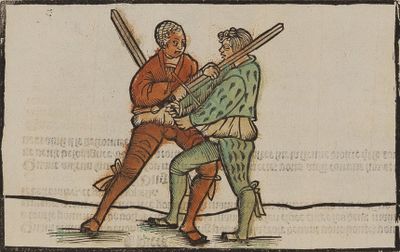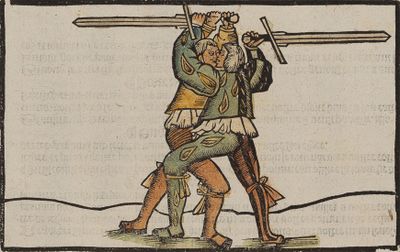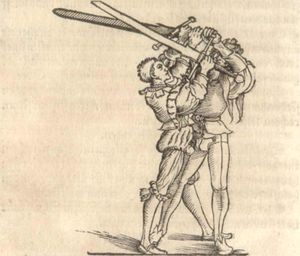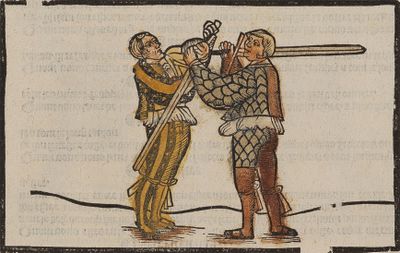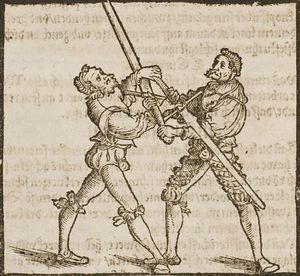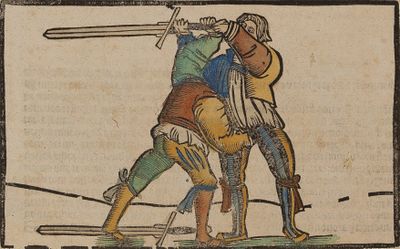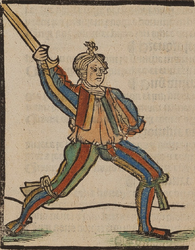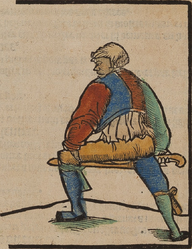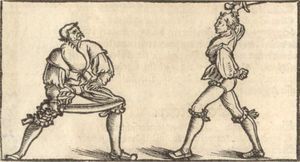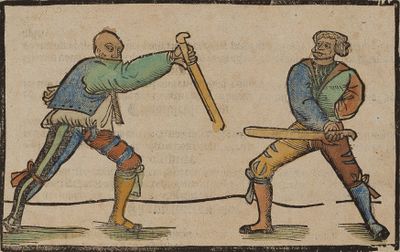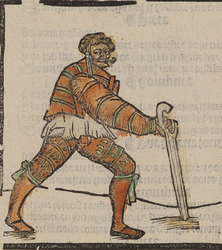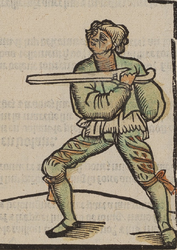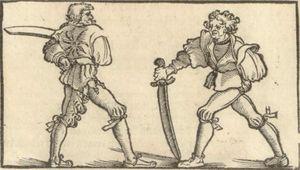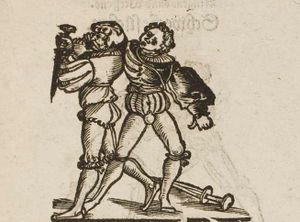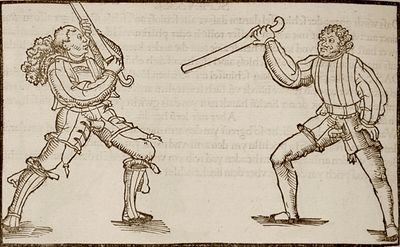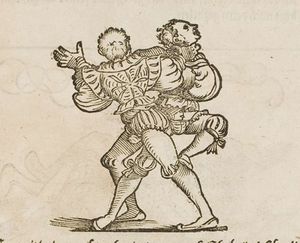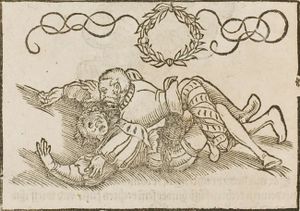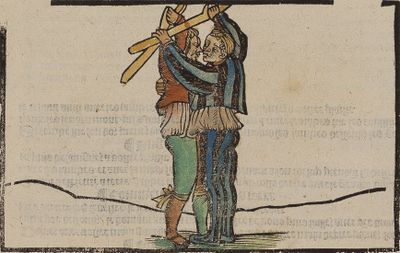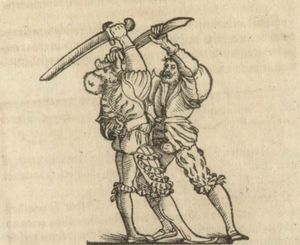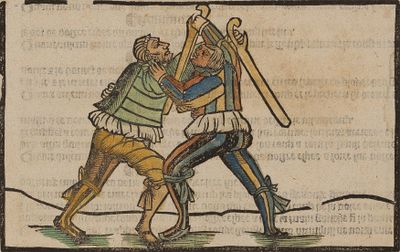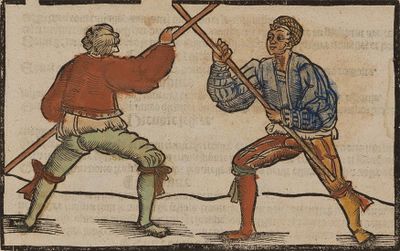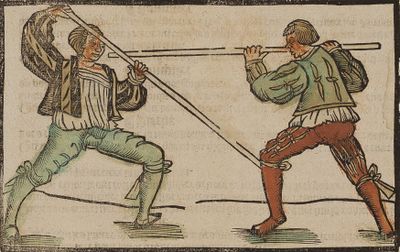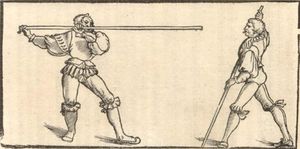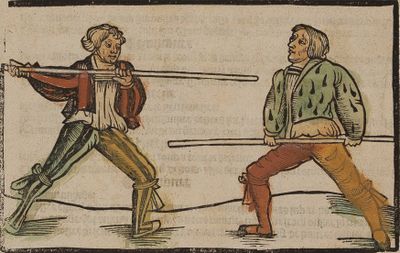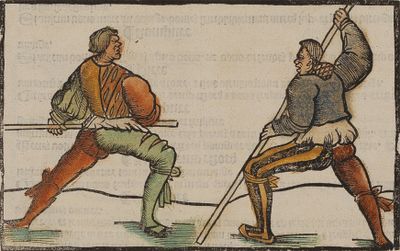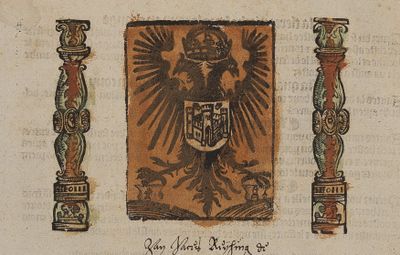|
|
You are not currently logged in. Are you accessing the unsecure (http) portal? Click here to switch to the secure portal. |
Andre Paurenfeyndt
| Andre Paurenfeyndt | |
|---|---|
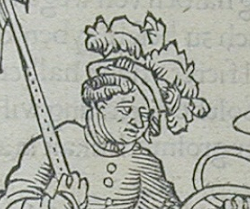 | |
| Born | 15th century |
| Died | 16th century |
| Occupation |
|
| Nationality | German |
| Patron | Matthäus Lang von Wellenburg |
| Movement | Liechtenauer Tradition |
| Influences | Johannes Liechtenauer |
| Influenced | |
| Genres | |
| Language | Early New High German |
| Notable work(s) | Ergrundung Ritterlicher Kunst der Fechterey (1516) |
| Manuscript(s) |
MS 963 (1538)
|
| Concordance by | Michael Chidester |
| Translations | Deutsch-Übersetzung |
Andre Paurenfeyndt (Paurñfeyndt, Paurñfeindt) was a 16th century German Freifechter. He was born in Ernsbrunn in Lower Austria, and he enrolled in the Universität Wien on 13 October 1512.[1] He mentions in his introduction that he served as a bodyguard to Cardinal Matthäus Lang von Wellenburg (1468-1540).[2] In 1516, he wrote and published a fencing manual entitled Ergrundung Ritterlicher Kunst der Fechterey ("Founding of the Chivalric Art of Swordplay"), which seems to have been the first illustrated fencing treatise ever published.[3] Little else is known about the life of this master, but he describes himself as a Freifechter and the contents of his book make it clear that he was associated with the tradition of Johannes Liechtenauer. His treatise diverges significantly from the earlier teachings of the Liechtenauer tradition, which may be due to his stated purpose of writing for beginning fencers.
Contents
Treatise
Please note that only the first edition (1516) has the complete set of illustrations, and all later versions are disorganized and incomplete; this article follows the order of plays and illustrations laid out in the original, and the variant sequences can be viewed on the transcription pages. Egenolff's illustrations are rather different from Paurenfeyndt's, and smaller thumbnails are included where applicable. Furthermore, the illustrations on pages 57 and 59 of the 1516 don't seem to relate to the plays described on 58 and 60, since they show pairs of fencers with dussacks while the text indicates that one of them should be unarmed. They are included here for reference, but the Egenolff illustrations (which are original and not based on Paurenfeyndt) are the ones that seem to depict something similar to the plays as described. While the Twelve Rules for the Beginning Fencer are unillustrated in Paurenfeyndt's work, this presentation includes the illustrations for six of the twelve found in the MS B.200 (1524).
Rather than presenting the treatise transcriptions chronologically, this concordance groups the three complete German texts together (including Lienhart Sollinger's 1564 copy), followed by the 1538 French translation. There are three shorter manuscript fragments of the German text, and these have been added in additional columns on the far end of the table in only the sections where they appear.
Illustrations |
First Edition (1516) |
Egenolff's Edition (ca. 1531) |
Augsburg Manuscript (1564) |
French Translation (1538) | ||
|---|---|---|---|---|---|---|
[1] An examination of the Knightly Art of Fighting by Andre Paurnfeindt, Freifechter of Vienna, Austria, towards a clear comprehension and concise understanding thereof. |
The Noble Science of the Sword-Players |
[Ttl] Ergrundung Ritterlicher kunst der Fechterey durch Andre paurenfeindt Freyfechter czu Vienna in Osterreich, nach klerlicher begreiffung und kurczlicher verstendnusz. |
[50r.1] Ergrundung Ritterlicher Kunst Der Fechttereÿ Durch Liennhartt Sollinger Messerschmidtt, Nach Klerlicher Begreiffung vnd Kurzlicher Verstendnus |
[Ttl] La noble science des ioueurs despee | ||
[2] To the Sublime Magnificent Prince and Lord, Sir Matthäus of the Holy Roman See, Cardinal of St. Angelo, Papal Legate, Bishop of Gurk, Coadjuctor of the Diocese of Salzburg etc; Andre Paurnfeindt, Freifechter and his Magnificence the Cardinal's loyal bodyguard, offers his humble service. |
[1.1] DEM Hochwirdigen Grosmechtigen Fursten und herren her MATHEus desz heyligen Remischen stul Cardinal Sancti Angeli a latere, Bischoff czu Gurck, peyhelffer des pistumsz Salczburck c&. Endbeudt Andre Paurenfeyndt Freyfechter und Cardinalischer grosmechtigkait trewer trabandt, seyn untertenig dienst |
|||||
[3] O' Sublime in God the Father, Magnificent Prince and Merciful Lord; after a great deterioration and lack of attention became apparent to me, for this reason, in the name of impressionable youth amid daily practice, I have decided to concisely record the Knightly Art of Fighting and thoroughly explain the Zettel in order to avoid gambling, debauchery, bad company, etc. Such an explanation I wish to accredit and dedicate to your Princely Grace. With this, I prostrate myself before your Magnificence in all humility. |
[1.2] HOCHwirdiger in gott vater grosmechtiger Furst genadiger herr, Nach dem mir gsehen virdt grosser abgang und mangel unaufmerckung halben von wegen der zarten iugent und teglicher ubung, hab ich mir furgnumen kurczlich zu beschreyben dye Ritterlich kunst der Fechterey und gruntlichs auslegung der zetel fierer ursach halben vermeidung, spilss, prasserei poser geselschaft, und noch ains c&. Solche erclerung wil ich eurenn firstlichen gnaden dediciren intituliren da mit beuilich mich euer grosmechtikait in aller diemuet c&. |
|||||
[4] In short, I have formulated three chapters in which the Lore and Essence of Fighting is concisely summarized, not for the elder fencers, but for the young students, so that enjoyment and practice grows daily in them. From all of this I have briefly proposed twelve rules from which expertise, subtlety and agility can develop in you. In this way, you learn from a master of the sword or from a sworn Freifechter and not from misbegotten fencers, like when one blind man leads the other and both fall into a ditch. |
[1.3] KURCzlich hab ich mir gedacht ⅲ capitel in welchen kurczlich begriffen wirdt ler, und ausczug der fechterei, nit fur die alten fechter, sunder fur die iungen schueler damit in lust und ubung teglich gmert werdt, ausz sollichs hab ich kurzlich ersucht zwelff regel aus welchen dir entspringen mag pfortail subtilitet und pehendikait So du von ainem maister schwercz oder von ainem vermerten freifechter lerenst, und nit von den winckel fechteren als wan ain plinter den anderen furt und fallen ped in graben. |
[50r.2] Kürzlich hab Ich Mir gedachtt ⅲ Cappillell[!] Inn welchen kürzlich begrifen wirdt Ler vnnd Auszug Der Fechttereÿ Nitt vir die Allttenn fechtterr sunder vir die Jungenn shuellerr Damitt Inn Lust vnnd Ibung teglich gmertt werdtt, Aufs solchs hab Ich kürzlich Ersuechtt zwelff Regell Aus welchenn Dir Enttspringenn Mag pfortaÿll Subtillÿgkhaitt Vnnd Behenndigkhaÿtt, so du vonn ainem Maÿster Schwerzs, Oder Vonn Aainem vermerttenn freÿfechtterr Lernnst, vnnd nit von den winckhellfechtternn Als wann ain plinder denn Anndernn fiertt vnnd vallenn baydt Inn grabenn |
||||
[5] If leaf and grass grew |
[1.4] Wux laub und grasz |
[50r.3] Wux laub Vnnd grass |
Illustrations |
No Text |
First Edition (1516) |
Egenolff's Edition (ca. 1531) |
Augsburg Manuscript (1564) |
Graz Manuscript (1538) |
Erlangen Manuscript (1524) | |
|---|---|---|---|---|---|---|---|
[1] Twelve Rules for the Beginning Fencer Do not let yourself scoff at these twelve rules, |
[2.1] Czwelff regel las dich nit verdriessen |
[4r.2] Zwölff leren, den angehnden Fechteren. ¶ Zwölff Regeln laß dich nit verdriessen, |
[50r.4] zwelff Regell las dich nitt verdriessenn [71v.1] Zwelff Regell las dich nit verdriesenn, |
[90r.1] Zwelff lereñ deñ angehenndenn fechternn Czwelff Regel laß dich nith ver drÿessenn |
|||
[2] The First Whichever leg[4] stands forward, bend it. |
[2.2] Die Erst Welcher fusz fornn stet sei pogen |
[4r.3] 1 Welcher fuß vorn steht, sei bogen, |
[71v.2] /Die Erst/ Welcher fues forn stett seÿ bogen, |
[90r.2] welcher fuß vornn stedth Seÿ geboge |
[118r.3] Welcher fues von stet sey pogen: | ||
[3] The Second Fence upright with a straight body. |
[2.3] Die Ander Hoch gfochten mit gstracktem leib |
[4r.4] 2 Hoch gfochten, mit gstracktem leib, |
[71v.3] Die annderr Hoch gefochten mit gstrackhenn leib, |
[90r.3] hoch gefochte myt starckem leÿb |
[118v.1] hoch gfochten mit gstraktem leib, | ||
[4] The Third Strike and step with one another. |
[2.4] Die Drit Straich und trit mit einander |
[4r.5] 3 Streych und tritt mit einander |
[71v.4] /Die Drit/ Straich vnnd trit mit ainannderr, |
[90r.4] Streych unnd thridt mith eÿn ander |
[118v.2] Straich vnd trit miteinander, | ||
[5] The Fourth Those who chase after cuts |
[2.5] Die Virt Wer trit nach hewen |
[4r.6] 4 Wer tritt nach häwen |
[71v.5] Die Viert Wer trit nach hewenn, |
[90r.5] wer thrÿdth nach heÿenn, |
[118r.2] Wer trit nach heyen: | ||
[6] The Fifth Note what the flat is. |
[2.6] Die Funft Merck was die flech ist |
[4r.7] 5 Merck was die flech ist, |
[71v.6] Die finfft Merckh was Ist die flech Ist, |
[90r.6] merg waß die flech ist |
[118v.3] Vermerk was dj flӑch ist, | ||
[7] The Sixth Seek weak and strong |
[2.7] Die Sechst Such schwech und sterk |
[4r.8] 6 Such schwech und sterck, |
[71v.7] /Die sechst/ Suech schwech vnd sterckh, |
[90r.7] Such schwech unnd sterck |
|||
[8] The Seventh Recognize soft or hard. |
[2.8] Die Sibendt Prieff waich oder herdt |
[4r.9] 7 Prüff weych odder hert, |
[71v.8] /Die sibennt/ Prief waich oder hert, |
[90r.8] prieff weÿch aber herth |
|||
[9] The Eighth Strike before and after. |
[2.9] Die Acht Streich for und nach |
[4r.10] 8 Streych vor und nach, |
[71v.9] /Die acht/ streich vnd vor vnd nach, |
[90r.9] Sthreych vor und Nach |
[119r.4] Streich vor vndt nach, | ||
[10] The Ninth Fence at the body from close. |
[2.10] Die Neundt Ficht nahendt beym leyb |
[4r.11] 9 Ficht nahend beim leib, |
[71v.10] /Die Neindt/ Ficht nachent beim leib, |
[90r.10] fÿcht nahent beÿm leÿb |
[119r.3] ficht nahent peym leib, | ||
[11] The Tenth Step close in the bind. |
[2.11] Die Ⅹ Trit nahendt in pundt |
[4r.12] 10 Tritt nahend inn Bundt, |
[71v.11] /Die zechenndt/ Trit nachent Im bundt, |
[90r.11] thrÿd Nahent inn bundth |
[119r.1] Trit Nahent Inn pünt, | ||
[12] The Eleventh [That which is] in front of the hand is called the long edge. |
[2.12] Die Ⅺ Vor der handt haist die lang schneidt |
[4r.13] 11 Vor der hadt, heyßt die lang Schneid, |
[71v.12] Die ailfft Vor der handt haist die lang schneidt, |
[90r.12] vorder hant heÿst dÿe lange schneÿdt |
|||
[13] The Twelfth If you frighten easily, |
[2.13] Die Ⅻ Erschrickstu gernn |
[4r.14] 12 Erschrickstu gern, |
[71v.13] Die zwelfftt Erschrickhstu gerenn, |
[90r.13] Erschrÿeckstü gern |
[119r.2] Erschrickstu Gern, |
Illustrations |
First Edition (1516) |
Egenolff's Edition (ca. 1531) |
Augsburg Manuscript (1564) |
French Translation (1538) | ||||||||||||||||||||||
|---|---|---|---|---|---|---|---|---|---|---|---|---|---|---|---|---|---|---|---|---|---|---|---|---|---|---|
[1] The first chapter teaches how one should employ expertise in the long sword, whichever is used with both hands, such as the battle sword, riding sword, estoc, and many others which I will for brevity's sake leave out. |
Here begins a very beautiful book containing the knightly science of swordsmen, for learning to fence with the two-handed sword and other similar swords which are used with both hands; also including braquemards and other short knives which are used with one hand; half-lance, guisarme, and similar polearms; daggers; and buckler. |
[4.1] DAS Erst capitel lernd wieman phfortayl prauchen sol im langen schwerdt welchs gnuczt wirt mit payden henden, als sthlachtschwerdt, reydtschwerdt triecker und ander vil mer, die ich von kurcz wegen aus las. |
[4v.1] Erst Theil diß Buchs. Wie man fortheyl im langen Schwerdt, welchs ein grundt unnd Ursprung allen Fechtens, zu beden henden brauche sol. |
[50v.1] Das Erst Cappittell Lernndtt wie Mann pfortaÿll brauchen soll Im lanngenn Schwertt welchs gnuztt wirtt mitt baÿdenn hennden als shlachtschwertt Reÿttshwertt trÿeckher vnnd annder vil merr die Ich kurz wegenn aus las, |
[2.1] ICi commenche ung tres beau livret contenant la chevalereuse science des joueurs despee, pour apprendre à jouer de lespee a deux mains, & aultres semblables espees lesqeles lon use a tout deux mains, auecq aussi braquemars, et aultres courts coulteaux, lesquels lon use a tout une main, atout la demy lance hallebarde, guysarmes, & semblables bastons, a tout le poingnart, et le bouklie. | |||||||||||||||||||||
[A] A Zettel fencer I proclaim myself, Then I have another one on top of that. |
[4v.2] Ein Zedel fechter ich mich rüm So hab ein anders ich darauff, |
|||||||||||||||||||||||||
|
|
[2] The first resting place is named High Point (or Ox as the elders will) and it will be assumed hereon.
|
Here begins the manner of fencing with the two-handed sword. |
[4.2] Das erst gleger wirdt genant hochort oder ochs als die alten wellen und wirdt vil dar ausz gnummen, wer dir ober haut, |
[5r.1] ¶ Das erst Leger würdt genannt Hochort oder Ochs, als die Alten wöllen, Und würt vil darauß genommen. Wer dir ober hawet, |
[50v.2] Das Erst Cappittell gleger wirdtt genanntt hohortt oder Ochs als die alttenn wellen vnnd wirt vill daraus gnumen, Wer dir Oberhautt |
[2.2] ¶ Ici commenche la manière pour jouer a tout lespee a deux mains | ||||||||||||||||||||
[3] The wing cut Undertake the wing cut from the upper guard or high point. The first strike to the left ear from the roof, the second from below with a step to your left side, the third strike to the head from behind. |
From the flock Take it from the high point and the high guard: the first draws above towards the left ear. The other with a step to the left side. The third, strike behind the head. |
[4.3] FLUGEL. Flugel nym aus der obren hut oder hochort den ersten straych von dach zu dem lincken orden andernn von unden mit dem trit deiner lincken seytten, den dritten straych hindersych auf den kopff. |
[5r.2] Flügel. ¶ Flügel nim aus der Obern hut oder Hochort, Den Ersten streych von tach zu dem lincken ohr, Den andern von unden mit dem trit deiner lincken seiten. Den dritten streych, hinder sich auff den kopff. |
[50v.3] fligell Flügell Nim aus der Obernhutt oder hohortt den Ersten straÿch von dach zu dem linckhen or den andernn von vnden mit dem tritt deiner linckhen seÿtten den driten tail straÿch hindersÿch auf den kopff, |
[2.3] ¶ De la volee Prenez du hault debout & de la haulte garde le premier treit de hault envers la senestre oreille, laultre a tout la demarche de votre senestre coste, le troisiesme frappez derriere sur la teste. | |||||||||||||||||||||
[4] Break If someone initiates a wing cut, parry the first from the roof. The second, pin down with the long edge from below and grab their sword's pommel with your left hand, then you throw them over their sword. |
Break If someone seeks in vain to strike from the flock, shoot the first cut back from above. The other, strike back below with your long edge or cut[6], and take the pommel of his sword with your left hand. Thus you hurl him over his sword. |
[4.4] PRUCH. Flugelt dir ayner zu, versecz den ersten von dach, den anderen steck von unden mit deiner langen schneydt und greyff mit deyner lincken handt anseyn schwertzknopff, so virfstu yn uber seyn schwert. |
[5r.3] ¶ Bruch diß vorgeschribenen. Flügelt dir einer zu, versetz den ersten von tach, Den andern steck von unden mit deiner langen schneid, und greiff mit deiner lincken handt an seinen schwerts knopff, so würffestu ihn über sein schwerdt. |
[51r.1] Bruch Fligelt dir ainer zu Versezt denn Erstenn von dach den anderenn strckh vonn vnndenn mitt deiner lanngen shneÿdtt vnd greif mit deiner linckhen hanndtt an sein shwerzs knopf so wirfstu In vber sein shwertt, |
[2.4] ¶ Rompure Se aulcun vous cuyde frapper de la volee, retirez le premier coup, den hault, lautre refrappez par dessoubz a tout vostre long coup, ou taillon, et prenez le pommeau de son espee a tout vostre senestre main, ainsi le ruerez deseur son espee. | |||||||||||||||||||||
|
|
[5] Text
|
[6.1] TEXT Zornnhau, krump, twer, |
[5r.4] ¶ Text. Zornhaw, komp, twer, |
[51r.2] text Zornhaw, krump, twer, |
||||||||||||||||||||||
[6] Crown cut Step and strike through to the opponent's ear from above with the long edge. The second step and strike down from above to the right ear with the short edge. The third, strike from behind with the long edge. |
From crossing or direct striking Step and strike from above with your long edge through his left ear. Secondly, step and strike with the short edge from above down to his right ear. Thirdly, shoot back behind with the long edge. |
[6.2] KRON Trit und schlach von oben mit deiner langen schneidt durch, auf sein linck or, den andernn trit und sclach mit kurczer schneid oben nider des rechten ors, den dritten straich hindersich mit der langen schneidt |
[5r.5] Kron. Tritt unnd schlag von oben mitt deiner langen schneid durch, auff sein linck ohr. Den andern trit un schlag mit kurtzer schnei [5v.1] de oben nider des rechten ohrs. Den dritten streych hindersich mit der langen schneid. |
[51r.3] Kronn Tritt vnnd schlach vonn Obenn Mit deinerr Lanngen Schneÿdtt Durch auff sein linckh Orr den anderen tritt vnnd Schlach mit deinerr kurzenn schneÿdt Oben Nyder des Rechtenn Orrs den trÿtten straÿch hindersÿch mitt der Lanngen shneidtt, |
[4.1] ¶ De croiser ou frapper droict Marchez et frappez de hault a tout vostre long taillon parmy sur sa senestre oreille, secondement marchez et frappez a tout le court coup de hault desoubz la droicte oreille, tiercement retirez vous arriere a tout le long taillon. | |||||||||||||||||||||
[7] Break When someone executes a crown cut, catch the first. For the second, situate your short edge against their neck so that they injure themselves themself. |
Break When someone performs the curve[7] cut, meet it first. Secondly, put the short edge on his neck. He will strike himself. |
[6.3] PRUCH Wan dir ainer kronhaut veruach den ersth, zum nn streich leg im dein kurcze schneidt an halsz so sclecht er sich selb |
[5v.2] ¶ Bruch. Wann dir einer Kron hawt, verfach den ersten. Zum anderenn streych, leg ihm dein kurtze schneid ann hals, so schlegt er sich selb. |
[51r.4] /pruch/ Wann Dir ainer kronhautt Vornach den erst zum andernn streÿch leg Im Dein kurze schneÿdtt an den hals so schlecht er sÿch selbs, |
[4.2] ¶ Rompure Quant aulcun vous faict le cromb coup, lattendez premier, secondement luy mectez le court taillon au col, il frappera a soy mesmes. | |||||||||||||||||||||
[8] Failer Undertake the failer from the high point. Cut short to the opponent's left ear explosively and step towards their right side with your left foot. And hammer in the second strike long to the right ear. Keep high with good parrying. |
Flying over Take flying over from above. Take it short towards his left ear, and step with the left foot against his right side, and strike the other cut long to his right ear. Remain high with good defense. |
[6.4] FELER Nim den feler ausz dem hohen ort hau kurcz durch auff sein linck or und trit mit deim linken fusz gegen seiner rechten seitten, und schlach den andrñ straich lang hinein auf sein recht or, bleib hoch mit gutter versaczung |
[5v.3] Feler. Nim den Fehler auß dem Hohen ort, Haw kurtz durch, uff sein linck ohr, und tritt mitt deim lincken fuß gegen seiner rechten seitten, Und schlahe den andern streych lang hinein auff sein recht ohr, Bleib hoch mit guter versatzung. |
[51v.1] vellerr Nim den veller aus dem hohen Ortt haw kurz Durch auff sein Linckh Orr vnnd tritt mitt deinem linckhen fues gegen seinerr Rechten seÿttenn vnnd schlach den andern straich lang hinein auf sein recht Orr bleib hoch mitt gutter versazung, |
[4.3] ¶ Par deseur tout en volant Prenez par deseur en volant den hault, tenez court parmy envers sa senestre oreille & marchez a tout le senestre pied contre son droict coste et frappez laultre coup en au loing de luy sur la droicte oreille et demourez hault a tout bonne defence | |||||||||||||||||||||
[9] Break Cut from above from the ox against the opponent, down through the roses and land your short edge in their face. Veer off short and make a followup strike with the long edge. |
Break Take from above from the wings against him through the roses and put the short edge in his face. Turn downwards very briefly and strike him after with the long edge. |
[6.5] PRUCH Hau von oben ausz dem oxsen gegen ym, unden durch die rosen und leg ym die kurcz schneid in sein gsicht, wendt kurcz ab und schlach mit der langen schneidt nach |
[5v.4] ¶ Bruch. Haw von oben auß dem Ochsen gegen ihm, unden durch die Rosen, und leg ihm die kurtze schneid in sein gesicht, wend kurtz ab, und schlahe mit der langen schneid nach. |
[51v.2] pruch haw vonn Oben aus dem Ochsen gegen Im vnden durch die Rossenn vnnd leg Im die Lanng kurz In sein gsichtt, wendt kurz ab vnd schlach, Mitt der Langen schneydtt nach, |
[4.4] ¶ Rompure Tenez vous en hault hors les ales contre luy, parmy les roses, et lui mettez le court coup en son visage,tournez vous bien brief iuz et frappez apres luy a tout le long taillon | |||||||||||||||||||||
[10] Play Against their strike, punch through with a cut[8] and step in the triangle with your right foot such that you make yourself completely open so to cause them to initiate a cut at your opening. After that happens, step with your left foot and make a followup strike from the hand. |
Piece Take any cut through his cut, and step the triangle with the right foot so that you open yourself greatly for which he notices, upon which you step after with the left foot forward, and strike the back of the hand towards him. |
[6.6] STUCK Hau gegen seinem straich durch, und trit mit dem rechten fusz in triangel darmit du dich vast endtplest, ursach dasz er deiner plosz czuschlach, darnach trit mit dem lincken fusz und schlach von der hand nach |
[5v.5] ¶ Regel. Haw gegen seinem streych durch, unnd tritt mit dem rechten fuß inn Triangel, damitt du dich fast entblössest, Ursach, das er deiner blösse zuschlahe, Darnach tritt mit dem lincken fuß, und schlahe mit der hand nach. |
[51v.3] Stuckh Haw gegen seinem straÿch durch vnd trit mit dem rechten fues In triangell darmit du dich Entblest vrsach das er deiner bloss zushlach darnach trit mit deinem Linckhen fus vnnd shlach vonn der hanndt Nach, |
[4.5] ¶ Piece Tenez alcun contre son coup parmy, et marchez a tout le droict pied le triangle, a ce vous vous decouvrez fort lequel il considere, par quoy marchez apres a tout le pied senestre devant et frappez ariere de la main apres lui | |||||||||||||||||||||
|
|
[11] About the 4 openings
|
[8.1] Von 4 Plessen Vier plesz wisse, |
[5v.6] Von vier blößen. Vier Bloesse wisse |
[51v.4] Von 4 plessen Vier pless wiss |
||||||||||||||||||||||
[12] Breaking the four openings
|
[8.2] Vier Plesz prechen Wildu dich rechen, |
[5v.7] ¶ Vier Blöße brechen. Wiltu dich rechen, |
||||||||||||||||||||||||
[13] Hurling Undertake hurling from the upper guard. Cut against the opponent to their left ear with your long edge. If they parry that, act as if you will suddenly withdraw and remain on their left ear with your short edge. Suddenly withdraw and hurl onto their right ear with the flat. |
Launching the long edge Take the high guard. Take the long edge against him towards his left ear. If he parries, act as if you would like to pull back, yet remain with the short edge to his left ear. Pull back, and strike the flat to his right ear. |
[8.3] SCHLEUDERN Schleydren nim ausz der obren[!] hut, hau gegen ym mit der langen schneidt auf sein linck or verseczt er sich thu ob du zucken wellest und pleib mit der kurczen schneidt an seimen lincken or zuck und schleyder von unden mit der flech an sein recht or |
[6r.2] Schlaudern. Schlaudern nim auß der Obern hut, Haw gegen ihm mitt der langen schneid auff sein linck ohr Versetzt ers, thu ob du zucken wöllest, und bleib mit der kurtzen schneid an seinem lincken ohre, Zuck und Schlauder von unden mit der fleche an sein rechtes ohr. |
[52r.1] Schleÿderenn Schleidern Nim aus der Oberhuett haw gegen Im mitt der Langen shneÿdtt auff sein linckh or versezt er stÿch thue ob du zuckhen wellest vnd bleib mitt der kurzen shneidt an sein linckh or zuckh vnd shleÿder von vnden mit der flech an sein rechtt orr, |
[6.1] ¶ Tranier du long coup Prenez du deseure garde, tenez contre luy a tout long coup vers la senestre oreille, sil se remect faictes comme si vouldriez tirer, et demourez a tout le court coup a la senestre oreille, tirez et frappez a tout le plat a la droicte oreille. | |||||||||||||||||||||
[14] Break If someone starts to hurl at you, let the first strike detach and parry the second down from above with the long edge so that you can pin it down or suppress it. |
Break When someone launches with the long edge at you, let the first run downwards and parry the other from high to low with your long edge. Thus you may beat or strike it. |
[8.4] PRUCH Ob dir ainer zu schleidert lasz den ersten straich ab schneiden und versecz den andernn von oben nider mit deiner langen schneidt, so magstu in stecken oder tempffen |
[6r.3] ¶ Bruch. Ob dir ainer zu schlaudert, laß den erstenn straich abschneiden, und versetz den andern von oben nider mitt deiner langenn schneid, so magstu ihn bstecken[!] oder dempffen. |
[52r.2] pruch Ob dir ainer zuschleidertt las den Ersten straich abschneÿden vnd versez den andern vonn Oben nider mitt der Lanngenn schneidtt so magstu In stecken oder tempffen |
[6.2] ¶ Rompure Quant aulcun vous traine le long coup, laissez le premier courir iuz, & remectez laultre de hault en bas a tout vostre long coup, ainsi le pourez bouter ou frapper. | |||||||||||||||||||||
[15] Shooting though You can also undertake shooting through from the high point. Cut down from above and with the short edge and inverted hand, down through the roses and into the opponent's face. Let it briefly run off and follow up with the long edge. |
Pass below[10] Pass over can also take off from the high point. Take it from high to low through the roses with crossed hands and the short edge in his face, and let it run downwards briefly to the long edge, and step after. |
[8.5] Durch schissen Durchschissen magstu auch nemen ansz dem hohenort, hau von oben nider unden durch dierosen, mit verkerten henden und kurczer schneid in sein gesicht, lasz kurcz ablauffen, mit der langen schneidt nachtretten |
[6r.4] Durchschiessen. Durchschiessen magstu auch nemenn auß dem Hohen Ort, Haw vonn oben nider, unden durch die Rosenn, mitt verkerten henden und kurtzer schneid, in sein angesicht, Laß kurtz ablauffen mit der langen schneid nachtretten. |
[52r.3] Durchschiessenn Durchshiessen Magstu auch Nemen aus dem hochen Ortt haw von obenn Nider vnnden durch die Rossenn mit verkertten henden vnd kurzer shneidt Inn sein gsichtt las kurz ablauffen mitt der Langen shneidt nachttretten, |
[6.3] ¶ Passer dessoubz Passer oultre pourez aussi prendre hors le hault debout, tenez de hault en bas parmy les roses avec les mains traverses, & court taillon en son visaige, et laissez courtement courir iuz a tout le long taillon, & apres marcher. | |||||||||||||||||||||
[16] Break When someone shoots through, and will lay the short edge against you so that you cannot otherwise work, take your sword by the point and strike your cross against their head. |
Break When someone passes above[11] you and wants to put the short edge to you so that you otherwise cannot work, take the edge of your sword and strike the cross on his head. |
[8.6] PRUCH Wan dir ainer durch scheust, und wil dir die kurcz schneid an legen dastu anderst nit arbaiten kanst, nim dein schwerdt peim ort und schlach ym dasz creucz an kopf |
[6r.5] ¶ Bruch. Wann dir einer durchscheußt, unnd will dir die kurtz schneide anlegen das du anderst nit arbeiten kanst, so nim dein schwerdt beim ort, und schlahe ihm das Creutz ann kopff. |
[52r.4] pruch Wann dir ainer durchsheust vnd wil dir die kurz shneÿdt an legen dastu annderst nitt arbaitten kanst Nim dein shwertt peim Ortt vnnd shlach Im das Creÿz ann kopff, |
[6.4] ¶ Rompure Quant aulcun vous passe deseur, et vous veult mectre le court taillon, si aultrement ne pouez besoigner ne oevrer, prenez vostre espee a tout le taillant, et lui frappez la croix sur la teste. | |||||||||||||||||||||
|
|
[17] Iron Door The third resting place is named the iron door (or the cross according to the elders).
|
[10.1] Eysren porten DAS drit gleger wirt gnandt die eyssren porten oder die twir nach den alten, twir benimpt, |
[7v.5] Eisern Pforten. ¶ Das Dritt Läger würt genannt, die Eisern Pforten, oder die Zwir, nach den Alten. Zwir benimpt |
[52v.1] Eissen portten Das dritt gleger wirdtt genandtt die Eÿssen portten oder die zwer nach den alten zwer benimbt |
||||||||||||||||||||||
[18] From the roof Position yourself in the iron door with braced hands. If someone strikes at you from the roof, thake their strike from the roof with your short edge and step after them with the long edge. |
From above Move into long point with the hands crossed in the iron lock. If someone strikes at you from above, take his cut from above with the short edge and step towards him with the long edge. |
[10.2] Vom tag Leger dich in die eisrenporten mit gschrenkten henden, schlecht dir ainer von dach, nym sein straich vom tag mit kurczer schneidt, und trit ym nach mit langer schneid |
[8r.2] Von Tach. Leger dich in die Eisern pfortten mitt geschrenckten henden, Schlegt dir ainer von tach, nim sein streych von tach mit kurtzer schneid, und tritt ihm nach mit langer schneid. |
[52v.2] Vom tag Leger dich In die Eisen porten mit geshrenckhen henden schlecht dir ainer von dach Nim sein straich vom tag mitt kurzer schneidt vnd trit Im nach mit Langer shneidt, |
[12.1] ¶ De deseur Longez vous de la longue pointe a tout les mains croissiez en la serrure de fer. Si aulcun vous frappe de deseur, prenez son coup den hault a tout le court taillon et marchez apres luy avecq le long coup. | |||||||||||||||||||||
[19] Break Conduct the failer against them. If they lie in the iron door, then they are driven out in vain and uncover themselves. |
Break Drive him out from above when he is in the iron lock, and he moves for nothing and opens himself. |
[10.3] PRUCH Treib den feler auff yn, so er leidt in der eisrenporten so verfert er umbsunst und plest sich |
[8r.3] ¶ Bruch. Treib den Fehler auff ihn, so er ligt in der Eisern pfortten, so verfert er umb sunst, und blößt sich. |
[52v.3] pruch treib den feller auf in so er leidt in der Eissenportten so ververt er vmbsuns[t] vnd bleß sÿch, |
[12.2] ¶ Rompure Chassez par deseur sur luy quant il est en la serrure de fer, et il se bouge pour riens, et se descouvre. | |||||||||||||||||||||
[20] Overshooting Position yourself as before with braced hands, step in with the short edge shot over to the opponent's left ear and make a follow up strike with the long edge. |
Shoot over Lower yourself as before with the hands crossed and step with the short edge. Shoot over to his left ear, and turn your hands away and strike with the long edge towards him. |
[10.4] Uberschiessen Leg dich wie for mit gschrenckten henden und trit mit der kurczen schneid ubergschossen auf sein linck or und verwendt dein hendt und schlach mit der langen schneid nach |
[8r.4] Uberschiessen. Leg dich wi vor, mit geschrenckten henden, und tritt mit der kurtzen schneid übergeschossen auff sein linck ohr, unnd verwend dein hend und schlahe mit der langen schneid nach. |
[52v.4] Vberschiessen Leg dich wie vor Mitt geshrenckhen henden vnd trit mit der kurzen shneidt vbershossen auf sein linckh Orr vnd verwendtt dein hendt vnnd shlach mit derr Lanngen shneÿdtt nach, |
[12.3] ¶ Tirer oultre Debassez vous comme devant a tout les mains croissiez et marchez a tout le court taillon oultre tire sur son oreille senestre, et destournez vous mains et frappez a tout le long coup apres luy. | |||||||||||||||||||||
[21] Break When someone overshoots the short edge, turn the strike away so that you come to strike against strike and the same work. |
Break When someone passes high over you with the short edge, turn the wing downwards. Thus you will have a cut against a cut and the same or similar action or work. |
[10.5] PRUCH Wan dir ainer die kurcz schneid uber scheust so wendt den straich ab, so kumpt dir straich wider straich, und gleiche arbait |
[8r.5] ¶ Bruch. Wann dir einer die kurtz schneid überscheußt, so wennde den streych ab, se kompt dir streych wider streych, und gleiche arbeit. |
[12.4] ¶ Rompure Quant aulcun vous passe deseur vous oultre le court taillon, tournez lalle iuz, ainsi aurez coup contre coup et pareil ou semblable œuvre ou traveil. | ||||||||||||||||||||||
[B] Splendid! I have already figured out myself how No position will be good for you. |
[7r.1] Wolher, Mich schon besunnen hab, Keins Legers ich dir werd sein gut. |
|||||||||||||||||||||||||
|
|
[22] About parrying
|
[12.1] Von verseczen Vier findt verseczen, |
[7r.2] Von Versetzen. Vier sind Versetzen, |
[53r.1] Von versezenn Vier sindtt der versezen |
||||||||||||||||||||||
[23] The second resting place is named the hanging point and is dual.
|
[12.2] DAS ander gleger wirdt gnandt hangendtort und ist zwifach krump auff pehendt, |
[7r.3] ¶ Hangend Ort. [7v.1] ¶ Das ander Läger würdt genant Hangeed[!] ort, und ist zwifach. Krump auff behend, |
[53r.2] Das anderr glegerr wirdtt genandtt hangentortt vnd Ist zwifach krump auff, Behenndtt |
|||||||||||||||||||||||
[24] Hanging point The hanging point lands with the right foot forwards, like in the figure, with the flat below the face, entering short; and parry high whatever strike that will be struck from the roof. Let it run off short and follow up with a strike long. |
Hanging the point on the thumb. Set the right foot forward, step short, and parry whatever cut high. Strike high, let the short edge run well downwards, and step with the long edge towards him. |
[12.3] Hangengtordt Hangendort legert den rechten fues for als in der figur ist mit der flech unter das angesicht tretten kurcz und hoch verseczt was straich von dach gschlagen wirdt, kurcz ab lassen lauffen und lang nach treten mit dem straich |
[7v.2] Hangend ort legert den rechten fuß vor, mitt der fleche under das angesicht tretten, kurtz und hoch versetzt, was streych vonn tach geschlagen würdt, kurtz ab lassen lauffen, und lang nachtretten mit dem streych. |
[53r.3] /hangenortt/ Hangendortt leger den Rechten fus vor als In der figur Ist mitt der flech vnter das angsicht treten kurz vnd hoch versezt was straÿch von dachshlage wirdt kurz ab lasen lauffen vnd lang nach treten mitt dem straÿch, |
[10.1] ¶ Pendant le point sur le poulr. Boutez le droit pied devant, marcez court: et remectez en hault, quel coup que soit, frapos de hault, laissez bien court courir juz, et marchez au loing vers luy a tout le coup. | |||||||||||||||||||||
[25] Break Drive the right foot forwards from the right side. If someone lies still in the hanging point, position the short edge on their right ear so they are not permitted to suddenly withdraw and wherever they do withdraw, they uncover themselves. |
Break Drive out with the right hand and the right foot forward. If he lies calmly in the hanging point, put the short edge to his left ear, yet he will not pull back, because if he pulls back he opens himself. |
[12.4] PRUCH Treib von der rechten handt den rehten fues vor ligt er stil im hangendnort leg im die kurcz schneid an sein recht or so tar er nit zucken wo er aber zuckt so entplest er sich |
[7v.3] ¶ Bruch. Treib von der rechten handt, den rechten fuß vor, ligt er still im Hangenden ort, leg ihm die kurtze schneid an sein recht ohr, so darff er nit zucken, wo er aber zuckt, so entblößt er sich. |
[10.2] ¶ Rompure Chassez de la main droicte le droict pied devant, sil gist coy en le pendant point mectez luy le court taillon a sa senestre oreille, et nosera tirer, car sil tire il se descouvre. | ||||||||||||||||||||||
[26] Counter break Whenever someone positions the short edge against your neck, twist your hands with your sword and bar them from above with the long edge and grab their pommel with your left hand and throw them over their sword to the left side. |
Counter break When someone puts the short edge to your neck, turn your hands and the sword and lock him above with the long edge, and take your left hand on the pommel of his sword, and hurl him on the left side over his sword. |
[12.5] Wider Pruch Wan dir ainer die kurcz schneidt an den halsz legt verwendt dein hendt mit dem scwerdt und sper yn von oben mit der langen schneid, und greiff mit deiner lincken hand an sein knopf wirf yn auf die linck seitten uber sein schwert |
[7v.4] ¶ Wider Bruch. Wann dir einer die kurtze schneid an den hals legt, verwennde dein hend mit dem schwerd, und sperr ihn von oben mit der langen schneid, Und greiff mit deiner lincken hand an seinen knopff, wirff ihn auff die linck seiten über sein schwerdt. |
[53v.1] Wider pruch Wan dir ainer die kurz shneidt an den hals legt verwendt dein hendt mit dem schwert vnnd sper In von Oben mit der Langen schneidt vnd greif mit deiner Linckhenn handtt an sein knopf vnd wirf in auf die lincke seÿten vber sein shwert |
[10.3] ¶ Contre roumpure Quant aulcun vous mect le court coup au col, tournez voz mains, a tout lespee, et le serrez den hault a tout le long coup, et prenez a tout vostre senestre main, le pommeau de sou[!] espee, et le ruez sur le senestre coste oultre son espee. | |||||||||||||||||||||
[27] Whichever one now lives on the ground, |
[12.6] Welcher lebt ycz auf erdt |
[53v.2] Welcher lebtt Jez auff Erdtt: |
||||||||||||||||||||||||
|
|
[28] Four positions
According to the old art, but according to our exquisite new art we have different names, but nonetheless it is one idea. High point, Hanging point, Iron door, Plow. They are manifold. |
[14.1] Vier gleger allain, (nach der alten art) aber nach unsser rabischen neyen art hab wir ander nam wie wol ain pedeuttung ist, hochort, hangendtort, eysenparten, phflug, die manigfeltig seind |
[6v.1] Vier Läger. Vier Gläger[!] alleyn ¶ Nach unserer newen art haben wir andere namen, wiewol ein bedeuttung ist, Als Gochort[!], Hangend ort, Eisern pfort, Pflug, Die sind vilfaltig. |
[53v.3] Vier gleger allain nach der alten art aber nach vnser rabichsen neuen art hab wir ander Nam wiewoll ain bedeitung Ist hochort hangendort eisenporten pflug die manigfaltig sind, |
||||||||||||||||||||||
[29] Overgripping You can also undertake overgripping from high point. Reach over your cross with your right hand into the blade such that your finger stands on the blade. If someone initiates a strike, strike against them with your strong such that you overwhelm their sword, keeping threat and suddenly withdraw your flat against their right ear and veer high into your act of parrying. |
Grip The grip can also be taken out from the high point. Take your right hand high on your cross so that the blade must lie flat, and if someone strikes towards you, strike against him with such force that you pressure his sword, and pull back with your flat to his right ear, and raise your cut high. |
[14.2] UUbergreiffen Uber greiffen magstu auch nemen ausz dem hohenort, greiff mit deiner rechten handt uber dein kreucz in die kling dasz dein finger in der flech stendt, schlecht dir ainer zu, schlach gegen ym mit der sterck dastu mit not sein schwert uber dringst, und zuck ym dein flech an sein recht or und verfar hoch in dein versaczung |
[6v.2] Ubergreiffen. Ubergreiffen magstu auch nehmen auß dem Hohen ort. Hreiff[!] mit deiner rechten handt über dein Creutz in die klinge, das dein finger in der fleche stehend. Schlegt dir einr zu, schlahe gegen ihm mit der stercke, das du mit not sein schwerdt übertringest, und zuck ihm dein fleche an sein recht ohr, unnd verfare hoch, in deine versatzung. |
[53v.4] Vbergreiffen Vbergreiffen Magstu auch Nemen aus dem hochenortt greiff mit deiner recht[en] handt Iber dein kreiz In die kling das dein finger In der flech stendt shlecht dir ainer zu schlach zu Im mit der sterckh dastu mit nott sein schwert vber dringst vnd zuckh Im dein flech an sein recht orr vnd verkar hoch In deiner Versazung, |
[8.1] ¶ Poingner Le poingner pouvez aussi prendre hors le haut debout, prenez a tout vostre main droicte deseur vostre croix lalumelle que vous dois gisent sur le plat, et si aulcun frappe apres vous, frappez contre luy par force tellement que par force luy efforcez son espee, & luy tirez vostre plat a son oreille droicte, et haulsez en haut vostre coup. | |||||||||||||||||||||
[30] Break When someone overgrips, bait them with a strike and suddenly withdraw short, make a follow up strike long or else break it with a failer or a crown cut, etc. |
Break When someone grips against you, offer him the blade and pull short, then to long towards you or break with the flying over or with the direct strike. |
[14.3] PRUCH Wan dir ainer ubergreift peudt ym den straich und verzuck kurcz streich lang nach oder prichs mit dem feler oder kronhaw &c. |
[6v.3] ¶ Bruch. Wann dir einer übergreifft, beut ihm den streych, und verzuck kurtz Streich lang nach, oder brichs mit dem Feler oder Kron hawe &c. |
[53v.5] pruch Wann dir ainer Vbergreifft pendt Im den straich vnd verzuckh kurz streich lang oder prichs mit dem veller oder kronhaw, |
[8.2] ¶ Rompure Quant aulcun vous poignist, offrzez luy lallee & tirez le court coup au loing vers vous ou rompez par deseur en volant ou pardroict frappez. | |||||||||||||||||||||
[31] Remaining Position yourself in the high guard or high point, and cut to the opponent's left ear with your long edge, and act as if you will suddenly withdraw, but remain against their left ear with your short edge, thereafter suddenly withdraw and make a follow up cut with the long edge. |
Remain Set or put yourself in the high point or guard, and take the long edge to his left ear. And act as if you would like to pull back, yet remain with the short edge to his left ear. And then pull back and take the long edge towards him. |
[14.4] Pleyben Leg dich in die ober huet oder hochort, und haw mit der langen schneidt an sein linck or und thu ob du zucken welst und pleib mit der kurczen schneid an seinem lincken or, darnach zuck und haw mit langer schneid nach |
[6v.4] Bleiben. Leg dich in die Ober hut oder Hochort, und haw mit der langen schneid an sein linck ohr, und thu ob du zucken woltest, unnd bleib mit der kurtzen schneiden an seinem lincken ohr. Darnach zuck und haw mit langer schneid nach. |
[8.3] ¶ Demourer Boutez ou mectez vous en le hault debout ou garde, et tenez a tout le long coup, a sa senestre oreille, et faictez comme si tirer vouldriez, et demourez a tout le court taillon a sa senestre oreille, et puis tirez et tenez a tout le long coup vers luy. | ||||||||||||||||||||||
[32] Break When someone remains with their short edge against your right ear, remain on the other side as well. If they indeed pull away first, then they strike themselves the same way. |
Break When someone remains with the short edge to your left ear, so too remain on the other side. If he then pulls back first, he hits himself. |
[14.5] PRUCH Wan dir anier pleibt mit kurczer schneid an deinem lincken or, so pleib du auch an der andernseitten zuckt er aber von erst so schlecht er sich selber |
[6v.5] ¶ Bruch. Wann dir einer bleibt mit kurtzer schneid an deinem lincken ohr, so bleib du auch an der andern seitten, Zuckt er aber von erst, so schlegt er sich selber. |
[64r.1] pruch Wan dir ainer bleibt Mitt kurzerr schneidt an deinen linckhen orr so bleib Du auch an der andern seÿten Zuckht er aber von Erst so schlecht er sich selberr, |
[8.4] ¶ Rompure Quant aulcun vous demeure avec le court coup a vostre senestre oreille, demourez vous aussi a laultre coste, sil tire alors premier, il frappe soymesmes. | |||||||||||||||||||||
|
|
[33] About overrunning
|
[16.1] Von Uberlauffen Wer unden ramubt, |
[8r.6] Uberlauffen. Wer unden raubt, |
[64r.2] Von vberlauffen Wer vnden Ramett |
||||||||||||||||||||||
[34] Triangle Position yourself with braced hands in front of your face. If someone strikes the buffalo from high point, twist your hands up from below and step into a false step and shield yourself short such that they roll down your flat, thereafter make a follow up strike long with a step. |
Triangle Move into long point with the hands crossed in front of the face. If he strikes the aggressor with a cut from high point, turn your hands away from low to high, and step with the false step and parry low so that he runs downwards on your flat. Then step and strike with the long edge after. |
[16.2] TRIANGEL Leger dich mit gschrenckten henden vorm gsicht, schlecht dir pufel ausz dem hohen ort, so verwendt dein hend von unden auf, und trit in falschen trit und versecz dich kurcz, dasz er ab rust auf deiner flecch, darnach sclach mit dem trit und langer schneid nach |
[8v.1] Triangel. Leger dich mit geschrenckten henden vorm gesicht, Schlegt er dir Püffel auß dem Hohen ort, so verwend dein hend von unden auff, und tritt inn falsch tritt, und Versetz dich kurtz, das er Abrüst auff deiner fleche, Darnach schlahe mit dem tritt und langen schneiden nach. |
[64r.3] Trianngell Leger dich Mitt geschrenckhten henden vorm gsicht schlecht dir piffell aus dem hochenortt so verwendt dein hendt von vnden auf vnd trit in falchsen trit vnd versez dich kurz das er abrust auf deiner flech darnach schlach mit dem trit vnd langerr schneid nach, |
[14.1] ¶ Triangle Longez vous du long point a tout les mains croisez devant le visaige, sil frappe lassayant coup du hault de bout, destournez vos mains de bas en haut, et marchez la faulce marche & remettez vous court qu'il courre iuz sur vostre plat puis frappez a tout la marche et le long coup apres. | |||||||||||||||||||||
[35] Break When you have overcommitted yourself striking at your opponent, rise up with your pommel so you are also shielded. Let them roll down as well and work with them according to advantage. |
Break When you have overstruck or have been limited against him, raise your pommel high and you will also recover. Also let him run down, and work with him to your advantage. |
[16.3] PRUCH Wan du dich verhaudt hast auf yn, so far mit deinem knopf ubersich so pistu auch versectz, lasz in auch ab ruschen und arbeit mit ym nach phfortal |
[8v.2] ¶ Bruch. Wann du dich verhawenn hast auff ihn, so fare mitt deinem knopf übersich, so bistu auch versetzt, Laß ihn auch abrauschen, und arbeit mit ihm nach vortheil. |
[64r.4] pruch Wan du dich verhaust hat auf In so var mit deinem knopff vbersich so bistu auch sezt las In auch abruschen vnd arbait Im nach phfortaÿll, |
[14.2] ¶ Rompure Quand vous avez four frappe ou detenu sur luy haulchez vostre pommeau en hault et vous serez aussi remis, laisselle aussi courir iuz, et besoignez avecq luy pour l'avantage. | |||||||||||||||||||||
[36] About displacing
|
[16.4] Von abseczen Lere ab seczen, |
[8v.3] Von Absetzen. Lere Absetzen, |
[64r.5] Von absezen Lernn absezen |
|||||||||||||||||||||||
[37] Rushing through
|
[16.5] Von durchlauffen Durchlauffen lasz hangen, |
[8v.4] Durchlauffen. Durchlauffen laß hangen, |
[64r.6] von durchlauffen Durchlauffen las hanagen |
|||||||||||||||||||||||
[38] Rule Remember whenever you initiate a thrust, that you always wind your sword under your right shoulder using the pommel when you hit with your point. |
Piece Note that when you thrust towards someone by reaching with your high point, always turn the sword with the pommel below your right armpit. |
[16.6] STUCK Merk wan du ainem oben czu stichst, dastu trifst mit dem ort, so windt alweg dein schwert mit dem knopf unter dein recht uxen |
[8v.5] ¶ Regel. Merck, Wann du einem zustichst, das du triffst mit dem ort, so wind alwege dein schwerdt mitt dem knopff under die rechte achseln. |
[14.3] ¶ Piece Considerez quant vous boutez apres quelcun de deseur que vous lattaingnez a tout votre debout, tournez vostre espee tousiours a tout le pommeau dessoubez vos dextres aselles. | ||||||||||||||||||||||
|
|
[39] About disengaging
|
[18.1] Von durch wexl Durch wexl lere, |
[10r.2] Abschneiden. Schneid ab die herten, |
|||||||||||||||||||||||
[40] About suddenly withdrawing
|
[18.2] Von czucken Trit nahendt in pund, |
|||||||||||||||||||||||||
[41] Combat play Position yourself against the opponent as before. Grab the middle of your sword's blade with your left hand and thrust towards their face so that they must shield themselves and carry off your thrust. Follow them with a step and release your left hand from your sword. Reach across both of their hands with your pommel and position your edge against their neck and position them into weakness so that you throw them. |
Battle piece Move as before: take the blade of your sword with your left hand on the middle, and thrust to his face so that he must gather himself to endure the attack. Follow him with a step, and remove your left hand from the sword. From this take your pommel over both of his hands, and put the edge on his neck. Thus you hurl him over your legs. |
[18.3] KAMPSTUCK Leg dich gegen ym wie for, greif mit deiner lincken handt in dein schwerdtz klingen in der mit und stich ym gegen seinem gsicht, so muesz er sich verseczen, und den stich austragen, so folg ym nach mit dem trit, und lasz dein lincke handt vom schwerdt, greif mit deinemm knopf uber sein ped hendt, und leg ym dein schneid an halsz, und leg yn in die schwech so wirfstu in |
[10r.5] ¶ Kampffstuck. Leg dich gegen ihm wie vor, Greiff mitt deiner lincken handt in deine schwerdts klingen, in der mitte, und stich ihm gegen seinem gsicht, so muß er versetzen, und den stich außtragen, so folge ihm nach mit dem tritt, und laß dein lincke handt vom schwerdt, Greiff mit deinem knopff über sein bede hend, und lege ihm deine schneid ann hals, und lege ihn in die schweche, so wirffestu ihn. |
[20.1] ¶ Piece de bataille Longez vous comme devant, prenez lalumelle de vostre espee a tout vostre main senestre au moyen, et luy boutez apres son visaige, & par ainsi il luy fauldra recuiller, et supporter le coup, suyvesle a tout la marche, et ostez la (ta ?) main senestre du lespee, prenez a ce vostre pommeau par dessus ses deus mains, et luy mectez le taillon a son col et ainsi le ruerez oultre vos iambes. | ||||||||||||||||||||||
[42] Break When someone has lodged their sword against you and and will throw you, release your right hand from your sword and shove their left elbow from below so that they must turn themselves. |
Break When someone has put his sword to your neck and when he wants to hurl you, remove your hand from your sword, and push his left elbow from below so that he must turn himself. |
[18.4] PRUCH Wan dir ainer sein schwerdt hat an gseczt und wil dich werffen, lasz dein recht handt vom schwert und stosz von unden an sein lincken elpogen so musz er sich wenden |
[10r.6] ¶ Bruch. Wann dir einer sein schwerdt hat angsetzt, und will dich werffen, laß dein recht hand vom schwerdt, unnd stoß von unden an seinn [10v.1] lincken elnpogen, so muß er sich wenden. |
[20.2] ¶ Rompure Quant aulcun vous a miz son espee ou col, et quil vous veult ruer, ostez vostre main de vostre espee, et poutez de dessoubz a son senestre cubite, & il luy fauldra tourner. | ||||||||||||||||||||||
[43] Play If someone has lodged against your breast, take hold of their sword with your left hand forward by the point and thrust your sword behind their left leg and press against them with your breast and with your left hand against their breast, shove them back backwards over your sword. |
Piece
If someone touched the sword to the chest, take his sword with the left hand forward at the point and push your sword behind his left leg. Press your chest against him, and push with your hand backwards over your sword. |
[18.5] STUCK Hat dir ainer angseczt an dein prust, so bgreiff sein schwert mit der lincken handt voren pey dem ort, und stich mit deinem schwert hinter sein linck pain, und dring mit deiner prust gegen ym, und stosz yn mit deiner lincken handt an sein prust czu ruck, hindersich uber dein schwert |
[10v.2] ¶ Regel. Hat dir ainer angesetzt an dein brust, so begreiff sein schwerdt mit der lincken hand, vorn bei dem ort, und stich mit deim schwerdt hinder sein linck beyn, unn tring mit deiner brust gegen ihm, und stoß ihn mit deiner lincken handt an sein brust zuruck hindersich über dein schwerdt. |
[20.3] ¶ Piece Si aulcun a touche lespee a la poictrine prenez son espee a tout la senestre main devant au point et poutez vostre espee deriere sa senestre gambe, et efforcez a tout vostre poictrine contre luy, et le boutez a tout vostre main arriere oultre vostre espee. | ||||||||||||||||||||||
|
|
[44] About pursuing
|
[20.1] Von Nachraisen Nach raysen lere |
[9v.5] Vom Nachraysen. Nachreysen lere |
[65r.1] Vom Nachraissenn Nachraissenn lerne |
||||||||||||||||||||||
[45] THE fourth resting place is named the plow. Whatever the buffalo strikes at you, step into the triangle with the right foot and shield yourself short with your flat such that they roll off. Thereafter follow them with your left foot and make a follow up strike with your long edge. |
When someone strikes long with aggression to you, step to the triangle with the right foot and defend yourself from the pain such that it runs down. Then step towards him with the left foot, and strike with the long edge after. |
[20.2] DAS virdt gleger wirt gnandt der pflug wasz dier prufel schlecht, trit in triangl mit dem rechten fusz und versecz dich kurcz mit der flech, dasz er ab ruft, darnach trit im nach mit dem lincken fusz und schlag mit langer schneid nach |
[9v.6] Das vierd Läger würt genannt der Pflug. Was dir Püffel schlegt, tritt inn Triangel mit dem rechten fuß, unnd versetz kurtz mit der fleche, das er abrüst. Darnach tritt ihme nach mit dem lincken fuß, und schlahe mitt langer schneid nach. |
[65r.2] Das viert gleger wirdtt genandt der pflug was der piffell schlecht trit In triangel mit dem rechten fus vnd versez dich kurz mit der flech das er abrust darnach trit Im nach mit dem linckhen fus vnd schlag mit langerr schneidt nach, |
[22.1] Quant aulcun vous frappe en assayant de loing marchez au triangle a tout le droict pied et defendez vous a tout la torture, tellement vous pouvez avaller, puis marchez apres luy a tout le pied senestre, et frappez atout le long taillon apres. | |||||||||||||||||||||
[46] Break When someone parries you and have overcommitted yourself attacking, yank your pommel upwards so that you are well covered and let them roll off of it in the same way conceived in Hildebrand or Lightning cuts. |
Break When someone defends himself so that you must carry on, pull back your pommel high so that you are well covered, and also let him run downward. |
[20.3] PRUCH Wan dir ainer verseczt, und du dich verhawdt hast, czuck dein knopf ubersich dastu wol deckt seyst, und lasz in auch ab ruschen desz gleichen ist auch begriffen in hilprantz oder plicz hewen |
[10r.1] ¶ Bruch. Wann dir einer versetzt, und du dich verhawen hast, zuck deinn knopff übersich, das du wol deckt seiest, und laß ihn auch abrüschen, Desgleichen ist auch begriffen in Hiltprants oder Plitzhäwen. |
[65r.3] pruch Wan dir ainer versezt vnd du dich verhaut hast zuckh dein knopff vbersÿch dastu wol deckht seÿest vnnd las In auch abruchsen des gleichen Ist auch begrifen Inn hiltbrandts oder bliz hewen |
[22.2] ¶ Rompure Quant aulcun se defende, et que vous avez entretenu, tirez vostre pommeau en hault que soyez bien couvert, et laisselle aussi courir iuz. | |||||||||||||||||||||
[47] About cutting off
|
[20.4] Von abschneiden Schneyd ab dye herten, |
[10r.2] Abschneiden. Schneid ab die herten, |
[65r.4] /von abschneidenn/ Schneid ab von herten |
|||||||||||||||||||||||
[48] Play When you find someone in plow, overshoot them, be it with your short or long edge, before they come to their work. In this way, you bar them from neither yanking back nor striking. This will not fail you if you seize them in their resting position. |
Piece When you find someone in the flock, pass above him either with the short or long edge before he starts to work. Prevent him from being able to neither pull back nor strike so that it never fails when you take away the point. |
[20.5] STUCK Wan du ainen vindest im pflug scheusz ym uber, esz sey mit kurczer oder langer schneid ee er czu arbayt kumpt, so sperstu yn dasz er weder czucken noch schlahen mag, dasz felt dir nit, so du yn begreifst im gleger |
[10r.3] ¶ Regel. Wann du einen findest im Pflug, scheuß ihm über, es sei mit kurtzer odder langer schneid, eh er zu Arbeit kompt, so sperrestu ihn, das er weder zucken noch schlahen mag, Das fehlt dir nit, so du ihn begreiffst imm Läger. |
[65r.5] Stuckh Wan du ainen vindest Im pflug scheus Im Iber es seÿ mit kurzer oder Lannger schneidt ee er zu arbait kumptt so sperstu In das er weder zuckhenn noch schlagen kann das felt dir nit so du In begreifst Im glegerr, |
[22.3] ¶ Piece Quant vous trouvez aulcun en la volee, passez deseur luy soit a tout le court ou loing taillon avant qu'il commence a besoigner, vous le defendez de non pouvoir, ne tirer ne frapper, cela ne vous faulce iammais quant vous le prenez en esloignant la poincte. | |||||||||||||||||||||
[C] The short and long are my reservoir Therein I can perceive your strength |
[9r.1] Das Kurtz un lang meinn vorrath ist Darinn dein sterck empfinden kan, |
|||||||||||||||||||||||||
[49] About the cockeyed cut
|
[22.1] VOM SCHILHAU Schiler pricht, |
[9r.2] Vom Schilhaw. Schiler bricht, |
[64v.1] Vom Schillhau Schilher pricht |
|||||||||||||||||||||||
[50] About withdrawing suddenly
|
[22.2] Von Czucken Trit nahent in pund, |
[9r.3] Von Zucken. [9v.1] Tritt nahend inn Bund, |
[64v.2] Von zuckhenn Tritt Nachent Im bundtt |
|||||||||||||||||||||||
[51] About binding up If someone binds you from above, gauge whether they lie hard or soft. If they lie hard, then wind down through the roses towards their face, onto their left ear, so that you wind out their sword and uncover them with it. But if they suddenly withdraw and strike, veer up into your act of parrying. |
From bind If someone binds you at the chest and he presses strongly above, turn out below through the roses against his face to his left ear and turn his sword and open him. But if he pulls back and strikes, raise high in defense. |
[22.3] Von Anpinden Pind dir eyner oben an prueff ob er herde oder waych leyt, ligt er herde so wind unden durch ausz der rosen gegen seinem gsicht, an dasz linck or, so windestu im sein schwerdt ausz und plest in dar mit, zuckt er aber und sclecht, vervar oben mit der versaczung |
[9v.2] Von Anbinden. Bindt dir einr oben an, prüff ob er hert oder weych lige, Ligt er hert, so wind unden durch, auß der Rosen, gegen seinem gsicht an das linck ohr, so windestu ihm sein schwerdt auß, und blössest ihn damit. Zuckt er aber, und schlegt, verfare oben mit der versatzung. |
[64v.3] Vonn annpindenn Pindt dir ainer oben an prieff ob er herdt oder waich seÿ leit ligt er herdt so wind vnden durch aus der Rossenn gegen seinen gsicht an das linckh orr so windstu im sein schwertt aus vnd plest In darmitt zuckht er aber vnd schlecht verwar oben mit der versazung, |
[16.1] ¶ De entre Si aulcun vous entre a la poitrine, et sil efforce fort sus, tournez dessoubz parmy hors des roses contre le visaiges a la senestre oreille, et vous lui tournez son epee et le descouvrez, mais sil tire et frappe, haultez en hault a tout la defence. | |||||||||||||||||||||
[52] Break If someone binds you from above, and lies firm such that they will not allow you to withdraw, lift your pommel upwards and let the point go in in between their hands and yank towards yourself so that they must let go. |
Break When someone binds with you from above and lies strongly such that you will not pull back yet also want to pull back in, raise your pommel high and let the point go between his hands and pull it back, and he will let you go. |
[22.4] PRUCH Wan dir ainer oben hat anpunden, und leit vest dastu nit czuken darfst, und er wil auch int czucken, so heb dein knopf ubersich und lasz ym den ort czwissen seiner hendt ein gan, und czuck an dich so musz er lassen |
[9v.3] ¶ Bruch. Wann dir einer oben hat anbunden, unnd ligt vest, das du nit Zucken darffst, und will auch nit Zucken, So heb deinn knopff übersich, und laß ihm den ort zwischen seiner hend eingehn, unnd zuck an dich, so muß er lassen. |
[64v.4] pruch Wan dir ainer oben hat anpunden vnd leit vest dastu nit zuckhen darfst vnd er will auch nit zuckhen so heb dein knopff vbersich vnd las Im den ort zwichsen seinerr hendt ein gann vnd zuckh an dich so mues er lassenn, |
[16.2] ¶ Rompure Quant aulcun vous a de deseur entouille, et gist fort tellement que vous nosez tirer, et veult aussi tirer ens, levez vostre pommeau en hault, & laissez le debout entre les mains et tirez lui et il vous laissera. | |||||||||||||||||||||
[53] Wrenching out If someone binds you, and lies firm in the bind against your sword, reach over both of their hands with your hilt and wrench down towards yourself, with this you uncover them and strike. |
Raise cross to cross When someone binds against you cross to cross and lies in the binding strongly against your sword, advance the hilt of your sword over both of his hands, and run it down towards yourself of which you open him and strike. |
[22.5] Auszreissen Wan dir ainer an pindt, und leit hert ym anpinden an deim schwert, so greiff mit deinem ghilcz, uber seine ped hend und reisz undersich czu dir dar mit du yn plest und schlest |
[9v.4] Außreissen. Wann dir einer anbindet, und ligt hert im Anbinden an deim schwerdt, So greiff mit deinem ghültz über seine bede hend, und reiß undersich zu dir, damit blössestu und schlegst ihn. |
[64v.5] ausreissenn Wan dir ainer anpindt vnd leit hert Im anpinden an deim schwert so greif mitt deinem gehilz vber sein bed henndt vnnd Reis Vnndersich zu dir darmitt du In blest vnnd schlest, |
[16.3] ¶ Lever croix a croix Quant aulcun vous lye croix a croix & gist en lyant fort a vostre espee, avanchez vous avec la manche de vostre espee oultre les deux mains, & avallez vers vous, dont le decouvrez et frappez. | |||||||||||||||||||||
|
|
[54] About the part cut
|
[24.1] VOM SCHADTELHAU Der schaitel |
[10v.3] Schedtelhaw. Der Schaitel dem Antlitz ist gfar, |
|||||||||||||||||||||||
[55] About rushing through
|
[24.2] VON durch lauflen Durch lauffen las hangen, |
[65v.1] Vonn Durchlauffenn Durchlauffen las hangen |
||||||||||||||||||||||||
[56] About the speaking window
|
[24.3] Von sprechfenster sprechuenster mache, |
[10v.4] Sprechfenster. Sprechfenster mach, |
[65v.2] vom sprechfensterr Schrechfenster mache |
|||||||||||||||||||||||
[57] A play When someone lies before you in the speaking window, reach over their hilt and between their hands with your pommel and latch onto their hilt with your left thumb and pull toward yourself so that you uncover them and strike them with that. |
Piece When someone stretches into the long point on the cross in front of you, push the pommel of your sword over the hilt of his sword between both of his hands and take your left thumb on his hilt and pull back towards yourself so that you open and then strike him. |
[24.4] Ain Stuck Wan ainer vor dir leit imsprechfenster so greiff mit deinem knopf uber sein ghilcz czwishen seinen henden und greiff mit deim lincken daum auf sein ghulcz und zeuch an dich so plestu yn und schlechst yn da mit |
[10v.5] ¶ Regel. Wann einer vor dir ligt im Sprechfenster, so greiffe mit deinem knopff über sein gehültz, zwischen seinen henden, und greiff mit deinem lincken daum auff sein gehülze, und zeuch an dich, so blössestu ihn und schlegst ihn damit. |
[65v.3] ain stuckh Wan dir ainer vor dir leit Im sprechfenster so greiff mit deinem knopff Iber sein gehilz zwischen seinen hendenn vnnd greif mit deinem daum auff sein gehilz vnd zeuch an dich so plestu In vnd schlest In damitt |
[18.1] ¶ Piece Quant aulcun vous eslonge a tout le loing point sur la croix devant vous boutez vous a tout le pommeau de vostre espee oultre la manche de son espee entre les deux mains et prenez a tout votre senestre poulx sur la manche et tirez envers vous, par ainsi vous le descouvrez, et puis frappesle. | |||||||||||||||||||||
[58] Another When someone lies in the speaking window, position your self in exactly the same way. If they will not work shove them with your left hand on their right hand such that they turn themselves and uncovers them with it. |
Another When someone advances to put himself in the cross, put yourself also like him, and if he wants to work, push him with your left hand on his right such that he turns himself. Thus he opens himself. |
[24.5] Ain anders Wan ainer ym sprechfenster leid so leg dich gleich also, wil er nit arbaiten stos yn mit deiner lincken handt an sein rechte handt das er sich wendt do mit endplestu yn |
[10v.6] ¶ Ein andere. Wann einer im Sprechfenster ligt, so leg dich gleich also, Wil er nit arbeytten, so stoß ihn mit deiner lincken handt an sein rechte handt, das er sich wendt, damit entblössestu ihn. |
[65v.4] ain annders Wann ainer Im sprechfennsterr leidt so leg dich gleich also will er nit arbaitten stos In mit deiner linckhen handt an sein rechte hanndt das er sich wendtt damit Entplestu In, |
[18.2] ¶ Ung aultre Quant aulcun savance de soy mectre en la croix, mectez vous aussi comme luy, et sil ne veult besoigner, boutesle a tout vostre main senestre sur la sienne droicte qu'il se tourne et ainsi il se decouvre tout. | |||||||||||||||||||||
|
|
[59] About hanging
|
[26.1] Von Hengen Czway hengen, werden, |
[12v.1] Hengen. Zwifach Hengen werden |
[65v.5] Vonn henngenn Zwaÿ henngenn werden |
||||||||||||||||||||||
[60] About hand pressing
|
[26.2] Von Hendtrucken Dein schneid wend, |
[12v.2] ¶ Hendtrucken. Dein schneid wend, |
[65v.6] von hendtruckhen Dein schneidt wenndt |
|||||||||||||||||||||||
[61] A play When someone lies in the speaking window, position your self in the same way as well and reach over your sword with the fingers of your right hand and latch their sword to yours. With that you press their hands. |
Piece. When someone is on the cross in front of you, put yourself like so and with your fingers of your right hand take his sword with it, and press his hands. |
[26.3] Ain Stuck Wan ainer gegen dir leit im sprechfenster leg dich auch also, und greiff mit deinen fingernn der rechten handt uber dein schwerd und pegreif sein schwerd zu deinem dar mit du ym sein hend truckst |
[12v.3] Wann einer gegen dir ligt im Sprechfenster, leg dich auch also und greiff mit den fingern deinr rechten hand über dein schwert, und begreiff sein schwert zu deinem, damit truckst ihm seine hend. |
[66r.1] ain stuck Wann ainer gegen dir Leitt Im sprechfennsterr leg dich auch also vnnd greiff mitt Deinen fingern der Rechten hanndt vber dein schwertt vnnd begreiff sein schwertt zu deinem damitt du Im sein henndt truckhest, |
[28.1] ¶ Piece. Quant aulcun est sur la croix devant vous, mectez vous pareillement ainsi & prendez avec voz dois de vostre main dextre en prenant son espee avec la vostre et a tout ce pressez mains ses. | |||||||||||||||||||||
[62] Sword disarm When you find someone in the speaking window or crosswise cut, reach over their right hand up from the outside with your left hand and position them into weakness with your left foot to the outside, across their right knee pit and draw them away from you so that they must let their sword drop. |
Take his sword. If you find someone on the cross in front of you, reach out with your left hand over his right hand, and put him out of balance with your left foot over the bend of his knee, pulling your left hand which has the sword. It must be that he drops his sword. |
[26.4] Schewert nemenn Vindstu ainen im sprechfenster oder zwerch, szo greif mit deiner liincken handt oben aussen uber sein rechten handt und leg yn in die schwech mit deinem lincken fusz aussen uber sein recht knye pug und czeuch von dir so musz er schwert fallen lassen |
[12v.4] ¶ Schwerdt nehmen. Findstu einen im Sprechfenster oder zwerch, so greiff mitt deiner lincken handt oben aussen über sein rechte handt, leg ihn in die schweche mit deinem lincken fuß, aussen über seinn recht knie bug, und zeuch von dir, so muß er schwert fallen lassen. |
[66r.2] Schwertt Nemenn Vindstu ainenn Im sprechfenster oder zwerch so greiff mitt deiner Linckhen hanndtt Obenn ausen Iber sein Rechten hanndt vnd leg Im die schwech mit deinem linckhen fus aussen Iber sein rechten kniebug vnd zeuch von dir so mues er schwert falen lasen, |
[28.2] ¶ Prendre lespee. Si vous trouvez aulcun sur la croix devant vous, avanchez vous avec vostre main gauche par dehors oultre la main droicte, & le mectez en la balanche avec vostre senestre pied oultre le ployer de son genoulx droict, en tirant de vous avec vostre sennestre main laquelle avez a lespee. Si faut quil laisse tomber lespee. | |||||||||||||||||||||
[63] A throw When someone rushes in at the sword and has bound high, quickly move your right arm into their left breast and position them into weakness with your right foot well behind their right knee pit and throw them down. |
For a throw If someone wants to run in your sword and has locked you high, move your right arm into his left side, and put him out of balance with your right foot behind the bend of his knee, and throw him down. |
[26.5] Ein werffen Wan dir ainer ein lauffen wil im schwerdt und hat dir anpunden hoch, so far im mit deinem rechten armen in sein lincke wuegst, und leg yn in die schwech mit deinem rechten fusz wol hinter sein rechten kneipug, und wirf in nider |
[12r.5] ¶ Oder, Wann dir einer einlauffen wil im schwerdt, und hat dir anpunden hoch, so fare ihm mit deinem rechten arm in sein linck brust, unnd lege ihn in die schweche mit deinem rechten fuß wol hinder seinen rechten kniebug, und wirff ihn nider. |
[66r.3] ein werffenn Wan dir ainer Einlauffen will Im schwertt vnd hat dir anpunden hoch so var Im mit deinem rechten arm In sein linckhe Iegs vnnd leg In in die schwech mit deinem Rechten fues woll hinder sein rechte kniebug vnd wirf Inn niderr |
[28.3] ¶ Pour ung iecter Si quelcun vous veult courir ens vostre espee & vous ait serre par hault entrez a tout vostre bras dextre en son coste gauche, & le mectez en la balance avec vostre pied droict deriere au ployer de son genoulx & le iectez en bas. | |||||||||||||||||||||
[64] Another When someone rushes in, shove them on their right elbow with your left hand and step in front of their left foot with your right foot and let them plunge over it. |
Another. When someone comes running at you, push him with your left hand at his right elbow and step with your left foot in front of his right foot, letting him fall over. |
[26.6] Ain anders Wan dir ainer ain laufft so stosz yn mit deiner lincken handt an sein rechten elpogen und trit mit deinem lincken fusz fur sein rechten fusz lasz in dar uber starczen |
[12r.6] Oder So dir einer einlaufft, stoß ihn mitt deiner lincken handt an seinn rechten elnpogen, und trit mit deinem lincken fus für seinen rechten, lasse ihn darüber stürtzen. |
[66r.4] ain annders Wan dir ainer Einlaufftt so stos In mit deiner Linckhen handt an sein rechten elenbogenn vnd trit mit deinem linckhen fues vir sein rechten fus las In dar vber sturzen, |
[28.4] ¶ Ung aultre. Quant quelcun vous accourt boutez luy avec vostre main gauche a son cubite droict & marchez avec vostre pied senestre devant son droict pied, luy laissant tomber oultre. | |||||||||||||||||||||
[65] Holding someone prone If you throw someone onto their belly, sit atop them and step over their arm so you are able to break it. |
For a hold in low If you throw him on his belly and are sitting on him, pass over his arms and break them |
[26.7] Halten ain ligenden Wurfstu yn auff sein pauch so sicz anf yn und schreit yber seine armen und prich im si |
[12r.8] Oder, wirffestu ihn auff seinen bauch, so sitz auff ihn, schreit über seine arm, so möchtest ihm sie brechen. |
[66r.5] haltu ain ligenndenn Wirfstu Inn auf sein pauch so siz auff Inn vnd schreitt vber seinen arm vnnd prich Im sÿ, |
[28.5] ¶ Pour ung tenir en bas Si vous le iectez sur son ventre, & estez assiz sur luy, passez oultre les braz & les rompez | |||||||||||||||||||||
|
|
[66] Item. Two plays of the long sword. The first play is called:
|
[28.1] ITEM czwa stuck desz langen swercz, dasz erst stuck haisset verkerer twingt, |
[11v.5] Zwo Regeln, darauß die Acht Ringen gehn. Verkerer zwingt, |
[66v.1] Ittem zwaÿ stuckh des langen schwerts das Erst stuckh haisett verkererr zwingt |
||||||||||||||||||||||
[67] The other play is called:
Eight wrestlings come from these two plays |
[28.2] Dasz ander stuck haist durchlauf las hangen, ausz den czwaien stucken gen die acht ringen |
[12r.1] Durchlauff, laß hangen, |
[66v.2] das ander stuckh haiset durchlauffen las hang[en] aus den zwaÿen stuckhen gen die acht ring~ |
|||||||||||||||||||||||
[68] Sword disarm Note. If someone lies high in the cross or the speaking window, release your back hand from your sword and reach between their hands with your pommel. Afterwards, retract your pommel with your hand inverted and wrench toward your left side so that you take their sword. |
Take his sword. See if he puts the work[18] high or the cross[19] in front of you. Remove your left hand from the sword and move in between his hands with your pommel again below him. Taking your pommel above his hands with hand crossed, run down to your left side. And thus you take his sword. |
[28.3] SCHWERT nemen Merck leit er hoch czwerch oder sprechfenster, lasz dein hink handt vom schwert und greif ym unden czwissen seinenn henden mit deinem knopf, darnach nim dein knopf wider mit verkerter handt, und reis gegen deiner lincken seitten, so nimstu ym sein schwert |
[12r.2] Schwerdt nemen. Ligt er hoch zwerch, oder im Sprechfenster, laß deine lincke handt vom schwerdt, greiff ihm unden zwischen seinen henden, mit deim knopff, darnach nim den knopff wider, mitt verkerter handt, und reiß gegen seinr lincken seiten so nimst ihms schwert. |
[66v.3] Schwertt Nemenn Merckh leit er hoch zwerch oder sprechfennster las dein linckh handt vom schwertt vnd greif Im vndenn zwichsen seinen henden mit deinem knopf darnach inn den knopf wider mit verkerter hanndt vnd reiss gegen deiner linckhen seÿten sonimstu Im sein schwertt, |
[26.1] ¶ Prendre lespee. Regardez sil mect en hault louvraige ou la croix devant vous, ostez vostre main senestre de lespee, et par dessoubz luy entrez entre ses mains avec vostre pommeu de rechief prenant vostre pommeau dessuz ses mains a main traverse, puis avallez a vostre coste senestre, et ainsy luy prendrez son espee. | |||||||||||||||||||||
[69] Another But if they lie low, reach over their haft with the pommel of your sword and take your pommel down into a clinch and wind towards your right side so that you either throw them over your sword or they must let the sword go. |
Another Or if he lies his sword down, pass above him with your pommel over the hilt of his sword, and take your pommel below in your hand, turning him towards your right side so that you throw him over his sword or that he needs to let his sword go. |
[28.4] Ain anders Ligt er aber nider so greiff mit deinem schwert oben uber sein heft mit deinem knoopf, und nim dein knopf unden in palen und windt gegen deiner rechten seitten, so wirfstu yn uber sein schwert, oder er muesz schwert lassen |
[12r.3] Ligt er aber nider, so greiff mitt deinem schwerdt oben über sein hefft, mit deinem knopff, und nim deinn knopff unden inn ballen, und wind gegen deiner rechten seitten, so wirffestu ihn über sein schwert, oder er muß schwert lassen. |
[66v.4] ain annders Ligt er aber nider so greiff mit deinem schwert oben Iber sein [korrigiert aus »dein«] heft mit deinem knopff vnd nim dein knopff vnden In paln vnd windt gegen deiner rechtenn seÿtenn so wirfstu In vber sein schwertt oder er mues schwertt Lassenn, |
[26.2] ¶ Ung aultre. Ou sil couche son espee, li passez deseur luy a tout vostre pommeau oultre sa manche de lespee, et prenez vostre pommeau par dessoubz en vostre main le tournant vers vostre coste dextre, par ainsi luy jecterez oultre son espee, ou il doibt laisser son espee. | |||||||||||||||||||||
[70] A throw When someone engages high in their act of parrying and will not part, reach behind their right foot with your left foot and with your right arm into their left breast and throw them off their feet, over your left leg. |
A throw. If someone meets you high on the defense such that he does not want to leave, put your left foot behind his right foot and your right arm in his left side, and throw him by your left leg. |
[28.5] Ein werffen Ob dir ainer begegnet hoch in der versaczung, und wolt nit dar ansz, greif ym mit deinem lincken fusz hinter sein rechten fusz, und mit deinem lincken armen in sein linck wugst, und wirf in ausz dem fusz uber dein linck pain |
[12r.4] ¶ Ein Werffen. Ob dir einer begegnet hoch in der versatzung, und wolt nit darauß, Greiff ihm mit deinem lincken fuß hinder seinen rechten fuß, und mit deinem lincken arm in sein linck brust, unnd wirff ihn aus dem fuß über dein linck beyn. |
[66v.5] ein werffenn Ob dir ainer begegnet hoch In der versazung vnd wolt nit daraus greif Im mit deinem linckhen fus hinter sein rechten fus vnd mit deinem linckhen arm In seine linckhe Iegs vnd wirff In auf dem fus Iber dein linckhe pain, |
[26.3] ¶ Ung iecter. Si aulcun vous rencontre hault sur la deffence, tellement quil ne veult pas issir. Alors mectez vostre pied senestre deriere son dextre pied, et avec vostre droict bras en son coste senestre, et luy iectez par vostre gambe gauche. | |||||||||||||||||||||
[71] Holding someone prone If you throw someone on their belly, drop your right knee onto their back and reach forward to the top of their head, grab their hair and pull up and crank their neck so they will fall back onto their belly if they try to stand. |
For a hold in low. If you throw him on his belly and if you fall on his back with your right knee, with your left hand pass over his hair on his head and in pulling it up and turning his neck, he will drop again on his belly if he wants to get up. |
[28.6] Halten ain ligenden Wirfstu in auff den pauch, so val ym mit dem rechten knie auff sein ruck, und mit der linken handt greiff uber sein haupt voren in den schopf, und czeuch ubersich verdre ym den halsz, so felt er wider auff den pauch, ob er auff wolt sten |
[12r.7] ¶ Halten einn ligenden. Wirffstu ihn auff den bauch, so fall ihm mit deinem rechten knie auff seinn rucken, unnd mit der lincken handt greiff über sein haupt vorn in den schopff, und zeuch übersich, Verdrehe ihm den hals, so felt er wider auff den bauch, ob er auff wolt stehn. |
[66v.6] haltu ain ligenden Wirfstu In auf den bauch so val Im mit dem rechten knie auf sein ruckh vnnd mit der linckhen hant greiff vber sein haupt vorn In den knopff schopff vnd zeuch vbersich verdre Im den hals so felt er wider auf den bauch ob er auff wolt sten |
[26.4] ¶ Pour ung tenir en bas. Si vous le iectez sur son ventre, si tombez sur son doz avec vostre genoul droict : & avec la main gauche passez oultre au toupet de son chief en tirant a mont et luy tournant le col, et tombera de rechief sur son ventre sil se veult lever. | |||||||||||||||||||||
[D] |
[11r.1] Des Schnids mich tröst gegn deiner sterck |
|||||||||||||||||||||||||
|
|
[72] An upsweep play Item. When you lay in the side guard on your left side and someone makes a descending cut at you from their right shoulder, sweep up firmly up from below into their sword with your short edge. If someone stands strong and is not too high with the hands, double in between them and their sword with the short edge to their left ear. |
Piece on raising When you are in the near guard on your left side and when someone shoots the high cut on your head from his left armpit, raise up from below his sword with the short edge. If he presses strongly against you and if he is not in high point with his hands, double between the man and his sword with the short edge towards his left ear. |
[30.1] STUCK ym auftreichen[!] Wan du leist yn der neben huet auf deiner lincken seiten, vud ainer haut auf dich ain oberhau von seiner rechten axel so streich von unden auf vast yn sein schwert mit der kurczen scneid, helt er starck wider und ist nit hoch mit den henden, so duplier czwischen dem man und seinem schwert ein, mit der kurczen schneid czu seinem lincken or |
[11r.2] Vom Auffstreichen. Wann du ligst in der neben hut, auff deiner lincken seitten, und einer hawt auff dich einn Oberhaw, von seiner rechten achseln, so streich von unden auff, fast in sein schwert, mit der kurtzen schneide, Helt er starck wider, und ist nit hoch mit den henden, so Duplier zwischen dem man und seinem schwert in mitt der kurtzen schneid, zu seinem lincken ore. |
[60r.1] Stuckh Im aufstreichenn Wann du leist In der Nebenhuett auf deiner linckhen seÿtten vnd ainer haut auff dich ain Oberhaw vonn seiner rechten axell so streich von vnnden auf vast In sein schwertt mit der kurzen schneidt helt er starckh wider vnd ist nit hoch mit den henden so duppillier zwischen dem man vnd seinem schwertt ein mit der kurzen schneydt zu seinen linckhen orr, |
[24.1] ¶ Piece en elevant Quant vous estes en la garde aupres de vous sur vostre senestre coste, et que aulcun tient le deseur coup sur vostre teste venant de sa senestre aselle, levez en haut par dessoubz son espee a tout le court taillon, sil sefforce fort alencontre, et sil nest point hault a tout les mains, doublez entre lhomme et son espee a tout le court taillon envers son oreille senestre. | ||||||||||||||||||||
[73] Another When you sweep up against the opponent's sword and they hold strong back, immediately strike their left side with the crosswise cut and again, double between [them and] their sword and strike at their right ear with the long edge. |
Another When you raise against his sword and if he presses strongly against you, strike the work on his left side and double again between his sword and strike towards his right ear with the long edge. |
[30.2] Ain anders Wan du auff streichst an sein schwert helt er starck wider, so sclach mit der twer seine lincken seitten, und duplier aber czwischñ seinem schwert und sclach czu seinem rechtñ or mit der langen schneidt |
[11r.3] Wann du auffstreichst an sein schwerdt, helt er starck wider, so schlahe mit der Zwirch sein lincke seitten, und Duplir aber zwischen seinem schwert, und schlahe zu seinem rechten ohr, mitt der [11v.1] langen schneid, |
[60r.2] ain annders Wan du aufstreichst an sein schwert helt er starckh wider so schlach mit der zwerch seiner linckhen seÿtenn vnd duppillier aber zwischen seinem schwert vnd schlach zu seinem rechten or mit der langen schneidt |
[24.2] ¶ Ung aultre Quand vous vous levez a son espee, sil sefforce fort encontre, frappez a tout louvraige de son senestre coste et doublez de rechief entre son espee et frappez apres la droicte oreille a tout le long taillon. | |||||||||||||||||||||
[74] Another When you sweep up against the opponent's sword and they are weak at the sword and with their hands low, cut toward their opening above with the long edge. |
Another When you raise from low to high against his sword and if he is gentle with the said sword and with lower hands, strike with the long edge high towards his open target. |
[30.3] Ain anders Wen du unden auf streichst an sein schwert und ist er waich am schwert und nider mit den henden so hau ym mit der langen schneid oben nach der pleß |
[60r.3] /ain annders/ Wann du vnden aufstreichst an sein schwert vnd er ist waich am schwert vnd nider mit den henden so haw Im mit der langen schneidt nach der bless, |
[24.3] ¶ Ung aultre Quand vous levez de bas en hault a son espee, & sil est tenre audict espee, & plus bas a tout les mains, frappez le a tout le long taillon en hault envers le lieu decouvert. | ||||||||||||||||||||||
[75] Another When you sweep against the opponent's sword and they rise up high and wind, strengthen with the long edge, but if they strike with the crosswise cut, strike to their left side with a step off. |
Another When you touch his sword and if he raises up, turns to strike with the long edge, and strikes again with the work; strike his left side with a step back. |
[30.4] Ain anders Wan du ym streichst an das schwert fert er hoch auf und windt, so steck mit der langen schneidt, schlecht er aber mit der twer, so schlach yn indie linck seitten mit ainem ab trit |
[11v.3] Wann du ihm streichst an das schwerdt, Fehrt er hoch auff und windet, so steck mit der langen schneid, Schlegt er aber mitt der Zwirch, so schlahe ihn in die linck seitten mit einem abtritt. |
[60r.4] ain annders Wan du Im streichst an das schwert fert er hoch auff vnd windt so sterckh mit der lange~ schneidt schlecht er aber mit der zwerch so schlach Im in die linckhen seÿten mit ainem abtrit |
[24.4] ¶ Ung aultre Quant vous touchez a son espee, sil leve en hault et sil tourne frappez a tout le long taillon, sil refrappe a tout louvraige, frappesle au senestre coste a tout larriere marche. | |||||||||||||||||||||
[76] Another When you lie in the side guard or conduct the sweeps against someone, if they then hold their sword crosswise in front of themselves and will drop onto your sword and are high with their arms, sweep against their sword from below and thrust under their sword, into their breast. |
Another When you are in the near guard or if you lead the cuts towards the man, if he pulls his sword crossed in front of himself and wants to fall above you with the arms raised high, strike below his sword to his chest. |
[30.5] Ain anders Wan du ligst in der neben huet, oder treibst die streichen czu dem man, helt er dan sein schwert twerchs vor ym, und wil dir auf dein schwert vallen, und ist er hoch mit den armen, so streich ym unden an das schwert, und stoß yn under seinem schwert in prust |
[11v.4] Wann du ligst in der Neben hut, odder treibst die streichen zu dem man, Helt er dann sein schwerdt zwerchs vor ihm, unnd wil dir auff dein schwerdt fallen, unnd ist er hoch mit den armen, so streich ihm unden an das schwerdt, unnd stoß ihn under seinem schwerdt an brust. |
[60r.5] ain annders Wan du ligst In der nebenhuet oder streichst die streichen zu dem man helt er dan sein schwertt zwerchs vor Im vnd wil dir auf dein schwert vallen vnd ist er hoch mit den armen so streich Im vnden an das schwertt vnd stos v In vnnder sein schwertt Inn die prust, |
[24.5] ¶ Ung aultre Quant vous estes en la garde aupres de vous ou si vous menez les coups vers lhomme, sil tient son espee traverse devant luy & quil veult tomber dessus la vostre estant leve en hault a tout les brez frappez par dessoubz lespee sur la poictrine. | |||||||||||||||||||||
|
|
[77] Another If they are low with their hands and will rise up, then sweep through and thrust on the other side into their breast, whereupon it has disengaged. |
Another If he is with his hands low and wants to raise up, shoot over and thrust at his chest on the other side and then disengage[21]. |
[32.1] Ain anders IST er nider mit den henden, und wil auff faren, so streich durch, und stoß yn czu der prust auf die ander seitten daß ist durch gewechselt |
[13r.1] ¶ Regeln zum Ringen. Ist er nider mitt den henden, unnd will auffarenn, so streich durch, stoß ihn zu der brust auff die ander seitten, das ist durchgewechselt. |
[60v.1] ain annderss Ist er Nider mit den henden vnd will auff varn so streich durch vnnd stos In zu der brust auf die annder Seÿten das Ist durch gewechselt, |
[30.1] ¶ Ung aultre Si est avec les mains en bas, et se veult lever a mont, tirez oultre & le boutez a sa poitrine daultre coste et ce est passe en change. | ||||||||||||||||||||
[78] Another When you sweep through, drop onto their sword with your long edge and wind toward your left side such that your thumb comes under and speed against the right side of the opponent's neck with your strong and spring with your right foot and back them over it. |
Another When you shoot over, if you run down with the long point or tip on his sword and turn on your left side so that your thumb comes up, move into him forcefully with the long edge to the right of his neck. Step forward your right foot, and shoot over him. |
[32.2] Ain anders Wandu durch streichst, so fall ym mit der langen schneidt auf sein schwerdt, und windt auf dein lincke seitten das dein daum unden kumpt, und var ym mit der langen schneidt mit der sterck an sein rechte seitten deß halß, und spring mit dem rechten fuß und ruck yn mit deim scwerdt dar uber |
[13r.2] Wann du durchstreichst, so fall ihm mit der langen schneid uff dein schwerdt, und wind auff dein lincke seitten, das dein daume unden kompt, und far ihm mit der langen schneid, mit der sterck an sein rechte seitten des hals, unnd spring mit dem rechten fuß, und ruck ihn mit deinem schwerd darüber. |
[60v.2] ain annders Wan du durchstreichst so val Im mit der lanngen schneidt auf sein schwertt vnd wint auf dein lincken seytenn das dein daum vnden kompt vnd var Im mit der lanngen schneidt mit der sterckh an sein rechten seÿten des hals vnd spring mit dem rechtenn fues vnnd ruckh Im mit deim schwert dariberr, |
[30.2] ¶ Ung aultre Quant vous tirez oultre si avallez vec la longue poincte ou taille sur son espee, & tournez sur vostre coste senestre que vostre poulx viengne en hault, & luy entrez par force avec la longue taille a la dextre de son col, & marchez avant de vostre pied dextre, & luy tirez oultre | |||||||||||||||||||||
[79] Another When you changed through from the striking, and have come to the other side above his sword, thus you may just as well do the devices, as before with the Vexing, and with all things as stated before, to all sides. |
When you disengage, come to the other side above his sword so that you can do similar cases well. |
[32.3] Ain anders Wan du auß dem streichen durch wechselst, und kumbst zu der andernn seitten oben auff sein schwerdt, so magstu die stuck gleich als wol treiben als vor mit czeckruren, und mit allen dingen alß vor auff allen seiten |
[13r.3] Ein Anders. Wann du auß dem streichen durchwechselst, unnd kompst zu der andern seittten[!] obenn auff sein schwerdt, so magstu die stuck gleich als wol treiben als vor, mit zeckrurn, und mitt allen dingen als vor, auff allen seitten. |
[60v.3] ain annders Wann du aus dem streichen durch wechselst vnd kumbst zu der andern seÿttenn oben auf sein schwert so magstu die stuckh gleich als woll treiben als vor mitt zeckhruerr vnnd mit allen dingen als vor auf allen seÿttenn, |
[30.3] Quant vous passez en change: & venez a laultre coste deseur son espee, alors pouez vous bien faire les cas semblables | |||||||||||||||||||||
[80] Fencing out of displacing When you fence with someone and come close to them, come into plow and conduct it swiftly by turning from one side to the other, such that your point always stays in front of yourself. From this you can conduct parrying. This is the narrows and in them you can strengthen with the long edge and from this conduct all the previous plays. You can also displace cut and thrust and break misaligned ones and seek the opening with your point. |
Fight to move into him. When you fight with someone and approach him and if you come in the cross and drive him out, calmly turning from one side to the other, let your tip remain in front of you so that you can make the defense. And note this next: strengthen after with the long edge and from that perform all of the aforementioned cases or pieces. You can also defend with the point and break him by striking and disengaging, seeking defense with the tip. |
[32.4] Fechten auß dem abseczen Wan du mit ainem fichst, und nahendt czu ym kumst, so kum in den phflug, und treib den behendlich mit wenden von ainer seiten czu der andren, und daß dein ort alweg vor dir pleib, auß dem magstu treiben daß verseczen, daß ist die nech, und yn dem magstu stercken mit der langen schneidt, und dar auß treiben alle vor geende stuch, auch magstu hew und stich abseczen und die flechlichen prechen, und mit dem ort die pleß suchen |
[13r.4] ¶ Fechten auß dem Absetzen. Wann du nahend zu einem kompst, so komm in den Pflug, und treib den behend mit wenden vonn einer seitten zu der anderen, und das dein ort alweg vor dir bleibe. Aus dem magstu treiben das versetzen, das ist die nähe, unnd in dem magstu stercken mit der langen schneid, und daraus treiben alle vorgehnde stuck. |
[60v.4] Fechtenn aus dem absetzenn Wann du mit ainem vichst vnnd Nachent zu Im kombst so kum In den phflug vnnd treib denn behendlich mit wendenn von ainer seÿten zu der annderenn vnnd das dein ortt alweg vor dir bleib aus dem magstu treiben das versezen das Ist die nech vnd In dem magstu sterckhen mit der Langen schneidtt vnd daraus treibenn alle vorgeende stuckh auch magstu hew vnd stich absezenn vnnd die flechlingenn prechen vnd mit dem ort die bles Suechenn, |
[30.4] ¶ Batailler a lentrer. Quant vous bataillez avecq quelcun & que luy approchez, si venez en la croix & luy en chassez quoyement tournoyant dung coste a laultre, & que votre taillant tousiours demeure devant vous, par lequel pouvez faire la defence, & cest le plus prochain, et en apres fortifier avec la longue taille, & de cela faire tous les dessusdictz cas ou pieces. Aussi povez deffendre la pointe en frappant et le rompre en changeant, cherchant la deffence avec le taillant. | |||||||||||||||||||||
|
|
[81] Side guard When you fence with someone and come close to them, stand with the left foot forward and position your sword with the point upon the ground on your right side, such that the long edge is up. This goes on both sides. |
Side guard. When you engage with someone and approach him, set your left foot forward, putting the point of the sword to the ground towards your right side, and the long edge up. This goes for both sides. |
[34.1] Neben Hut Wan du mit ainem fichst, und nahendt czu ym kumst, so ste mit dem lincken fuß vor und leg das schwerdt mit dem ort auf die erdt czu deiner rechten seitten, das die lang schneid oben sey daß get czu paiden seitten |
[14r.3] Neben Hut. Wann du nahend zu ihm kompst, so stehe mit dem lincken fuß vor, und leg das schwerdt mit dem ort auff die erd, zu deiner rechten seitten, das die lang schneid oben sei, das gehet zu beyden seitten. |
[61r.1] Nebennhuet Wan du mit ainem fichst vnnd nachent zu Im kumbst so ste mit dem linckhen vorr vnd leg das schwert mit dem ort auf die erdt zu deiner rechten seÿten das die lang schneidt oben seÿ das get zu baÿdenn seÿtenn, |
[36.1] Garde du coste. Quant vous combattez avecq quelcun et luy approchez, si mectez vostre piedt senestre deuant, en mettant lespee a terre sur la pointe, vers le coste dextre, la taille longue en hault, car cela sen va a deux costez. | ||||||||||||||||||||
[82] A play from side guard If someone initiates a cut from above or wherever it is, cut in crooked to their opening with a step out. |
Piece. If someone strikes from above or however towards you, strike him inwards or curve or from the side towards his opening with a downwards strike. |
[34.2] Stuck aus der Neben hut Haut dir ainer oben czu, oder sunst wo eß sey, so haw du ym krump ein zu der pleß mit ainem auß trit |
[14r.4] Regel darauff. Hawet dir einer oben zu, oder sunst wo es sei, so haw du ihm krump ein zu der blösse, mit einem außtritt. |
[61r.2] Stuckh aus der nebenhuett Haut dir ainer oben zu oder sunst wa es seÿ so haw du Im krump ein zu der bles mit ainem austritt, |
[36.2] Piece. Si quelcun frappe par hault apres vous, ou quil soit frappez luy ens ou crom, ou de coste apres le descouvrect avecq une frappure iuz tiree. | |||||||||||||||||||||
[83] Another Drive in the inverter with your point in their face. When they bind up, strengthen with the long edge and you can conduct all the plays that are previous in the sweeps. |
Another. Drive out with the defender[22] inwards. With the tip towards his face and when he moves in, strengthen with the long edge, and you can make the aforementioned pieces regarding the raising. |
[34.3] Ain Anders Treib den verkerer ein mit dem ort czu seinem gsicht, und wan er anpindt, so sterk mit der langen schneidt, und magst alle stuck treiben die vorgeendt seindt in dem streichen |
[14r.5] Einn andere. Treib den verkerer ein mit dem ort zu seinem gesicht, Unnd wann er anbindet, so sterck mit der langen schneid. Und magst alle vorige ding treiben in dem Streichen. |
[61r.3] ain annders Treib den verkerer ein mit dem ort zu seinem gsicht vnd wan er anpindtt so sterckh mitt der langen schneidt vnd magst alle stuckh treiben die vorgeendt sendt In den streÿchen, |
[36.3] ¶ Ung aultre. Chassez le deffendeur ens, avec le taillant apres son visaige, & quant il entre si fortifiez avec la longue taille & vous pouvez faire toutes pieces dessusdictes qui sont en la piece allever. | |||||||||||||||||||||
[84] Explanation of the advice When you fence with someone, extend your arms long, away from you and rest your thumb up atop your sword and turn your sword with your point away from you. With this you can drive up swiftly from below to your left side and move towards the opponent. From there, you can disengage to whichever side you wish or whatever play suits you, according to advantage. |
Demonstration on the ring. When you engage with someone, stretch your hands out from you and turn the sword with the tip away from you. You can quickly raise from below and cross to cross on your left side. In going towards the man, you can also disengage to the side you want, or pick a piece that you like or serves you. |
[34.4] Auß legung deß Racz Wan du mit ainem fichst, so streck dein armm lang von dir, und daß dein daum oben pleib auff dem schwerdt, und wendt daß schwerdt von dir mit dem ort, darmit du auftreiben magst, von unden auff deiner lincken seitten behendt, und gee czu dem man, dar auß magstu auff welche seitten du wildt durchwechslen, oder waß stuck dir fuglich ist, den pfortail nach |
[14r.6] Außlegung des Rats. Streck deine arm lang von dir, und das dein daum oben bleibe auff dem schwert, und wend das schwert von dir mit dem ort, darmit du aufftreiben magst von anden, auff deiner lincken seitten behend, und gehe zu dem mann, Darauß magstu auff welche seitten du wilt, durchwechseln, Odder welche arbeit dir füglich ist, dem vortheil nach. |
[61r.4] aus legeung des Raczs Wan du mit ainem fichst so streckh dein arm lang von dir vnd das dein daum obenn blaib auff dem schwertt vnd wendt das schwert von dir mit dem Ort darmit du auf treiben magst von vnden, auf deiner linckhen seÿten behendt vnd ge zu dem man daraus magstu auf welcher seyten du wilt durchwechslen oder was stuckh dir fieglich Ist dem pfortaill nach, |
[36.4] ¶ Demonstrance de lanneau. Quant avec aulcun vous combatez, si ellongiez vous mains de vous, & tournez lespee avec le taillant de vous, par lequel vous pouez legierement par dessoubz lever croix a croix sur vostre coste senestre, en allant apres lhomme, duquel aussi pouez passer enchange au coste que vous volez, ou a la piece que vous plaira ou sert. | |||||||||||||||||||||
[85] Breaking the crosswise cut When you stay in the roof guard and someone attacks you with a crosswise cut, simultaneously cut in the wrath cut and bind them strongly in the middle of their sword and if they will strike around with a crosswise cut, then crosswise cut ahead of them into their neck. You can also conduct all plays that are in the sweeps. |
Break the strong cut. When you are in high guard and someone strikes towards you with the work, if you strike inside with the soured[23] or anger cut[24] to him, and if he wants to strike around with the work, then put it in front of his neck after. So too can you perform all the pieces that are like the launches. |
[34.5] Twer Hew prechen Wan du stest in der hut vom tag, und ainer auf dich haut mit der twer, so haw den zornnhaw gleich mit ym ein und pindt ym starck mitten auff sein schwerdt und wil er umschlahen mit der twer, so twer ym vornn czu seinen halß, auch magstu alle stuck treiben als in dem streichen |
[14v.1] Zwir häw brechen. Wann du stehest in der Hut von tach, und einer auff dich hawet mit der Zwir, so haw den Zornhaw gleich mit ihm ein, unnd bind ihm starck mitten auff sein schwerdt, Und wil er umbschlahen mit der Zwir, so zwirch ihm vorn zu seinem hals. Auch magstu alle stuck treiben, als in dem Streichen. |
[61r.5] Zwerr hew brechenn Wan du stest In der huet vom tag vnd ainer auf dich hautt mit der zwer so haw den zornhaw gleich mit Im ein vnd bindt Im starckh miten auf sein schwert vnd wil er vmbschlachenn mitt der zwerch so zwerch Im vorn zu seinen hals auch magstu alle stuckh treibenn alls Inn denn streichenn, |
[36.5] ¶ Rompure du fort coup. Quant vous estez en vostre garde denhault et quelcun frappe apres vous avecq louvraige, si frappez ens avec luy le coup tourne ou courouche, et si veult frapper entour avec louvraige, alors le mectez devant apres son col, aussi pouez vous faire toutes pieces comme dedens les trainez. | |||||||||||||||||||||
|
|
[86] Another Note, when you execute a crosswise cut and someone will preempt you with a crosswise cut against your neck from below your sword, indes, drop atop their sword strongly with your long edge so that it is broken and take the next opening that becomes available to you. |
Another. When you defend and in defending from another you want to first dispatch below your sword, move into him with the long edge strongly on his sword, and he is broken. |
[36.1] Ain Anders MERCK wan du twerst und dir ainer auch mit der twer wil vornn vor kumen under dein schwerdt an den halß, so vall ym indes mit der langen schneidt starck auff sein schwerdt, so ist es geprochen, und nym die nechst pleß an dye dir werden mag |
[13v.5] ¶ Ein anders. Merck, wann du zwirchest, und dir einer auch mit der Zwire will vorn vorkommen, under dein schwert, an den hals, So fal ihm In des mit der langen schneid starck auff sein schwerdt, so ist es gebrochen, Und nim die nähest blösse an die dir werden mag. |
[61v.1] ain annders Merckh wan du zwerchst vnd dir ainer auch mit der zwerch wil vorn vor kumenn vnder dein schwertt an dem hals so vall Im Indas mit der langen schneidt starckh auf sein schwertt so Ist es gebrochen vnd nim die nechst bles an die dir werden mag, |
[34.1] ¶ Ung aultre. Quant vous vous defendez & vous dung aultre en defendant voulez premier depeschier soubz vostre espee, entresle avec le long taillon fort sur son espee, & il est rompu. | ||||||||||||||||||||
[87] About the wrath cut When you fence with someone and cut in with the wrath cut or however else down from above and they parry that and rise up with their arms and you both rush in on each other and they are then so circumspect that they will take your slice from below the hands into your arms, follow their sword downwards with your long edge and press down, thus you have broken them. |
Anger cut. When you engage with someone and strike him with an anger cut or however from high to low and when he defends against you, reaching with his arms upwards, and when both of you move in on one another; if he then wants to block or break your tip from below the hands in between to the arms, therefore follow his sword, pulling with the long edge, and press strongly down. Thus you have broken him. |
[36.2] Vom zorn haw Wan du mit ainem fichst, und haust ym ein mit dem zornnhaw, oder sunst von oben nider, vud er dir das verseczt, und fert hoch auff mit den armen, und lauft paidt einander ein, und ist er dan so fursichtig und will dir dein schnidt nemen under den henden in die armm, so volg seinem schwerdt nach undrsich mit der langen schneidt und truck nider, so hastus prochen |
[13v.6] Zornhaw. Wann du einem einhawest mit dem Zornhaw, oder sunst von oben nider, und er dir das versetzt, und feret hoch auff mit den armen, und lauffent bed einander ein, Ist er dann so fürsichtig, und [14r.1] wil dir dein schnidt nemen under den henden in die arm, so volge seinem schwerdt nach undersich mit der langen schneid, und truck nider, so hastus brochen. |
[61v.2] Vom zornnhaw Wan du mit ainem fichst vnd haust Im ein mit dem zornhaw oder sunst von oben nider, vnd er dir das versezt vnnd fert hoch auff mit den armen vnd laufft baidt einander ein vnd Ist er dan so virsichtig vnd wil dir dein schnit Nemenn vnnder deinen hendenn in den arm so volg seinem schwertt nach vnndersich mitt der lanngenn schneÿdtt vnnd truckh nider so hastus gebrochenn, |
[34.2] De coup courouche. Quant vous combatez avec aulcun & luy frappez dung coup courouche, ou ainsi de hault en bas, et quil le vous deffent, en tendant avec les bras en hault, et que tous deux entres lung sur laultre. Si alors il veult empescher ou rompre vostre taille dessoub les mains entre les bras suyuez adonc son espee tyrant en bas avec le long taillon, et pressez fort en bas & avez rompu. | |||||||||||||||||||||
[88] Another But when you arrive with your arms high and someone does as well and they rush in and want to bash you between the eyes or in the breast with their pommel through your arms from below your hands, speed downwards with your pommel, with your arms strong and heave towards yourself and strike them on their head with your sword. |
Another. Or when you come with the arms high and another does too and runs in at you, if he wants with the pommel through your arms and below your hips to bash into your face or the chest; then move in with the pommel strongly below your hands and in pulling towards yourself, strike with the sword on his head. |
[36.3] Ain Anders Wan du aber hoch mit den armen kumst, und ainer auch also, und laufft dir ein und wolt er dich den mit dem knopf durch dein arm͂ under deinen lenden, under die augen, oder in die prust stossen, so var undersich mit dem knopf starck mit den armen, vud ruck an dich, und schlach yn mit deim schwerdt auff sein kopf |
[14r.2] Ein anders. Wann du aber hoch mit den armen kompst, und einer auch also, und laufft dir ein, unnd wölte dich dann mit dem knopff durch dein arm under deinen lenden, under die augen, oder in die brust stossen, so far undersich mit dem knopff, starck mit den armenn, und ruck an dich, unnd schlahe ihn mit deinem schwerdt auff seinen kopff. |
[61v.3] Ain annders Wan du aber hoch mit denn armenn kumst vnd ainer auch also vnd laufft dir ein vnnd wolt er dich den mit dem knopff durch dein arm vnder deinen henden vnnder die augen oder In die brust stosenn so var vndersich mit dem knopff starckh mit denn armen vnnd ruckh ann dich vnnd schlach In mit deim schwertt auf sein ko[pf] |
[34.3] ¶ Ung aultre. Ou quant vous venez avec les bras en hault et ung aultre aussi vous courant ens. Si veult adonc avec le pommeau par vos braz dessoubz vos rains, ou en vostre visaige, ou boutez sur la poictrine. Alors entres avecq le pommeau fort en bas a tout voz mains et tirant vers vous, et frappez avec lespee sur la teste. | |||||||||||||||||||||
|
|
[89] Combat play Stab the opponent in the face on the inside and slip down through and stab them in the face on the outside. But if they defend that, step between both of their legs with your left foot and reach out over their left leg with your pommel into the pit of their knee and lift up with your pommel and with your left shoulder push them away from you from up high so that they fall. |
Battle piece. Thrust inwards at him towards his face and pass over, and also thrust him outwards to his face. If he defends that, advance with your left foot between both of his legs and pass with the pommel over his left leg to bend his knee. And raise him up with this pommel, pushing him with your shoulder above. Thus he will fall. |
[38.1] KAMPF stuck Stich ym inwendig czu dem gsicht und vardurch, und stich ym auswendig czu dem gsicht wert er dir dasz aber, so schreit mit deinem lincken fusz czwischen sein peyde pain, und greiff mit deim knopf aussen uber sein lincks pain in die kniepug, und heb ubersich mit deim knopf und mit der lincken achsel truck oben von dir, so velt er |
[13r.5] ¶ Kampffstuck. Stich ihm innwendig zu dem g[e]sicht, Weret er dir das aber, so schreit mit deinem lincken fuß zwischen sein bede beyn, und greiff mit dem knopff aussen über sein linck beyn, in die kniebüg, unnd heb übersich mit deinem knopff, und mit der lincken achsel truck oben von dir, so fellt er. |
[62r.1] Kampff Stuckkh Stich Im Inwendig zu dem gsicht vnnd vardurch vnnd stich Im auswendig zu dem gsichtt werdt er dir das aber so schreit mitt deinem linckhen fues zwischen sein paÿde pain vnd greiff mitt dein knopff aussen Iber sein linckh pain In die kniepug vnnd heb vbersich mit Deim knopff vnnd mit der linckhen achsell truckh oben von dir so velt Err, |
[32.1] ¶ Pieche de bataille. Boutez luy par dedens après le visaige & passez oultre, & luy boutez aussi par dehors, apres le visaige, sil deffent cela alors vous avanchez avec vostre pied senesetre, entre les deux iambes, et passez avec le pommeau oultre la iambe gauce au ployer de son genoul, et le levez a mont avec icellui pommeau, en le boutant avec vostre espaule deseur de vous, si tombera. | ||||||||||||||||||||
[90] Break When someone speeds into the pit of your left knee with their pommel, reach up from below and grab onto their elbow behind their left hand with your right hand and take their weight. |
Break. When someone with the pommel puts it in the bend of your left knee, take him with your left hand behind his left hand, and pass with your right hand from below up to his elbow. In taking him with the thumb, so that he must turn himself to the other side. |
[38.2] PRUCH Wan dir ainer fert mit seinem knopf in dein linck kniepug, so greiff mit deiner lincken hand ym hinder sein lincke handt, und greiff mit deiner rechten handt von unden auff an sein elpogen, und nim ym dasz gwicht |
[13r.6] Bruch. Wann dir einr fert mit seinem knopff in dein linck kniebug, so [13v.1] greiff mit deiner lincken handt ihm hinder sein lincke hand, und greiff mit deiner rechten handt von unden auff an seinn elnpogen, und nim ihm das gewicht. |
[62r.2] pruch Wan dir ainer vert mitt seinem knopff Inn dein Linckhe kniepüg so greif mit deiner linckh hanndt Im hinder sein linckhen hanndt vnd greif mit deiner rechten handt von vnden auff ann sein Ellenbogenn vnd nim Im das gwichtt, |
[32.2] ¶ Rompure. Quant quelcun avec le pommeau le met en la ploye de vostre genoul senestre alors luy prendez avec vostre main gauche deriere la sienne main senestre, & passez avec vostre droicte main du bas en hault a son cubite, en luy prenant le poulx, par ainsi fault il quil se tourne a laultre coste. | |||||||||||||||||||||
[91] Combat play Stab the opponent in the face on the inside and lodge against them. If they defend that, withdraw suddenly and stab them on the other side. But if they defend that and sweep your point aside, quickly move your pommel over their right shoulder and around their neck and spring behind their left foot with your right and throw them over it. |
Battle piece. Thrust inwards at him towards his face and touch him with the sword. If he defends himself, pull back and thrust him to the other side. If he too defends this and launches descending to your ear, advance with your pommel over his shoulders around his neck, jumping with your right foot behind his left, and make him fall over. |
[38.3] KAMPF Stuck Stich ym inwendig czu seim gsicht, und secz ym an, werdt ers so zuck, und stich ym czu der andernn seitten, werdt er aber und streicht dir dein ort ab, so far mit deim knopf ym uber sein rechte achsel umb den halsz, und spring mit deinem rehten fusz hinder sein lincken, vud wirff yn dar uber |
[13v.2] ¶ Kampffstuck. Stich ihm innwendig zu seinem gesicht, und setz ihm an, Weret ers, so zuck und stich ihm zu der andern seitten, Wert er aber und streicht dir dein ohr ab, so far mit deim knopff ihm über seine rechte achsel umb den hals, unnd spring mitt deinem rechten fuß hinder seinen lincken, und wirff ihn darüber. |
[62r.3] Kampff Stuckh Stich Im Innwendig zu seim gsicht vnnd sez Im an werdt Ers so zuckh vnd stich Im zu der rechten achsell vmb denn hals vnnd spring mit deim rechten fues hinder seinen linckhen vnnd wirff In darvberr, |
[32.3] ¶ Pieche de bataille. Boutez luy dedens après le visaige & touchez [couchez ?] lespee, sil le deffent, tirez donc & luy boutez apres laultre coste, sil le deffent aussi & quil traine a votre oreille descendant alors vous avanchez avec vostre pommeau, oultre ses espaulez au tour de son col, saillant avec vostre pied dextre deriere son senestre, & luy faictez tomber oultre. | |||||||||||||||||||||
[92] Break When someone has slipped over your right shoulder and around your neck with their pommel, seize their right elbow with your left hand and shove them away from you so that you gain their side. |
Break. When someone with the pommel is advancing over your right shoulder around the neck, take his right elbow with your hand and push him away from you. |
[38.4] PRUCH Wan dir ainer mit seim knopf uber dein rechte achsel umb den halsz gfaren ist, so pegreiff ym den rechten elpogen mit der lincken handt und stosz yn von dir so gwinstu ym die seitten an |
[13v.3] ¶ Bruch. Wann dir einer mit seim knopff über dein rechte achsel umb den hals gefaren ist, so begreiff ihm den rechten elpogen mit der lincker hand, und stoß ihn von dir, so gewinstu ihm die seiten an. |
[62r.4] Pruch Wann dir ainer mitt sein knopff Iber dein rechte achsell vmb den hals gfarn Ist so begreiff Im denn rechten Ellenbogenn mit der linckhen handt vnd stos In von dir so gwinstu Im die seytten an, |
[32.4] ¶ Rompure. Quant aulcun avec le pommeau sest avanche oultre vostre espaule droicte entour le col, prenez avec vostre main, son cubit droict, & le boutez arriere de vous. | |||||||||||||||||||||
[93] Another break When someone has slipped around your neck with their pommel, seize their right arm with your left hand and hold it firmly and turn yourself away from them to your right side and throw them over your left hip. |
Another break. When someone has slipped to your neck with his pommel, take his right arm with your right hand and hold strongly, then turn yourself from him on your right side, throwing him over your left side. |
[38.5] Ain Ander PRUCH Wan er dir mit seim knopf umb dein halsz gefaren ist, so begreiff ym sein rechten armen mit deiner rechten handt, und haldt sy vest, und wendt dich von ym auff dein rechte seitten und wirff yn uber dein lincke huff |
[13v.4] Ein ander Bruch. Wann er dir mit seinem knopff umb deinen hals gefaren ist, so begreiff ihm seinen rechten arm mit deiner rechten handt, unnd halt sie fest, und wend dich von ihm auff dein rechte seitten, unnd wirff ihm über dein lincke hufft. |
[62r.5] ain annderr pruch Wann er dir mit seim knopf vmb deon hals gfarn Ist so begreiff Im sein rechten arm Mit deiner Rechtenn hanndt vnnd halt sy vest vnnd wenndt dich vonn Im auff dein rechtenn seÿtenn vnnd wirff Inn Iber dein linckhe hüfftt, |
[32.5] ¶ Aultre rompure. Quant quelcun a environne vostre col avec le pommeau, prenez dont son droict bras avec vostre main dextre et le tenez fort, puis tournez vous de luy, sur vostre droict coste, en le iectant oultre vostre coste senestre. | |||||||||||||||||||||
[94] The distillation of the long sword
|
[39.1] BESCHLUSz desz langen schwertz Wer wol pricht, |
[14v.2] ¶ Beschluß des langen Schwerdts. Wer wol bricht, |
[72r.1] Wer woll pricht |
|||||||||||||||||||||||
[95] Do not focus on more than you understand |
[39.2] Richt nit mer dan du verstest Hæc ille |
[72r.2] Vicht Nitt mer Dann du verstest, |
||||||||||||||||||||||||
[96] Excerpt of the short sword The short sword rightens you |
Here follows the manner for fencing with the two-handed sword short |
[40] AUSz czug desz Kurczen Swert Dasz Kurcz Schwert dich bericht |
[14v.3] Zu dem kurtzen Schwerdt. Das kurtz schwerdt dich bericht, |
[72r.3] Das zug des kurzen[26] schwertt, Das kurz schwert dich bericht, |
[38.1] ¶ Cy sensuyt la maniere pour jouer a la courte espee a deux mains | |||||||||||||||||||||
|
|
[97] The first precept Note, If someone is high, then you are low, but if they are low, then you are high. When you are low on your right side and hold your sword in your right hand and your point in your left, if they thrust at you from above, then displace with your point, wind into their left arm with your pommel and yank them forwards. Or displace them with your point and fasten their sword to yours and with your pommel, reach up for their right arm from below and press up. Or, when you clasp the sword with their point to yours, you can also reach into the middle with your pommel and step behind them. Whoever contests this, after you have struck them together and grab the sword in your left hand and the point in your right hand, then displace with your pommel, wind inside their left arm with your point and onto the outside of their right arm with your point and yank them forward. |
The first teaching. See if he is higher than you, stay low. But if he is lower than you, stay high. When you are low on the right side, have your sword in the right hand and the tip on the left hand. If he thrusts high towards you, defend it with your tip and turn your pommel in his left arm, and pull him forward. Or engage him in defending with the tip and snap his sword up with yours. If you move in from low to high to his right arm with your pommel, press from the passing over. Or when you have taken the tip of his sword with yours, you can also move into the middle and step inside. If you touch and injure him with the point, take his sword with your left hand and have the tip in your right hand. If you engage in defending with your pommel, turn with your tip in his left arm and your pommel outside to his right arm and pull him forward. |
[42] DYE ERST LER Merck ist er oben so pleib du unden, ist er aber unden so pleib du oben, wan du unden pist auff der rechten seitten, und hast dein schwerdt in der rechten handt und dein ort in der linken handt, sticht er oben gegen dir, so secz ab mit deinem ort, windt ym mit deinem knopf in sein lincken armm und zuck yn fursich, oder secz ab mit deim ort, und vach sein schwerdt zu deinem, und greiff von unden auff an sein rechten armm mit deinem knopf, und truck uber sich, oder wan du dasz schwerdt gfechst mit seinem ort zu dem deinen, so magstu auch greiffen in die mitt mit deinem knopf, und trit hinder yn, wer es sach dastu yn mit geschlagen hettest, und begreifst dein schwerdt in die lincken handt, und hettest den ort in der rechten handt, so secz ab mit deinem knopf, windt ym mit deinem ort in sein lincken armm, und mit deinem knopf aussen an sein rechten armm und zuck yn fursich |
[15r.2] ¶ Die erst Regel. Merck ist er oben, so bleib du unden, Ist er aber unden, so bleibe du oben. Wann du unden bist auff der rechten seitten, unnd hast dein schwerdt in der rechten handt, und dein ort in der lincken, sitch er oben gegen dir, so setz ab mitt deinem ort, wind ihme mit deinem knopff in seinn lincken arm, und zuck ihn fürsich, oder setz ab mit deinem ortt, unnd fahe sein schwerdt zu deinem, und greiff ven[!] unden auff an seinen rechten arm, mit deinem knopff, und truck übersich, Oder wann du das schwerdt gefahest mit seinem ort zu dem deinen, so magstu auch greiffen in die mitte mit deinem knopff, und trit hinder ihn. Wer es sach das du ihn mit geschlagen hettest, und begreiffest dein schwert in die lincke hand, unnd hettest den ort in der rechten, so setz ab mitt deinem knopff, wind ihm mit deinem ort in seinn lincken arm, unnd mit deinem knopff aussen an seinn rechten arm, und zuck ihn fürsich. |
[62v] Die erst lerr Merckh Ist er obenn so pleib du vnndenn Ist er aber vnden so bleib du obenn wan du vnnden pist auff der rechten seÿtenn vnnd hast dein schwert In der rechten handtt vnnd dein ortt Inn der linckhen hanndt sticht er oben gegen dir so sez ab mit deinem ortt windt Im mit deinem knopff Inn sein linckhen arm vnnd zuckh Inn virsich oder sez ab mit deim ortt vnnd vach sein schwertt zu deinem vnnd greiff vonn vnnden auff an sein rechtenn arm mit deinem knopf, vnnd truckh vbersich oder wann du das schwertt, gfechst mit seinem ort zu dem deinenn so magstu auch greiffenn Inn die mit deinem knopff vnnd trit hinder Inn wer es sach dastu In nitt geshlagen hettest vnnd begreifft dein schwertt Inn die linckhen hanndt vnd hetest den ort Inn der rechten hanndt so sez ab mit deinem knopff wint Im mit deinem ortt In sein linckhen arm vnnd mit deinem knopff aussen an seinem arm vnnd zuckh Inn virsÿch, |
[38.2] Le premier enseignement. REgardez sil est deseur que vous demourez en bas, mais sil est en bas que demourez deseur. Quant vous estes en bas sur le coste dextre, ayant vostre espee en la droicte main & le taillant en la main senestre, sil boute par deseur apres vous defendez le de vostre taillant, et tournez vostre pommeau en son bras senestre, & le tirez avant. Ou le combatez en defendant avec le taillant & happez son espee avecq la vostre, si entrez du bas en hault a son bras dextre avec vostre pommeau: & vous efforcez de passer oultre. Ou quant vous avez prins lespee a tout le taillant avec la vostre, si pouez aussi entrer au milieu: et le marchez ens. Si vous neussiez point touche en prenant vostre espee, a la main senestre & ayant le taillant en la droicte main. Si combatez en defendant avec vostre pommeau: tournez avec vostre taillant en son bras senestre & a tout vostre pommeau par dehors a son bras dextre & le tirez avant. | ||||||||||||||||||||
|
|
[98] The second precept On the other hand, if you are high on your right side and hold your sword in your right hand and your point in your left and someone thrusts up at you from below, you can shoot through. Then, if you wish, you can displace with your point and clasp their sword to yours and grab them by their neck with your pommel and step behind them. Or, when you have displaced with your point, strike at their knee with the pommel of your sword or reach behind the pit of their knee with your pommel and pull it against you or grab them by their neck with your pommel and pull them down forwards. But, if you have struck and hold your sword in your left hand and your point in your right and they thrust up at you from below, then displace with your pommel and clasp their sword to yours and grab them by their neck with your point and step backwards. |
The second instruction If you are high on your right side, if you have the sword on the right hand and the tip on the left, and if he thrusts against you from below, then you can pass over. Then if you want, you can place your tip downwards and snap his sword up to your pommel and pull him in. Or when you have put your tip downwards, strike with your pommel towards his knee or move his blade into his neck and pull him down in front of you. And if you have struck with the sword on the left hand and the tip on the right and if he thrusts towards you from below, run the pommel down and take his sword to yours and move the tip in his neck and step backwards. |
[44.1] DIE ANDER LER Pistu dan oben auf deiner rechten seitten, und hast dein schwerdt in der rechten handt, und den ort in der lincken und er gegen dir sticht von unden auff, so magstu durchschiessen wildu dan so magstu abseczen mit deinem ort, und greiff sein schwert czu deinen, und greif mit deinem knopf nach dem halsz und trit hinder yn Oder wan du ab gseczt hast mit deinem ort, so schlach mit deinem schwercz knopf, zu seinem knie, oder greif mit deinem ghilcz ym in die kniepug zeuch an dich, oder greif mit deinem ghilcz nach dem halsz, und zeuch yn fursich nider, und ob du aber gschlagen hettest, und dein schwert hettest in der lincken handt und dein ort in der rechten, und er sticht von unden auff gegen dir so secz ab mit deinen knopf, und greif sein schwert czu deinem, so greiff ym mit dem ort nach dem halsz, und trit hindersich |
[15r.3] ¶ Die ander Regel. Bistu dann oben auff deinr rechten seiten, und hast dein schwert in der rechten hand, und den ort in der lincken, unnd er gegen dir sticht vonn unden auff, so magstu durchschiessen, Wiltu dann, so magstu absetzen mit deinem ort, und greiff sein schwerdt zu deinem knopff nach dem halse, und trit hinder ihn. Oder wann du abg[e]setzt hast mit deinem ort, so schlahe mit deinem schwerds knopff [15v.1] zu seinem knie, Oder greiff mit deinem ghültz ihm in die kniebüge, zeuch an dich. Oder greiff mit deinem g[e]hültz nach dem hals und zeuch ihn fürsich nider, Unnd ob du aber geschlagen hettest, und dein schwerdt hettest in der lincken handt, und dein ort in der rechten, und er sticht von unden auff gegen dir, so setz ab mit deinem knopff, und greiff sein schwerdt zu deinem, so greiff ihm mit dem ort nach dem halß, und tritt hindersich. |
[63r.1] Die annder lerr Pistu dann oben auff deiner rechten seÿtenn vnnd hast dein schwert In der rechten handt vnnd denn ort In der linckhen vnnd er gegen dir sticht von vnden auff so magstu Durchschiessenn wiltu dann so magstu absezen mit deinem ort vnnd greiff sein schwertt zu deinem vnnd greiff mit deinem knopf nach dem hals vnd trit hinder In oder wan du abgsezt hast mit deinem ortt so schlach mit deinem schwerts knopff zu seinen knie oder greiff mit deinem gehilz In die kniepüg zeuch an dich oder greiff mit deinem grehilz, nach dem hals vnnd zeuch Inn virsich nider vnd ob du aber gschlagen hettest vnnd dein schwert hetest In der linckhenn handt vnnd dein ort In der rechten vnd er sticht vonn vnnden auff gegenn dir so sez ab mit deinem knopff vnd greif sein schwert zu deinem so greiff Im mit dem ort nach dem hals vnnd trit hindersÿch, |
[40.1] ¶ La seconde instruction Si vous estes deseur sur vostre droict coste, & si avez lespee en la main droicte, le taillant en la senestre, & sil boute contre vous de dessoubz, ainsi pourez passer oultre, lors si voulez, vous povez mectre iuz a tout vostre taillant, & happez son espee jusques a vostre pommeau et le tirez dedens. Ou quant vous avez mis iuz a tout vostre taillant frappez a tout vostre pommeau apres son genoulx, ou entresle a tout lalumelle a son col & le tirez devant vous en bas. Et si vous eussiez frappe ayant lespee en la main gauche, & le taillant en la dextre, & sil boute apres vous de dessoubz avallez a tout le pommeau, & prenez son espee en la vostre, & entrez a tout le taillant a son col, et marchez arriere. | ||||||||||||||||||||
[99] The third precept Note, When you are on the left side and are high and hold your sword in your right hand and the point in your left and someone thrusts up at you from below, parry with your half-sword such that your pommel goes down at the moment of your parry and wind inside their left arm with your pommel and onto the outside of their right arm with your pommel and yank them forwards. And when you hold your sword in your left hand and your point in your right and stand high on your left side and someone thrusts up at you from below, parry with your half-sword such that your point goes down at the moment of your parry, then wind inside their left arm with your point and onto the outside of their right arm with your pommel and yank them forward. |
The third instruction When you are to your side and are high above with your sword on your right hand and the tip on the left and if he thrusts from below to high towards you, parry with your half sword such that the pommel comes from below in the defense and turn the pommel in his left arm and his tip outside to his right arm and pull him forward. And when you have your sword on the left hand and the tip on the right and when you are high on the left side and he thrusts towards you from low to high, defend with the half sword with the point coming from below in the defense, turn the tip in his left arm and the pommel outside to his right arm, and pull him forward. |
[44.2] DIE DRIT LER MERck wan du auf der lincken seitten pist, und stest oben und hast dein schwerdt in der rechten handt, und den ort in der lincken, und er sticht von unden auf gegen dir, so versecz mit deim halben schwerdt dasz dein knopf undersich kum, an deim verseczen und windt yn mit dem knopf in sein lincken armen, und mit dem ort aussen an sein rechten armen, und czuck yn fursich, und wan du hast dein schwerdt inder lincken handt, und den ort in der rechten, und stest oben auf der lincken seitten, und er gegen dir sticht, von unden auf, so versecz mit dem halben schwerdt dasz dy spicz undersich kum an dem verseczen, so windt ym mit deim ort in sein lincken armen, vud mit dem knopf aussen an sein rechten armen und zuck yn fursich |
[15v.2] Die dritte Regel. Merck, wann du auff der lincken seitten bist, unnd stehst oben, und hast dein schwerdt in der rechten handt, und den ort in der lincken, und er sticht von unden auff gegen dir, so versetz mit deinem halben schwerdt, das dein knopff undersich komm an deim versetzen, und wind in mit dem knopff in seinn lincken arm, und mit dem ortt aussen an seinn rechten arm, und zuck ihn fürsich, Unnd wann du hast dein schwerdt in der lincken handt, und den ort in der rechten, und stehst oben auff der lincken seitten, und er gegen dir sticht von unden auff, so versetz mit dem halben schwerdt, das die spitze undersich komm am versetzen, so wind ihm mit dem ort in sein lincken arm, und mit dem knopff aussen an seinen rechten arm, und zucke ihn für sich. |
[63r.2] Die dritt lerr Merckh wan du auf der linckhenn seÿtten bist vnnd stest oben vnnd vast dein schwert In der rechten handt vnd dein ort In der linckhen vnd er sticht von vnden auff gegen dir so versez mit deim halben schwertt das dein knopff vndersÿch kom an dein versezen vnd wint Im mit deim knopf In sein linckhen arm vnd mit dem ort aussen an sein rechten arm vnnd zuckh In virsich vnd wan du hast dein schwert In der linckhen hanndt vnd den ort In der recht[en] vnnd stest oben auf der linckhen seÿtten vnd er gegen dir sticht vonn vnden auff so versez mitt dem halben schwertt das die spiz vndersych kum an dem versezen so wint Im mit deim ort In sein linckhen arm vnnd mit dem knopf aussen an seinen rechten arm vnd zuckh In virsich |
[40.2] ¶ La tierce instruction Quant vous estes a vostre coste, et estez en hault deseur a tout vostre espee en la main droicte, et le taillant en la senestre, et sil boute de dessoubz en hault apres vous, remectz vous a tout vostre demy espee que le pommeau viengne en bas en vostre deffence, et tournez a tout le pommeau en son braz senestre, & a tout le taillant dehors ou bras dextre & le tirez avant. Et quant vous avez vostre espee en la main gauche & le taillant en la droictte, & que vous estes deseur sur le senestre coste, & sil boute apres vous de bas en hault defendez vous a tout la demy espee que la poincte viengne en bas en la defence, tournesle a tout le taillant en son senestre braz, & a tout le pommeau de hors a son droict braz, & le tirez avant. | |||||||||||||||||||||
|
[This illustration is inverted in Ergrundung Ritterlicher Kunst der Fechterey.] |
[100] The fourth precept On the other hand, if you are low on your left side and someone thrusts at you from above and you hold your sword in your right hand and your point in your other hand, parry with your half-sword such that your point goes up at the moment of your parry, then wind inside their left arm with your pommel and onto the outside of their right arm with your point. If they let go, grab between their legs with your pommel and press up away from you. You can do this every time you wind in, just always step backwards in your winding in. But if you clasp your sword in your left hand and your point in your right and someone thrusts at you from above, parry with your half-sword such that your point goes down at the moment of your parry, then wind inside their left arm with your point and onto the outside of their right arm with your pommel and yank them forward. In the previous play, if turn your point upwards, you have both the winding in and the shooting through, below and above and if someone strikes or thrusts at you, then be ready for the wrenching down or the winding in. |
The fourth instruction If you are then at your left side and if he thrusts from above towards you and you have your sword on your right hand and the tip on the left hand, defend with the half sword such that the tip comes high in the defense and turn inside with your pommel in his left arm to the tip outside his right arm. If he lets go, move your pommel in between his legs and press high. This can oftentimes be done when you turn in, but always step backwards in turning. Then if you take your sword on the left hand and the tip on the right and if he thrusts then turn with the tip in his right arm to the pommel outside to his right arm and pull him forward. In the aforementioned pieces you turn your point high, thus you can turn and pass over from low and from high. And if someone strikes towards you, be ready to stretch and turn in. |
[46.1] DYE VIERT LER Pistn dan unden auf deiner lincken seitten, und er sticht oben gegen dir und hast dein schwert in der rechten handt, undt dein ort in der anderen handt so versecz mit deinem halben schwert dasz dein ort ubersich kum an dem verseczen, so windt ym ein mit deinem knopf in sein lincken armen, und mit dem ort aussen an sein rechten armm, let ers so greif mit deinem knopf zwischen seine pain, und truck oben von dir, dasz magstu thun alsz oft du ein windest, sunder trit alweg in deinem einwinden hindersich, begreifstu dan dein schwerdt in die lincken handt und dein ort in die rechten, und er sticht von oben gegen dir, so versecz mit deinen halben schwert dasz dein ort undersich kum an dem verseczen, so windt ym mit deinem ort in sein lincken arm und mit deinem knopf aussen an sein rechten armm und zuck yn fursich, in dem vordren stuck, ker dein spicz ubersich, so hastu die einwinden und durcschiessen unden und oben, und ob ainer auff dich schlecht oder sticht, so wart desz abreissen oder desz einwinden |
[15v.3] Die vierd Regel. Bistu dann unden auff deiner lincken seitten, und er sticht oben gegen dir, und hast dein schwerdt in der rechten hand, und dein ort in der andern handt, so versetze mit deinem halben schwerdt, das dein ort übersich komme an dem versetzen, so wind ihm ein mit deinem knopff zwischen seine beyn, und truck oben vonn dir, Das magstu thun als offt du einwindest, sunder tritt alweg in deinem einwinden hindersich, begreiffstu dann dein schwerdt inn die lincke handt, und dein ort in die rechte, unnd er sticht gegen dir von oben, so versetz mit deinem halben schwerdt, das dein ort un= [16r.1] dersich komme, an dem versetzenn, so wind ihm mit deinem ort in seinen lincken arm, und mit deinem knopff aussen an seinen rechten arm, und zuck ihn fürsich. In dem vordern stuck, ker dein spitz übersich, so hastu die Einwinden unnd Durchschiessen unden und oben. Und ob einer auff dich schlegt oder sticht, so warte des Abreissen oder des Einwinden. |
[42.1] ¶ La quatrieme instruction Si vous estes lors a vostre senestre coste, et sil boute de hault apres vous, & que vous ayez vostre espee en la droicte main, & le taillant en la senestre main, defendez vous a tout la demy espee que le taillant viengne en hault en la defence, & luy tournez dedens a tout vostre pommeau en son senestre braz, & a tout le taillant hors a son droict bras, sil laisse, entrez a tout vostre pommeau entre les gambes et efforcez en hault & ce povez faire sil souventefois que tournez ens, mais marchez tousiours en tournant arriere, lors si vous prenez vostre espee en la main gauche & le taillant en la dextre, & sil boute den hault apres vous defendez vous a tout la demy espee que le taillant viengne en bas en la defence puis tournesle a tout vostre taillant en son senestre braz, et a tout le pommeau dehors au braz dextre, & le tirez avant. Es pieces devant dictes tournez vostre pointe en hault, ainsi pourez tourner et passer oultre de bas et de deseur, & si aulcun frappe apres vous, gardez vous de vous esloinger et de tourner ens. | |||||||||||||||||||||
[101] Note the half sword to the face and to the belly and the thrust downwards with the cross and with the pommel between the eyes or around the neck and step around them. |
Note the half sword to the face and the low attack with the cross and the pommel to the face around the neck, and step into him. |
[46.2] Merck dasz halb schwert czu dem gsicht, und czu dem pauch, und den stosz undersich mit dem kreucz und mit dem knopf under die augen, ader um den halsz, und tre yn um |
[16r.2] Merck, das halb schwert zu dem gesicht, unnd zu dem bauch, und den stoß undersich mit dem creutz und mit dem knopff under die augen, oder umb den hals, und trehe ihn umb. |
[42.2] Auisez la demy espee au visaige & le coup en bas a tout la croix & le pommeau au visaige en autour le col, et le marchez dedens. | ||||||||||||||||||||||
[102] Rushing in When you wish to rush in, which I firmly do not recommend, let your sword drop when you go in on someone, grab inside their right hand with your left and with your right hand grab onto the inside of their right leg and slip under their right armpit, then left them and carry them away wherever you wish. |
Run in or move in When you want to run in someone, which I wouldn’t, let your sword run down when you come to him. Take his right hand with your left and take your right hand on the inside of his right leg and push your head below his right armpit. Thus you raise him and carry him or hurl him wherever you want. |
[48.1] EIN LAUFFEN Wan du ainem ein lauffen wildt dasz ich nit vast lob, so du zu ym kumst lasz dein schwerdt fallen, greiff mit deiner lincken handt in sein rechte, und greif mit deiner rechten handt in wendig an sein recht pain, und schleuff ym under sein recht uxen, so hebstu yn und tregst yn wo du hin wild |
[16r.3] Einlauffen. Wann du einem einlauffen wilt, das ich nit fast lob, So du zu ihm kompst, laß dein schwerdt fallen, greiff mitt deiner lincken hand in sein rechte, und greiff mit deiner rechten handt inwendig an sein recht beyn, und schlieff ihm under sein recht achsel, so hebstu und tregst ihn wohin du wilt. |
[63v.1] Einlauffenn Wan du ainem einlauffen wildt das Ich vast lob so du zu Im kumbst las dein schwert vallenn greif mit deiner linckhen hanndt In sein rechte vnd greiff mit deiner rechtten hanndt Innwendig, an sein recht pain vnnd schleuff Im vnder sein recht Iegsen so hebstu Inn vnnd tregst in hin wo du wilt, |
[44.1] ¶ Courir dedens ou entrer Quant vous voulez ens aulcun courir ce que ie ne puse pas, laissez avaller vostre espee quant vous venez a luy, prenez la main droicte a tout la vostre senestre, & prenez a tout vostre main droicte sa gambe droicte par dedens & boutez vostre teste dessoubz la droicte aselle, ainsi le leverez, & portesle ou ruesle ou vous voulez. | |||||||||||||||||||||
[103] Break When someone wishes to run in on you, drive over both of their arms with your right arm and press them firmly into you with your arms, step behind their right foot eith your right and turn yourself to your left side so they fall. |
Break When someone wants to run in at you, move your right arm over both of his arms and press him strongly against you with your arms and step with your right foot behind his and turn to your left side so that he will fall. |
[48.2] PRUCH Wan dir ainer einlauffen wil var ym mit deim rechten armm uber sein paidt armen und truck sy vast zu dir mit deinem armm, trit mit dem rechten fusz hinter sein rechten, und wendt dich auf dein lincke seitten so velt er |
[16r.4] Bruch. Wann dir einer einlauffen wil, far ihm mit deinem rechtenn arm über sein bede arm, und truck sie fast zu dir mit deinem arme, trit mit dem rechten fuß hinder seinen rechten, unnd wende dich auff dein lincke seitten, so fellt er. |
[63v.2] Pruch Wan dir ainer einlauffen will var Im mit dem rechten arm Iber sein baÿdt arm vnd truckh sÿ vast zu dir mit deinem arm trit mit dem rechten fus hinter sein rechten vnd wendt dich auff dein lincke seÿten so vellt err, |
[44.2] ¶ Rompure Quant aulcun vous veult courir ens, entrez a tout vostre droict braz, oultre les deux braz & les pressez fort contre vous a tout vostre braz et marchez a tout vostre droict pied diriere le slien & tournez vous a vostre senestre coste, & par ainsi il tombera. | |||||||||||||||||||||
[104] Breaking rushing in When someone wishes to run in on you at the sword, release your right hand from your sword and seize the outside of their right hand with your hand inverted and yank them into you, grab onto their elbow with your left hand and take away their balance. |
Break where he moves in When someone wants to run in the sword, remove your right hand from the sword and take his right hand from outside with crossed hand, and pull him towards you. Then take your left hand to his elbow and take away his weight. |
[48.3] EIN Lauffen prechen Wan dir ainer wil einlauffen im schwerdt, lasz dein rechte handt vom schwerdt und pegreif sein rechte handt auswendig mit verkerter handt und zuck yn zu dir, greiff mit deiner linken handt an sein elpogen und nim ym dasz gwicht |
[16r.5] ¶ Einlauffen brechen. Wann dir einer wil einlauffenn im schwerdt, laß dein rechte handt vom schwerdt, unnd begreiff sein rechte hand außwendig mit verkerter handt, und zuck ihn zu dir, Greiff mit deiner lincken handt an sein elpogen, und nim ihm das gewicht. |
[63v.3] einlauffenn prechenn Wan dir ainer einlauffen wil Im schwertt las dein schwert rechte handt vom schwertt vnnd begreiff sein rechte hanndt auswendig mit verkerter handt vnd zuckh In zu dir greiff mit seiner linckhen handt an sein elenbogen vnnd nim Im das gwicht, |
[44.3] ¶ Rompre ou lentrer Quant aulcun en lespee veult courir ostez vostre main droicte du lespee, & prenez la sienne main droicte par dehors a main trauerse, et le tirez enuers vous, lors prenez a tout vostre senestre main son cubit et luy prenez le poix. | |||||||||||||||||||||
[105] Another Release your hand from your sword and with your right, drive over their right hand and press them down with it and with your left hand, take their balance away by their elbow. |
Another Remove your hand from the sword and move your right hand over his, and from here press down and with the left hand take away his weight by taking his elbow. |
[48.4] Ain Anders Lasz dein handt vom schwerdt, und mit der rechten handt var ym uber sein rechte hand und truck da mit nider und mit der lincken handt nim ym dasz gwicht pey seinen elpogen |
[16v.1] ¶ Ein anders. Laß dein handt vom schwerdt, und mit der rechten hand fahr ihm über sein rechte hand, unnd truck damit nider, unnd mit der lincken hand nim ihm das gewicht bei seinem elpogen. |
[63v.4] ain annders Las dein hanndt vom schwertt vnnd mit der rechten handt var Im Iber sein rechte handt vnd truckh damit nider vnd mit der linckhen hanndt nim Im das gwicht beÿ sein elenbogen |
[44.4] ¶ Ung aultre Ostez vostre main du lespee, et entrez a vostre main droicte oultre la sienne, et par icelle pressez en bas, & a tout la gauche main luy prenez le poix par le cubite. | |||||||||||||||||||||
[105] Sword disarm When you have clasped their sword against yours in your left hand and they remain low with their arms, drive up over their sword in front of their right hand with your pommel and wrench to your right side, so that both sword stay with you. |
Take his sword When you have taken his sword to yours in your left hand and if he remains low with his arms, raise your pommel above his sword in front of his right hand and pull on your right side so that you remain with both swords. |
[48.5] SCwert nemeen Wan du sein schwerdt zu deinem begriften hast in dein linke handt und pleibt er nider mit den armen, so var mit deim knops obn uber sein schwerdt vor seiner rechten handt und ruck auf dein rechte seitten, so pleiben dir paide schwerdt |
[16v.2] ¶ Schwerdt nemen. Wann du sein schwerdt zu deinem begriffen hast in dein lincke handt, und bleibt er nider mit den armen, so far mit dem knopff oben über sein schwerdt vor seiner rechten handt, unnd ruck auff dein rechte seitten, so bleiben dir baide schwerdt. |
[63v.5] /schwertt nemenn/ Wann du sein schwert zu dem deinem begriffen hast In dein linckhe hanndt vnd bleibt err Nider mit denn armenn so var mit deinem knopff oben Iber sein schwertt vor seinerr rechten handt vnnd ruckh auf dein rechte seÿtten so bleiben dir baÿde schwertt, |
[44.5] ¶ Prendre lespee Quant vous luy avez prins son espee au vostre en ta senestre main et sil demeure en bas a tout les braz: levez vostre pommeau par deseur son espee devant la droicte main, et tirez sur vostre coste dextre, par ainsi vous demoureront les deux espees. |
Illustrations |
First Edition (1516) |
Egenolff's Edition (ca. 1531) |
Augsburg Manuscript (1564) |
French Translation (1538) | ||||
|---|---|---|---|---|---|---|---|---|
|
|
[1] The second chapter teaches how one shall use their messer advantageously and it has not declined by way of its diverse applicability and it is a predecessor and the chief basis of the other weapons that are used with one hand such as the dussack or dagger, wide dagger or short sword and many other one handed weapons which I will leave out for brevity. |
The manner for learning to fence with braquemards, short dueling swords[27] and other similar short swords with one hand. |
[50.1] DAS ANDER CAPITEL lernet wie man phfortail prauchen sol ym messer und hat pesunder nit vermert nemen, von wegen der manigfaltikat, und ist ein forgang und hauptursach ander weren die gpraucht werden mit ainer hand alsz ist der Tessack oder tolich, spatel oder handtegen, und ander vil mer czu ainer hand die ich von kurz wegen ausz lasz |
[54r.1] Das annderr Cappitell Lernett wie man phortaill prauchenn soll Im messerr vnnd hatt besunder nitt Vermert Nem vonn wegenn der manigfaltigkhaitt vnnd Ist ein vorganng vnd haupttvrsach annder wernn die gebraucht werdenn mit ainer hanndt als Ist der tesackh, oder tolch spatall oder hanndtegenn vnd ander vill wer zu ainerr hanndt die Ich von kurz wegen auslass, |
[46.1] LA manière pour apprendre a jouer a tout les braquemars, courtes espees de luyttes et aultres semblables courtes espees a tout une main. | |||
[2] The first play Position yourself against the opponent, your left side forwards such that your haft lies by your knee and your point against them. If they strike at you from high, step in the triangle or a false step and shield yourself short and make a follow up strike long |
The first piece. Put yourself against him, your left side forward so that your blade is somewhere near from your right knee and the point against him. If he strikes from above, step with the triangle or the false step and parry yourself well short, step and strike long towards him. |
[50.2] DAS erst stuck Leg dich gegen ym dein lincke seitten vor dasz dein heft pey deinem rechten knie ste dein ort gegen ym, schlecht dir ainer von dach trit in triangel oder falschen trit und versecz dich kurcz trit und slach im lang nach |
[18r.8] ¶ Die Erste Regel. Leg dich gegenn ihm, dein lincke seitten vor, das dein hefft bei [18v.1] deinem rechten knie stehe, dein ort gegen ihm. Schleget dir einer von tach, tritt inn Triangel oder falschen tritt, und versetze dich kurtz, tritt und schlahe ihm lang nach. |
[54r.2] Das Erst stuckh Leg dich gegen Im dein lincke seÿtenn vor das dein hefftt beÿ deinem rechten knie stee dein ort gegenn Im schlecht dir ainer vonn dach, trit Inn trianngell oder falchsen trit vnnd versez dich kurz trit vnnd schlach Im lanng nach, |
[46.2] ¶ La premiere pieche. Mettez vous contre luy, vostre senestre coste devant, que vostre alumelle soit aupres de ton droict genoulr & la pointe contre luy, sil frappe par deseur, marchez le triangle ou la faulce marche, & remectez vous bien court, marchez & frappez au loing apres luy. | |||
[3] Break If someone positions themselves as in the picture, position yourself in highpoint and strike a failer at their left ear, then they shield themselves in vain and you win yourself a full strike from their strike. |
Break If someone moves to you in long point as in this figure, then be in high point and strike a flying over at him, and he parries for nothing, and you find a good and strong cut. |
[50.3] PRUCH Legert lich ainer alsz in der figur stet, so leger dich in dasz hochort und schlach im gegen feinem lincken or den feler, so verseczt er sich um sunft, und gwinstu ein folligen straich gegen straich |
[18v.2] ¶ Bruch. Lägert sich einer nider von der rechten seitten, so läger dich in das Hochort, und schlahe ihm gegen seinem lincken ohr, den Feler, so versetzt er umbsunst, und gewinnest einen völligen streych gegen streych. |
[54r.3] /pruch/ Legert sÿch ainer als In der figur stet so leger dich in das hochort vnnd schlach Im gegen seinem linckhen or, denn veller so versezt er sych vmb sunst vnnd genwinstu ein solligen straich gegen straich, |
[46.3] ¶ Rompure Si aulcun vous longe de la longue pointe comme en cette figure, faictes ainsi en le hault debout & le frappez par deseur en volant, et il le remect pour riens, et vous trouvez ung bon & fort coup. | |||
[4] Dismembering Position yourself as it is here. If someone initiates a strike, thrust your messer inwards against their arm from below such that they dismember themselves upon it. This is often used whenever you sit at a table and the opponent stands in front of it or else they are on horseback. |
Mutilation cut If someone moves to you in long point like so, and if someone strikes towards you, thrust him with your sword from low to high into his arm. Thus he will mutilate himself. |
[50.4] LEMEN Leger dich alsz hie stet schlecht dir ainer zu, stosz im dein messer von unden innenn an sein armm, so lembt er sich selb, dasz wirt offt praucht wan ainer hintteren tisch siczt und der ander vormm tisch stet, oder zu rosz |
[18v.3] ¶ Lämen. Läger dich inn das Hochort, schlegt dir einer zu, stoß ihm dein
messer von unden, innen an seinen arm, so lämbt er sich selb. |
[54r.4] lemenn Leger dich als hie stett schlecht dir ainer zu stos Im dein messer von vnden Inen an sein arm so lembt er sÿch selb das wirt oft praucht wan ainer hinterm tichsch sizt vnd der ander vorm tichsch stett oder zu ros, |
[46.4] ¶ Affoibler le coup Si aulcun vous ellonge de la longue pointe comme ici, & si aulcun frappe apres vous boutez luy votre espee de bas en hault en son bras, & ainsi il l affoiblera luy meme. | |||
[5] Break When you notice that someone will try to get you to dismember yourself, strike at them with a failer so that they respond in vain, the result of which is that they cannot attain a full strike against you. |
Break When you notice that someone wants to use the mutilation cut, strike a flying over towards him, and he runs for nothing since he cannot have someone cut at him to his liking.. |
[50.5] PRUCH Wan du merckst dafz dich ainer lemen wil, so hau mit dem feler auff in, so veruert er umb sunst ursach halben er mag kain folling straich auff dich haben |
[18v.4] ¶ Bruch. Wann du merckest das dich einer lämen wil, so haw mitt dem Feler auff ihn, so verferet er umb sunst, Ursach halben, er mag keynen vollen streych auff dich haben. |
[46.5] ¶ Rompure Quant vous considerez que aulcun vous veult affoibler le coup, frappez par deseur en volant apres luy, et il court pour riens, car il ne peult avoir luy aulcun coup, a son ayse. | ||||
[6] Play Position yourself against the opponent with your left foot forwards, your point extended well away from you. Place a thrust in their face, then swiftly take it back and hammer it in long. But if they ward that strike, let it run off short and take other work according to advantage. |
Piece Put yourself against him, the left foot forward, the edge well long from you and after putting the point in his face, take it again and strike him long inside. But if he returns the long edge to the armpit, run it down well and work otherwise to your advantage. |
[52.1] STUCK Leg dich gegen ym mit dem lincken fusz vor dein ort wol von dir, secz ym den stich in sein gsicht, darnach nim in behendt wider und schlach lang hinein wert er aber dem straich lasz kurcz ablauffen nim andre arbaidt dem psortail nach |
[18v.5] ¶ Regel. Leg dich gegen ihm mit dem lincken fuß vor, dein ort wol von dir, setz ihm den stich in sein gesicht, darnach nim ihn behend wider, und schlahe langk hinein, Weret er aber dem streych, laß kurtz ablauffen, nim andere arbeyt dem vortheyl nach. |
[54v.1] /Stuckh/ Leg dich gegen Im mit dem linckhen fues vor dein ort wol von dir sez Im den stich In sein gsicht darnach inn In behenndt wider vnd schlag lang hinein wert er aber dem straich las kurz ablauffenn inn anderr arbait dem phortaill nach, |
[48.1] Piece Mettez vous contre luy, le pied gauche cevant, le taillon bien long de vous & luy mectant la pointe en son visaige, apres prenez le derechief & frappez luy ens de long, mais sil retourne le long coup laisselle le bien court avaller & besoigner aultre part a lavantaige | |||
[7] Break When someone lies against you in this way, come from the side and take their strong with the back of your messer and cut through. In this way you uncover them and can come to freer work. |
Break When someone really strikes against you and if you take his strong long with the back of your sword by striking over, you open him so that you can better come to your accord. |
[52.2] PRUCH Wan ainer also gegen dir leit, so var ausz der weit, und nim ym die sterck mit deinem ruck und hau durch, so plestu yn und magst zu freier arbait kumen |
[18v.6] ¶ Bruch. Wann einer also gegen dir ligt, so far auß der weitte, und nim ihm die stercke mit deinem rucken, unnd haw durch, so blössestu ihn, und magst zu freier arbeyt kommen. |
[54v.2] pruch Wan ainer also gegen dir leit so var aus der weit vnnd inn In die sterckh, mit deine[m] ruckh vnd haw durch so plestu Inn vnd magst zu freÿer arbait komenn, |
[48.2] ¶ Rompure Quant quelcun frappe tellement contre vous, si luy predez de loing la force avec le doz de vostre espee en frappant oultre, & le mectez a descouvert & par ainsi povez mieulr venir a vostre entente. | |||
[8] Failer Undertake the failer from high point, your left foot forwards and your messer in the air with extended arms. Cut through to the opponent's left ear with a step and let your messer rush through a second step and strike at their right ear with the high parrying action. |
Flying over Take from high point the flying over cut, the left foot forward of your sword with arms extended high, and strike with a step to his left ear, letting your sword pass over. Step again and launch at his right ear with the high defense. |
[52.3] FELER Nim ausz dem hohen ort den feler, der linck fusz vor, dein messer mit gsttackten armen in der hoch, hau mit dem trit auf sein linck or durch, und lasz dein messer durch lauffen, den andren trit und straich auf sein recht or mit hoher versaczung |
[18v.7] Fehler. Nim auß dem Hohen ort den Fehler, der linck fuß vor, dein messer mit gestrackten armen inn der höhe, Haw mit dem tritt [19r.1] auff sein linck ohr durch, und laß dein messer durchlauffen, Den andern tritt und streych auff sein recht ohr mit hoher versatzung. |
[54v.3] veller Nim aus dem hochen ort den veller der Linckh fues vor, deinn messer mit gestrackhten arm In der hoch haw mit dem trit auff sein linckh orr durch vnd las dein messer durchlauffen den andern trit vnnd straich auf sein recht orr mit hocher Versazung, |
[48.3] ¶ Par deseur tout en volant Prenez du hault debout le coup par deseur tout en volant, le pied senestre devant votre espee avec bras estendu en hault, & frappez a tout la marche sur son oreille senestre, laissant vostre espee passer oultre, de rechief marchez & trainez sur son oreille droicte avec la haute defence. | |||
[9] Break When someone executes a failer strike at you, cut down through from above such that you take their second strike away from the control of their hand with the back of your messer, clearing it so you are free to strike and uncover them. |
Break When someone launches towards you with the flying over cut, that is when he fails at you of his will, strike from above by passing below such that you take his other launching cut out of his hand by putting him with your sword, you open him and put him off for striking. |
[52.4] PRUCH Wan dir ainer felstreicht, hau von oben unden durch dastu sein andren straich mit deinem messerruck weg nemst, von der handt so raumstu dir frei czu schlagen und plest yn |
[19r.2] ¶ Bruch. Wann dir einer fehl streicht, haw von oben, unden durch, das du seinen andern streych mit deinem messer rucken weg nemest, von der handt, so raumestu dir frei zu schlagen und blössest ihn. |
[54v.4] pruch Wann dir ainer fellstreicht haw von oben vnden durch, dastu sein andern straich mit dein[em] messerruckh, weg wirst von der handt so raunstu dir freÿ zu shlagen vnnd plest Inn, |
[48.4] ¶ Rompure Quant quelcun traine apres vous avec le coup par deseur tout en volant cest quil vous faille de son gre, si frappez de hault en passant par bas, tellement que vous prenez son aultre coup trainant, le mectant avec vostre espee de la main, si luy delcouvrez & vous mectez au large pour frapper. | |||
[10] Play When opponent initiates a cut from above, immediately cut in with them and step wth your left foot well to their right side. Let it go empty and draw the turkish pull from the hand over their right arm. |
Piece If someone strikes towards you, if you strike in likewise with him, step with your left foot well on the right side and let him fail. Shoot over his right arms from the right hand. |
[52.5] STUCK Haut dir ainer oben zu, hau du gleich mit ym ein und trit mit dem lincken fusz wol auf die rechten seitten, lasz yn ler varnn und zeuch im uber sein rechten armm von der handt den turken czug |
[19r.3] ¶ Regel. Hawet dir einer oben zu, haw du gleich mit ihm ein, und trit mit dem lincken fuß wol auff die rechte seitten, laß ihu[!] ler farn, und zeuch ihm über seinen rechten arm von der handt, den Türcken zug. |
[54v.5] Stuckh Haut dir ainer oben zu haw du gleich mit Im ein vnd trit mit dem linckhen fues woll auff die rechten seÿtenn las In ler varen vnnd zeuch Im vber sein rechten arm von der handt denn tirckhen zug, |
[48.5] ¶ Piece Si quelcun frappe apres vous si frappez ens pareillement avec luy & marchez avec le pied senestre bien sur le coste destre luy laissant faillir & luy tirez oultre son droict bras de la main | |||
|
|
[11] Play Position yourself with your left foot forward, such that your messer with its point lies in front of your foot. If someone initiates a strike at you, either take their strike from roof guard away with the back of your messer or shoot your point up into their face or else whip the wind stroke around your head. |
Piece Put the left foot forward such that your sword is somewhere with the point in front of your foot, and if someone strikes towards you, then take the launching cut from above with the back of your sword, or thrust him with the point high to his face, or pull around to his neck with the launching peasants cut. |
[54.1] STUCK Leger dich mit dem lincken fusz vor, dasz dein messer mit dem ort for deinen fusz ste, schlecht dir ainer czu nim den straich vom tag weg mit deinem messerruck oder scheusz ym dein ort uber sich in sein gsicht, oder zuck umb dein kopf dem windt straich |
[19r.4] ¶ Regel. Läger dich mit dem lincken fuß vor, das dein messer mit dem ortt vor deinem fuß stehe, Schlegt dir einer zu, nim den streych Von tach weg, mit deinem messerruck, oder scheuß ihm dein ort übersich in sein gesicht, Oder zuck umb deinen kopff den Windt streych. |
[55r.1] /Stuckh/ Leger dich mit dem linckhen fues vor das dein messer mit dem ort vor deinem fues stee schlecht dir ainer zu nim den straich vom tag weg mit deinem messerruckh oder scheus Im dein ort vbersich In sein gsicht oder zuckh vmb dein kopf denn windtstraich, |
[50.1] ¶ Piece Mettez le pied senestre devant tellement que vostre espee soit avec le taillant droict devant vostre pied, et si quelcun frappe apres vous, prenez donc le coup trainant den hault, du dos de vostre espee, ou luy boutez le taillant en hault au visaige ou tirez autour du col le coup trainant des vilains. | ||
[12] Break Position yourself with your right foot forward such that your messer is against the side your breast, your thumb underneath and the edge up. If you notice that the opponent will shoot up over, then drive their strike away and out of control of their hand short, then step and make a follow up strike long. |
Break Put the right foot forward and your sword somewhere to your chest, the thumb down and the edge up. If you see that he wants to advance the sword, then strike his edge with the short edge out of his hand, and step striking nearby from the long edge. |
[54.2] PRUCH Leg dich mit dem rechten fusz vor, dasz dein messer neben an deiner prust ste, der daum unden die schneid ubersich, merckstu dasz er uberschiessen wil, so scheub sein ort von der handt weg kurcz, trit und schlag lang nach |
[19r.5] ¶ Bruch. Leg dich mit dem rechten fuß vor, das dein messer nebenn an deiner brust steh, der daum unden, die schneid übersich, merckstu das er über schiessen wil, so scheub sein ort von der hand, hinweg, kurtz, tritt und schlahe lang nach. |
[55r.2] /pruch/ Leg dich mit dem rechten fues vor das dein messer neben an deiner brust stee der daum vnndenn die schneidt vbersich, merckhstu das er vberschiesen will so scheub sein ort von der handt weg kurz trig vnnd schlag lang nach, |
[50.2] ¶ Rompure Mectez le pied destre devant que vostre espee soyt a vostre poictrine le pouir en bas & le taillant en hault. Si vous voyez quil le veult avancher de lespee, alors frappez son taillant dung court coup de la main, et marchez frappant aupres du long coup. | |||
[13] Another Position yourself with your right foot forward, your messer against your breast, your edge up, your point towards the opponent. In this way you are either able to strike the change cut from below or above or else thrust your point into their face and swiftly take it back, thus you accumulate a parrying action along with your strike over the right arm. |
Another Put your right foot forward, have the sword to the chest with the edge up and the point towards him, and have the change strike from below and from above, or thrust him with the point to his face and parry immediately. Thus you find a defense with the launching cut over the right arm. |
[54.3] Ain Andersz Leger dich mit dem rechten fusz vor, dein messer an deiner prust, die schneidt ubersich dein ortgegen ym, so hastu den wexel von unden oder oben czu sclahen, oder stosz ym dein ort yns gsicht und nim yn phendt wider, so gwinstu ein versaczung mitczambt deim straich, uber den rechten arm |
[19r.6] ¶ Ein anderer. Läger dich mit deinem rechten fuß vor, dein messer an deiner brust, die schneid übersich, dein ort gegen ihm, so hastu den wechsel von unden oder oben zuschlahenn, Oder stoß ihm dein ort ins gesicht, und nim ihn behend wider, so gewinnestu versatzung mitt sampt deim streych über den rechten arm. |
[55r.3] /ain annders/ Leger dich mit dem rechten fues vor, dein messer an deiner prust die schneidt vbersich dein ort gegen Im so hastu denn wexell vonn vnnden oder obenn, zu schlachen oder stos Im dein ortt Ins gsicht vnd nim In phendt wider so gewinstu ein versazung mit sampt deim straÿch Iber den rechten arm, |
[50.3] ¶ Ung aultre Mectez vostre pied destre devant ayant lespee a la poictrine avec le taillant en hault & la pointe envers luy, & aurez la change de frapper par bas et par hault, ou luy botez la pointe au visaige le retirant incontinent, si trouvez une deffense avec le coup trainant aultre le droict bras. | |||
[14] Break If someone lay against you in this way, lash out at them and let your first strike rush through short, step and strike long into their face from roof guard. |
Break If someone is against you as such and you hew straight in against him, letting the first cut launch well short, pass over, then step and strike the long edge from above to his face. |
[54.4] PRUCH Ligt ainer also gegen dir spring gstrackt zu ym hin ein, und lasz den ersten streich kurcz durch lauffen, trit und schlach lang ins gsicht von dach |
[19r.7] ¶ Bruch. Ligt einer also gegen dir, spring gstrack zu ihm hinein und laß den ersten streych kurtz durchlauffen, trit und schlahe lang ins ge [19v.1] sicht Von tach. |
[55r.4] /pruch/ Ligt ainer also gegen dir spring gstrackt zu Im hinein vnd las den ersten straich kurz durchlauffenn trit vnd shlach lang Ins gsicht vonn dach, |
[50.4] ¶ Rompure Si quelcun est ainsi droict contre vous, si taillez droict contre luy ens, en laissant le premier coup trainant bien court passer oultre, puis marchez et frappez le long coup par hault en son visaige. | |||
[15] Play Position yourself with your right foot forward, your messer at your knee, with your hand inverted. If someone strikes at you from roof guard, step away from their strike with your left foot and turn it away with the back of your messer and draw it over their right hand. |
Piece Put your right foot forward, your sword in crossed hands on your knee. If someone strikes from above, then step with the left foot back from his launching cut and block his cut with the back of your sword. Then shoot over his right hand. |
[54.5] STUCK Leger dich mit dem rechten fusz vor, dein messer mit verkerter handt auf dem knie schlecht dir ainer von dach, trit mit dem lincken fusz aus seim straich und mit dem ruck deines messer wendt in ab, zeuch im uber die recht handt |
[19v.2] Regel. Leger dich mit dem rechten fuß vor, dein messer mit verkerter handt auff die knie, schlegt dir einer von tach, trit mit dem lincken fuß auß seinem streych, unnd mit dem truck deins messers wend ihn ab, zeuch ihn über die rechte handt. |
[55r.5] /Stuckh/ Leger dich mit dem rechten fues vor dein meser mit Verkerter handt auf dem knie schlecht dir ainer von dach trit mit dem linckhen fues auf seim straich vnd mit dem ruckh deines meser wendt In ab zeuch Im Iber die recht hanndt, |
[50.5] ¶ Piece. Mectez vous avec vostre droict pied devant, vostre espee a main traverse sur vostre genoul, si quelcun vous frappe den hault, alors marchez avec le pied senestre arriere de son coup trainant, & lempechez le coup avec le dos de votre espee, sil le tirez oultre la main dextre | |||
|
|
[16] Play When someone meets you with a sword or pig spear and you only have a messer, position yourself as shown here. If they strike a buffalo strike from roof guard, step in the triangle and parry the strike short, in this way they err by opening themselves up, so swiftly make a follow up step and strike before they come to their senses. |
If someone meets you with a two-handed sword or other similar weapons, and when you only have a braquemard or some other small sword, put yourself here. If he aggresses long above, then pull yourself in the triangle, blocking his launching cut well short. It must be that you open him, then step vigorously after and strike before he retakes his cut. |
[56.1] STUCK Wan dir ainer begegendt mit ainem schwert, oder schweinspiesz, und du nur ain messer hettest, leg dich alsz hie stet, schlecht er prufel straich von dach, trit in triangel und versecz den straich kurcz, so veruelt er sich mit der plesz, so trit du bhendt nach vud schlag ee er sich ermant |
[19v.3] ¶ Regel. Wann dir einer begegnet mit einem schwerdt oder schweinspieß, und du nur ein messer hettest, leg dich nider, das ort gegen ihm von der rechten seiten, Schlegt er Püffel streych Von tach, trit inn Triangel, unnd versetz den streych kurtz, so verfellt er sich mit der blösse, so tritt du behend nach, und schlahe eh er sich ermannt. |
[55v.1] /stuckh/ Wan dir ainer begegnet mit ainem schwert oder schweinspies vnd du nun ain messer hetest leg dich als hie stett schlecht er püffel straÿch von dach, trit In driangell vesez denn straÿch kurz so veruelt er sich mit der ples so tritu behendt nach vnd schlach ee er sich ermant |
[52.1] Si aulcun vous rencontre avec une espee a deux mains on aultre pareille defence, & quand vous nayez quand ung braquemart ou quelque aultre petite espee, si vous mectez comme icy sil assaye de long den hault, alors tirez vous en triangle empeschant son coup trainant bien court, si fault le decouvrez, puis marchez radement apres & frappez avant qu'il repende son coup. | ||
[17] Break When you have overcommited yourself, yank your pommel up such that the opponent unloads on your flat, which gains you a powerful strike upon them. |
Break When you have struck and failed, pull your pommel up so that he descends on your flat. Thus you regain a strong launching cut on him. |
[56.2] PRUCH Wan du dich verhaut hast so zuck dein knopf ubersich dasz er auf deiner flech ab rust, so gwingstu ain gwaltigen straich auf yn |
[19v.4] ¶ Bruch. Wann du dich verhawen hast, so zuck deinen knopff übersich, das er auff deiner fleche abrüst, so gewinnestu einen gewaltigen [20r.1] streych auff ihn. |
[55v.2] /pruch/ Wan du dich verhaut hast so zuckh dein kurz vbersÿch das er auff deiner flech abrust so gwinstu ain gwaltigen straich auf Inn |
[52.2] ¶ Rompure Quant vous aurez frappe & failli, tirez alors vostre pommeau a mont quil descende sur vostre plat. Si recouvrez ung fort coup trainant sur luy. | |||
[18] Play When someone meets you with a sword or dussack or other weapons and you do not have any weapon, take precise note of their strike and step into the triangle or into a false step and grasp the top of their right hand with your right hand and with your left hand grab their right elbow, take their momentum and sling them to the ground. |
Piece If someone meets you with a long or even short sword or with another weapon and when you have no weapon, then watch carefully for his launching cut and step the triangle or the false step. And with your right hand move in over his right hand, taking your left hand below his right elbow and with a turn hurl him to the ground. |
[56.3] STUCK Wan dir ainer begegnet mit ainem schwerdt oder tessack oder andre were, und du kain wer hast, so schau eben auf sein straich und trit in triangel oder in falschen trit, und greif mit deiner rechten handt uber sein recht handt, und mit deiner lincken handtgreif an sein rechten elpogen, nim ym den schwung, und schleidren auf die erde |
[20r.2] ¶ Regel mit leren henden. Wann dir einer begegnet mit einem schwert oder thesack oder anderer wehre, unnd du keyn wehr hast, so schaw eben auff seinen streych, und trit inn triangel, oder inn falschen trit, unnd greiff mit deiner rechten handt über sein rechte handt, und mit deiner lincken handt greiff an seinn rechten elnpogen, nim ihm den schwangk, und schlaudern auff die erd. |
[55v.3] /stuckh/ Wan dir ainer begegnet mit ainem schwert oder tessackh, oder andere weren vnd du kain wer haust so schaw eben auf sein straich, vnd trit In triangell oder Inn falchsen trit vnd greiff mit deiner rechten handt Iber sein rechte handt vnd mit deiner linckhen handt greiff an sein rechten Ellenbogen nin[!] im den schwung vnd schleidern auf die Erdt, |
[52.3] ¶ Piece Si aulcun vous rencontre avec une longue ou aussi courte espee ou avec aultre deffence & quand vous nayez aulcune deffence, alors regardez bien son coup trainant & marchez le triangle ou la faulce marche, & avec vostre main droicte luy entrez oultre la sienne main dextre, prenant avec la vostre main gauche sou cubit droict & ruelle avec ung tour par terre. | |||
[19] With empty hands When someone initiates a thrust with their dussack from below, drop your left hand on their right hand and hold it firmly and grab their messer with your right hand inverted and twist their messer up from below with their point towards their body and press against the messer from behind with your chest so that you stab them with their own weapon. |
Another If someone with a braquemard or some other short sword thrust towards you, if you advance with your left hand on his right hand and take it strongly, then take with your right hand crossed below his sword and turn his sword from low to high with the point against his body. Afterwards press your chest against the back of the hilt. Thus you will thrust him with his own weapon. |
[56.4] Mit leren henden Wan dir ainer czu sticht mit seinem tessacken von unden so vall ym mit der lincken handt auf sein rechte handt und halt dye vest, und greif mit deiner rechten uerkerter handt unden in sein messer, und wend ym sein messer von unden auf mit der spicz gegen seim leib, und lauf mit deiner prust hinden an das messer, so stichstu yn mit seiner aign wer |
[20r.3] Ein anders. Wann dir einer zusticht mit seinem tesacken vonn unden, so fall ihm mit der lincken handt auff seine rechte handt, unnd halt die fest, und greiff mit deiner rechten verkerten handt unden inn sein messer, unnd wende ihm sein messer von unden auff mit der spitz gegen seinem leib, und lauff mitt deiner brust hinden an das messer, so stichstu ihn mit seiner eygenen wehr. |
[55v.4] /Mitt leren hendenn/ Wan dir ainer zusticht mit seinem tessackhen vonn vndenn so vall Im mit der Linckhenn hanndt auff sein rechte hanndt vnnd halt sÿ dir vest vnnd greif mit deiner rechtenn verkerter hanndt vnden In sein meser vnnd wennd Im sein meserr von vnnden auf mit der spiz gegen sein leib vnnd lauf mit deiner brust hinden ann das messer so stichstu In mit seiner eÿgnenn werr, |
[52.4] ¶ Ung aultre Si aulcun avec ung braquemart ou quelque aultre courte espee boute apres vous si vous avanchez avec vostre main senestre sur sa main dextre et tenelle bien fort, puis prenez avec vostre droicte main traversee par dessoubz son espee, et luy tournez son espee de bas en hault avec la pointe contre son corps, apres pressez a vostre poictrine contre le debout de la manche. Si vous le bouterez avec sa propre deffence. | |||
|
|
[20] The Key This is called the key because it disarms all devices and it goes like this. When someone thrusts at you with a messer, dagger or awl and you do not have any weapon in your hands, stand still and place your hands one atop of the other crosswise in front you. From this you can disarm any device one thrusts at you, above or below. |
Another If someone thrusts towards you from above with a knife or a dagger and when you have no weapon, if you stay straight and put your hands crossed one over the other, after advancing with your right hand up against his cut of the knife or dagger such that his hand in thrusting comes between both of your hands. |
[58.1] SCHLUSSEL Dasz wirdt gnant der schleussel darum dasz er alle schlosz auff schleust und get also zu, wan ainer auff dich sticht mit ainem messer tollich oder phfrim, und du in deinen henden kain gwer hast, so ste stil und leg dein hendt aine auff die ander kreuczweisz fornen fur dich, dar ausz magstu aufschliessen alle schlosz ainer stech auff dich oben oder unden |
[20r.4] Schlüssel. Wann einer auff dich sticht, mitt einem messer, tolchen odder pfrimen, unnd du in deinen henden keyn wehr hast, so stehe still, und leg deine arm creutz weiß über einander, vornen für dich, daraus magstu auffschliessen alle schloß, einer stech uff dich oben odder unden. |
[56r.1] /schlüssell/ Das wirt genannt der schlissell darumb das er alle schlos auf schleust vnnd gett zu wan ainer auff dich sticht mit ainem Meser tolich oder phfriem vnd du Inn deinenn henden kain wer hast so ste still vnnd leg dein henndt aine auf die anderr kreizweis vornen vir dich daraus magstu aufschliesenn alle schlos ainer stech auf dich oben oder vnnden, |
[53.1] ¶ Ung aultre Si aulcun buote[29] apres vous den hault avec ung couteau ou poinart, & que vous nayez quelque deffence. Si layez droict et quoy mettant vos mains croissant lune sur laustre. Apres avanchez vous tellement avec voz mains droict a mont contre son coup du couteau ou poignart tellement que sa main en boutant viengne entre vous deux mains. | ||
[21] These are the breaks from the key with empty hands When someone initiates a thrust from above with a dussack, invert your right hand and clasp their right arm up by their hand and wrench it around and with your left hand, take their balance at their elbow and slam them onto the ground. |
Then turn your right hand and with this you take his right arm around from his hand. Really turn it around so that with the left hand you take his balance around his elbow, throwing him to the ground. |
[58.2] DAS Sindt die pruch ausz dem schlussel mit leren henden, sticht dir ainer oben zu mit dem tesacken, so verker dein rechte handt und fach sein rechten armm foren pei seiner handt, und reib ym den um, und mit deiner lincken handt nim ym dasz gwicht pei dem elpogen und schwing yn auff die erdt |
[20r.5] Bruch auß dem Schlüssel, mit lären henden. Sticht dir einr von oben zu mit dem thesacken, so verker dein rechte handt, und fahe seinen rechten arm vorne bei seiner handt, und reib ihm den umb, und mit deiner lincken hand nim ihm das gewicht bei dem elnpogen, und schwing ihn auff die Erd. |
[56r.2] Das sindt die prüch aus dem schlissell mit lerer henden sticht dir ainer oben zu mit dem tessackhen so verker dein rechte handt vnd vach sein rechten arm vorn beÿ seiner handt Vnnd I Reib Inn denn vmb vnnd mit deiner linckhen handt nin[!] Im das gwicht beÿ dem Ellenbogen vnnd schwing Inn auf die Erdt, |
[53.2] Puis tournez vostre main dextre et a tout celle prenez son droict braz autour de la main, le tres bien tournant, alors avec la main gauche luy prenez le poix entourant le cubit, le jectant par terre. | |||
[22] Another with empty hands When someone initiates a thrust from below, grab their arm with both hands and rush their arm through and wrench it around so that you break their arm and take their messer. |
Another If someone thrusts from below towards you, then take his arm with both hands, then run over his arm by turning it. Thus you break his arms and take his knife. |
[58.3] Aber mit leren henden Wan dir ainer unden czu sticht, so bgreiff ym den armm mit paiden henden und lauf ym durch den armm und reib vmmb so prichstu ym den armm, und nimst ym dasz messer |
[20r.6] Aber mit lären henden. Wann dir einer unden zusticht, so begreiff ihm den arm mit be [20v.1] den henden, und lauff ihm durch den arm, und reib umb, so brichstu ihm den arm, und nimst ihm das messer. |
[56r.3] /aber mit lererr hendenn/ Wann dir ainer vnnden zusticht so begreiff Im den arm mit baÿden henden vnnd lauf Im durch, denn arm vnnd reib vmb so prichstu Im den arm vnd nimst Im das meser |
[53.3] ¶ Ung aultre Si aulcun den bas boute apres vous, prenez donc son bras avec les deux mains, puis courez oultre son bras en le tournant si luy rompez son bras et luy prenez son couteau. | |||
[23] Seize their arm with both hands and wrench it around and turn yourself through to your right side and break their arm over your left shoulder. |
Take his arm with both of your hands and turn it. Then turn it over on your right side, and break his arm over the left shoulder. |
[58.4] Begreif ym den armm mit paiden henden und reib um und wende dich durch auf dein rechte seitten und prich ym den armm uber dein lincke achsel |
[20v.2] Begreiff ihm den arm mitt beden henden, und reib umb, und wend dich durch auff dein lincke seitten, unnd brich ihm den arm über dein rechte achsel. Also. |
[56r.4] begreif Im den arm mit baidenn henden vnnd reib vmb vnnd went dich durch auf dein rechten seÿtenn vnd brich Im denn arm vber dein linckhe achsell, |
[53.4] Prenez son bras avec vos deux mains et le tournez puis tournez oultre sur vostre coste dextre et luy rompez le bras oultre lespaulle senestre. | |||
|
|
[24] With weaponless hands Seize their arm with both hands and step fully into them, turn yourself to your right side and break their arm atop your chest. |
Another Take his arm with both of your hands, and step near him. Then turn yourself on your right side and break his arm over the chest. |
[60.1] MIT Verlossen henden Begreif ym den armm mit paiden henden, und trit wolzu ym, wendt dich auf dein rechte seitten und prich ym den armm uber dein prust, |
[21r.1] ¶ Mit wehrlosen henden. Begreiff ihm den arm mitt beden henden, unnd tritt wol zu ihm, wende dich auff dein rechte seitten, unnd brich ihm den arm über dein brust. |
[56v.1] /Mit verschlosen henden/ Befreiff Im den arm mit baidenn hendenn vnd trit wol zu Im wendt dich auf dein rechtenn seÿtenn vnd prich Im den arm Iber dein brust |
[53.5] ¶ Ung aultre Prenez son braz avec vos deux mains, & marchez pres de luy, puis tournez vous sur vostre droict coste, & luy rompez le braz oultre la poitrine. | ||
[25] Or execute wrestling Quickly move your left hand against the front of their throat and step behind their right foot with your left foot and throw them over your left knee with your foot. |
Or advance with your left hand in front of his neck and step with your left foot behind his right foot, throwing him over your left knee. |
[60.2] oder treib dasz ringen far mit deiner lincken handt vornen an seim halsz, und schreit mit dem linken fusz, hinder sein rechten fusz, und wirf yn uber dein linck knie ausz dem fus |
[21r.2] Oder treib das ringen. Far mit deiner rechten handt vornen an seinn hals, und schreit mit deinem rechten fuß, hinder seinn rechten fuß, unnd wirff ihn über dein recht knie auß dem fuß. |
[56v.2] oder treib das Ringen farr far mit deiner linckhenn handt vorn an sein hals vnd schreit mit dem linckhen fues hinder sein rechten fues vnd wirf In vber dein linckhe knie aus dem fues, |
[53.6] Ou vanchez vous avec vostre main gauche devant a son col et marchez avec vostre pied senestre deriere son pied droict le jectant oultre vostre genoul gauche. | |||
[26] Another with empty hands Seize their right hand with your left and with your right seize them underneath their elbow and yank them towards you with it and with your left hand shove them away from you and spring behind their left foot with your right and throw them over your right knee with your foot. |
Another Take with your left hand on his right hand, and with your right hand take his elbow from below. Push him with your left hand, then jump with your right foot behind his left, throwing him over your right knee. |
[60.3] Aber mit leren henden Begreif ym die recht handt mit deiner lincken, und mit der rechte begreiff ym unden an elpogen, und czuck da mit czu dir, und mit der lincken handt stosz oben von dir, und spring mit deinem rechten fusz hinder sein lincken, und wirf yn ausz dem fusz, uber dein recht knie |
[21r.3] Ein anders. Begreiff ihm die rechte hant mit deiner lincken, und mit der rechten begreiff ihm unden an den elpogen und zuck damit zu dir und mit der lincken handt stoß oben von dir, und spring mitt deinem rechten fuß hinder seinen lincken, unnd wirff ihn auß dem fuß über dein recht knie. |
[56v.3] /aber mit lererr henndenn/ Begreiff Im die recht hant mit deiner linckhenn vnnd mit der Rechten begreiff Im vnden an Ellenbogen vnd zuckh damit zu dir vnd mit der linckhen hant stos oben von dir vnd spring mit deim rechten fues hinter sein linckhen vnd wirf In aus dem fues Iber dein rechte knie, |
[54.1] ¶ Ung aultre Prenez avec vostre main gauche sa droite main, & avec vostre main dextre prenez son cubit par dessoubz, le boutant avec la main senestre de vous puis saillez avec votre droict pied deriere son senestre, le jectant oultre vostre genoul droict. | |||
[27] How one shall restrain someone thrown When you throw someone, always fall on their right side with your right knee between their legs and with your left hand, fall forward into their neck and do not be too eager, so that you do not fall too far over them and then seize their weapon and work with it according to your landing. |
How one will hold him to the ground When he is held to the ground, then always fall on his right side with the right knee between his legs, and with the left hand fall in front of his neck taking his weapon, then work to your pleasure. |
[60.4] Wie man ain gworffen halten sol Wan du yn wirfst, so vall ym alweg czu der rechten seitten, mit dem rechten knie czwischen seine pain, und mit der lincken handt vall vornen in sein halsz, und pisz nit czugach, dastu nit czuver uber yn vallest, und greiff nach seiner wer und arbait mit ym nach deinem gfallen |
[21v.1] Wie mann einen geworffen halten soll. Wann du ihn wirffest, so fall ihm allweg zu der rechten seitten, mit dem rechten knie zwischen seine beyn, und mit der lincken handt vall vornen in seinenn hals, oder begreiff ihm mit jeder handt einen arm, so behebstu ihn, Und biß nit zugach, das du nit zu ferr über ihn fallest, und greiff nach seiner wehre, und arbeyte nach deim gefallen. |
[56v.4] wie man ain geworffnenn haltenn sol Wann du In wirfst so val Im alweg zu der rechten seÿten mit dem rechten knie zwichsen seine bain vnd mit der linckhen handt val vorn In sein hals vnd bis nit zugach das du nit zuver Iber In vallest vnd greif nach seiner wer vnd arbait mit Im nach dem gfallen |
[54.2] ¶ Comment on le tiendra a terre Quant il est tenu a terre, si tombez tousjours sur luy au coste dextre avec le genoul droict entre les jambes, et avec la main senestre tombez devant a son col luy prenant la deffence puis besoignez a vostre plaisir | |||
[28] Another If someone falls on their back, grab both of their legs below the knees with both hands and lift them up and drop between their legs onto their testicles with your knee and in this way hold both of their legs with one hand and work with your weapon with the other. |
Another If he falls on his back, then take his legs with both of your hands below his knees, taking them up, then fall with your knee between his legs on his testicles. Thus with his legs to one hand, do with surplus to your pleasure. |
[60.5] Ain Andersz Velt er auf den ruck, so begreif ym paide pain undren knien mit paiden henden, und heb sy auf vud fal ym mit dem knie czwischen seine pain auf die hoden, und halt ym alzo paide pain mit ainer handt, und arbait mit der andren mit deiner wer |
[21v.2] Fellet er auff den ruck, so begreiff ihm bede beyn undern knien, mit beden henden, und heb sie uff, und fall mit dem knie zwischen seine beyn, und halt ihm also bede beyn mit einer hand, und arbeyte mit der andern mit deiner wehre. |
[56v.5] /ain annders/ Velt er auf denn Ruckh so begreif Im baide pain vndern knien mit baiden henden vnnd heb sÿ auf vnnd vall Im mit dem knie zwischen sein bain auf die hoden vnd haltt Im alzo baide bain mit ainer handt vnd arbait mit der andern mit deiner werr, |
[54.3] ¶ Ung aultre Si tombe sur son doz prenez donc avec vous deux mains les jambes dessous les genouls les tenant a mont, puis tombez avec vostre genoul entre ses jambes sur les coullions le tenant ainsi avec les jambes a une main, du surplus faictes a vostre plaisir. | |||
|
|
[29] Rushing in When someone strikes a buffalo strike from roof guard, strike outward such that they don't overrun you. If they strike into your strike, take your messer in your left hand close to the point and rush under their strike in such a way that you land it in side their strike while their swing is over their head and quickly move in completely back behind the pit of their knee. Thereafter, draw them towards you such that they fall backwards on their head. |
Move in When someone strikes you from the long edge, move so that he does not move into you unexpectedly. If he strikes a cut to a cut, take your sword with your left hand by the point and move in below his cut such that you really pressure his cut from the flock over and above the head, and move in entirely through the bend of his knee. Then quickly pull with both of your hands towards you and he falls backwards on his head. |
[62.1] EINLAUFFEN Wan dir ainer von dach schlecht peufel straich, so straich von dir dasz er dich nit uberlauf flecht'er straich in straich, nim dein messer peim ort in dein lincke handt und unterlauf sein straich, also dastu yn sein straich mit dem schwung uber sein kopf prengst und var gancz durch ab in sein kniepug, darnach czeuch an dich, so felt er ruckling auf sein kopf |
[22r.1] Einlauffen. Wann dir einer Von tach schlegt Püffel streych, so streich von dir das er dich nit überlauffe. Schlegt er streych inn streych, nim dein messer beim ort, in dein linck handt, unnd underlauff seinen streych, also das du ihm seinen streych mit dem schwang über seinen kopff bringest, Und far gantz durch ab in sein kniebüg, Dar nach zeuch an dich, so fellt er rückling auff seinen kopff. |
[57r.1] /einlauffenn/ Wan dir ainer von dach schlecht biffellstraich so streich von dir das er dich nit Vberrlaufft schlecht er straich in straich nin[!] dein meser beim ort in dein linckhe hant vnd vntterr lauf sein straich also dastu In sein straich mit dem schwung vber sein kopf bringst vnd var ganz durchab in sein kniebüg darnach zeuch an dich so velt er Rickhling auf sein kopff, |
[56.1] ¶ Entrer Quant aulcun vous frappe du long coupellongez vous affinquil ne vous entre impourveu , sil frappe coup a coup prenez vostre espee a tout la main gauche par la pointe & le entrez dessoubz son coup, tellement que vous luy efforcez son coup de la volee oultre & par deseur la teste, & entrez entierement parmy les ployez de ses genoulr, puis tirez a tout vis deux mains apres vous et il tombe arriere sur la teste | ||
[30] Another When someone hands over a buffalo strike to you, set the back of your messer on your left arm with strength such that they do not slam you to the ground. And spring under their strike with a high parrying action, grab their right hand with your left and break their arm from the hand. You uncover them with this and deliver a buffalo strike, etc. |
Another When someone pays you with the peasant cut, take the back of your sword strongly on your arms so that he does not strike you to the ground, and jump under his cut with the high defense. And with your left hand seize his right and break his arm back from the hand so that you open him. And so give him as above the peasant cut. |
[62.2] Ain Ander Wan dir ainer pauren straich schenkt, nim dein messerruk auf dein lincken armm mit der sterck dasz er dich nit zu poden schlach und spring ym undren straich mit hoher versaczung, greif mit deiner linken handt in sein rechte, und prich ym sein armm von der handt, da mit du yn plest, und gib ym den pauren straich &c. |
[22r.2] Ein anders. Wann dir einer paurnstreych schenckt, nim deinn messerruck auff deinn lincken arm, mit der stercke, das er dich nitt zu boden schlahe, und spring ihm undern streych, mit hoher Versatzung, Greiff [22v.1] mit deiner lincken handt in sein rechte, und brich ihm seinen arm von der hand damit du ihn blössest, und gib ihm den paurnstreych. |
[57r.2] /ain annders/ Wan dir ainer bauren straich schlecht nin [!] dein messerruckh auf dein linckhen arm mitt der sterckh das er dich nit zuboden schlach, vnd spring Im vndern straich mit hocher versazung greif mit deiner linckhen handt in sein rechte vnd brich Im sein arm von der handt damitu In blost vnd gib Im den bauren straich, |
[56.2] ¶ Ung aultre Quand aulcun vous verse le vilain coup, tenez le dos de vostre espee a force sur vostre braz affin quil ne vous frappe a terre, & sailleile dessoubz son coup a tout la hault defence, et happez a tout vostre main gauche la sienne droicte & luy rompez son bras arriere de la matri, a ce vous le destournez & alors donne luy comme dessus le vilain coup. | |||
[31] Play When someone has broken your right hand, follow behind the strike and grab their right shoulder with your left hand and position them into weakness with your right foot behind the pit of their left knee and shove them away from you so that they fall. |
Piece When someone has broken the right hand, follow the cut and take his right shoulder, and put him out of balance with your right foot behind in the left bend of his knee and push him from you. Thus he will fall. |
[62.3] STUCK Wan dir ainer dein rechte handt prochen hat, so folg dem straich nach und greif ym mit deiner lincken handt an sein rechte achsel, und leg yn in die schwech den rechten fusz hinter sein linck kniepug und stosz von dir, so felt er |
[22v.2] Regel. Wann dir einr dein rechte hand brochen hat, so folg dem streych nach, und greiff ihm mit deiner lincken handt an sein rechte achsel, und leg ihn in die schweche, den rechteu[!] fuß hinder seinn lincken kniebug, und stoß von dir, so felt er. |
[57r.3] /Stuckh/ Wan dir ainer dein rechte handt brochen hat so volg dem straich nach vnd greif Im mit deiner linckhen handt an sein rechte achsell vnd leg in in die schwech den rechten fues hinter sein lincke kniebüg vnd stos von dir so velt Err, |
[56.3] ¶ Pieche Quand aulcun vous a rompu la droicte main, ensuivez le coup et le prenez a la droicte espaulle, & le mectez en la balance, vostre droict pied deriere en les senestres ployez des genoulx & le boutez de vous et ainsi il tombera | |||
[32] Thrust breaking Whenever someone initiates a thrust, be it from above or below, carry it away from your face with the back of your messer and execute the wind strike upon them or other work. |
Break his thrust When someone thrusts towards you, either above or below, turn the thrust with the back of your sword from the face and drive out with the peasant cut on him. |
[62.4] STICH PRECHEN Wan dir ainer czu sticht, es sey von oben oder unden, so trag den stich mit deinen messerruck kurcz vom gsicht weg und treib den windtstraich auf yn, oder ander arbait |
[22v.3] Stich brechen. Wann dir einer zusticht, es sei von oben oder unden, so trag den stich mit deinem messerruck kurtz vom gesicht hinweg, und treib den Windtstreych auff ihn, oder ander arbeyt. |
[57r.4] /stuckh brechen/ Wan dir ainer zusticht es seÿ von oben oder vnden so trag den stich mit deinem messerruckh kurz vom gsicht weg vnd treib den wintstraich auf In oder ander arbait, |
[56.4] ¶ Rompre le coup Quand aulcun boute apres vous, sois par desur ou par dessoubz, tournez le coup a tout le doz de vostre espee du visaige, et chassez le vilain coup sur luy. | |||
[33] Break Whenever you notice someone will break your thrust suddenly abort it so that they cannot mount you, in this way they err and open themselves up with it. |
Break When you see someone wants to break your thrust, withdraw so that he has no defense, and therefore he fails and opens himself. |
[62.5] PRUCH Wan du merkst dasz dir ainer dein stich prechen wil, verczuck dasz er dir nit aufficzt, so veruelt er sich und plest sich dar mit |
[22v.4] Bruch. Wann du merckst das dir einer deinn stich brechen wil, verzuck das er dir nit auffsitzt, so verfellet er sich, und blösset sich darmit. |
[57r.5] /pruch/ Wen du merckhst das dir ainer den stich brechen wil verzuckh das er dir nit aussiztt so vervelt er sich vnd blest sich darmit, |
[56.5] ¶ Rompure Quand vous voyez aulcun vous veult rompre le coup, retirez vous quil ne soy defende et par ainsi il faille et le descouvre | |||
[34] Removing the wing Set yourself up with your right foot forwards with an inverted hanging point. If someone strikes up from below into your face, step and cut under their right shoulder from below and invert your right hand with armpit slicing. Push against their right shoulder with your left hand so that they must turn and uncover themselves. |
Electing the flock Put your right foot forward with a crossed hanging point. If someone raises his cut from below towards the face, step and strike from below his right armpit and turn your hand away with the edge out. Push him and with your left hand below his right armpit and he must turn and be open. |
[64.1] FLUGEL Lesen. Leger dich den rechten fusz for mit verkertem hangenden ort, streicht dir ainer offt von unden zu deinem gsicht, trit und hau von unden unter sein recht uchsen und verker dein rechte handt mit uchsenschneiden, stosz in mit deiner lincken handt an sein rechte achsel, so musz er sich wenden und entplessen |
[22v.5] ¶ Flügel lösen. Läger dich, den rechten fuß für, mitt verkertem, hangenden ort, Streicht dir einer offt von unden zu deinem gesicht, trit und haw von unden under sein rechte achsel, unnd verkere dein rechte handt, mit achsel schneiden, stoß ihn mit deiner lincken handt an sein rechte achsel, so muß er sich wenden und entblössen. |
[57v.1] /flügell lessenn/ Leger dich den rechten fues vor mit verkertem hangenden ort streicht dir ainer von vndenn zu deinem gsicht trit h vnd haw von vnden vnter sein recht Iegsen vnd verkerr dein rechte handt mit vchsenschneiden stos in mit deiner linckhen hant an sein rechte achsell so mues er sich lasen vnd wenden vnd entblesenn, |
[58.1] ¶ Eslire de la volee Mettez vostre droict pied devant a tout travers pendant debout, si aulcun haulce le coup par dessoubz apres le visaige, marchez et frappez par dessoubz la droicte acelle , & destournez vostre main a tout le taillon de dehors, bouttesle & tout vostre senestre main dessoubz sa droicte aselle et luy fauldra tourner & descourvrer. | |||
[35] Break Whenever someone cuts into your armpit and will remove your "wing", reach over their right hand, through their arms with your messer, behind their haft and retrieve your messer near the point with your hand inverted and barred and then pull towards yourself so that you take their messer. |
Break When someone strikes below the armpit and you want to elect the cut of the flock, move in with your sword from above to his right hand, the hilt through his arm and take your sword at the point with the traversed hand crossed, and pull towards you. Thus you take his sword. |
[64.2] PRUCH Wan dir ainer under dein uchsen haudt und wil dir fligellesen, So greiff mit deinem messer uber fein rechte handt hinderm heft durch se in armm, und nim dein messer wider peim ort mit verkerter gschkranckter handt, und zeuch an dich so nimstu ym dasz messer |
[22v.6] Bruch. Wann dir einer under deine achseln hawet und wil dir Flügel lösen, so greiff mit deinem messer über sein recht handt, hinderm hefft, durch seinen arm, und nim dein messer wider beim ort, mit verkerter geschranckter handt, und zeuch an dich, so nimstu ihme das messer. |
[57v.2] /bruch/ Wan dir ainer vnder dein Iegse haut vnd wil dir fligellesen so greif mit deinem mes[er] Iber sein rechte handt hindterm heft durch sein arm vnd nin[!] dein meser wider beim or[t] mit verkerter gschranckhner handt vnd zeuch an dich so nimstu Im das messerr, |
[58.2] ¶ Rompure Quant aulcun vous frappe dessoubz les acelles & vous veult eslire le coup a la volee, entrez a tout vostre espee par deseur sa main droicte la manche parmy son braz et prenez vostre espee au point a tout la main traverse croisee, et tirez apres vous, ainsi vous luy prenez son espee. | |||
[36] Messer disarm Note when someone initiates a strike such that you have misfired, wrap your arm around their dussack and force it upwards, turn yourself away from them and take it over your shoulder. |
Take his sword. When you have struck towards someone and when you have failed, grab his sword with your arm and press him back, and turn yourself from him. And take it over your left shoulder. |
[64.3] MESSER nemmen Merck wan dir ainer zu schlecht dastu dich verfallen hast, so umfach sein tesacken mit deinem armm und tring yn ubersich, wendt dich von ym, und nims uber dein lincke achsel. |
[22v.7] ¶ Messer nemen. Wann dir einer zuschlegt, das du dich verfallen hast, so umbfahe seinen thesacken mit deinem arm, und tringihn[!] übersich, wende dich von ihm, und nims über dein lincke achsel. |
[57v.3] /messer nemenn/ Merckh wan dir ainer zuschlecht dastu dich verfallen hast so vmfach sein tessackhen mitt deinem arm vnd tring In vbersich, wendt dich von Im nims Iber dein linckhe achsell, |
[58.3] Prendre lespee. Quant vous avez frappe apres quelcun et quavez failli, accollez son espee a tout vostre braz et lefforcez arriere, & vous vous tournez de luy, et prenez oultre vostre senestre espaule. | |||
[37] Break Fall upon them to wrestle from behind. |
Break Move in behind him |
[64.4] PRUCH Fal yn hinden an zu ringen |
[23r.1] ¶ Bruch. Fall ihn hinden an zu ringen. |
[57v.4] /pruch/ Vall Im hinden anzuringen |
[58.4] ¶ Rompure Entrez deriere luy | |||
[38] Counter break Thrust into their genitals from through their legs. |
counter break thrust between his legs to his testicles. |
[64.5] widerpruch stich ym durch die pain zu den hoden |
[23r.2] Wider bruch. Stich ihm durch die beyn zu den hoden. |
[57v.5] widerbruch stich Im durch die bain zu den hodenn, |
[58.5] contre rompure boutelle entre les jambez apres les coillons. | |||
[39] Double thrust Thrust into their face from above such that they do not catch your thrust. Take another step, thrust with your hand turned around, also from above. With this you have a parrying action in taking it away, let it run off short, then you win a sure strike. |
Double thrust Thrust above towards his face. When he does not take your cut, step and thrust the other with the hand crossed also from above so that you have a defense in hanging back. Let it run well down short. Thus you have a good and profitable thrust. |
[64.6] TOPEL STICH Stich ym von oben zu seinem gsicht, dasz er deinen stich nit vach, den andernn trit und stich mit umkerter handt auch von oben darmit du ain versaczung hast ym wegnemen lasz kurcz ab lauffen, so gwinstu ain gwissen strach |
[23r.3] ¶ Duppel stich. Stich ihm vonn oben zu dem gesicht, das er deinen stich nicht fahe, Den andern tritt und stich mitt verkerter handt, auch von oben, darmit du ein versatzung hast, im wegnemen laßkurtz ablauffen, so gewinnestu einen gewissen streych. |
[57v.6] /tobell schuckh/ Stich Im von oben zu seinem gsicht das er deinen stich nit vach den andern trit vnnd stich mit Verkerter handt auch von oben damitu ain versazung hast Im wegenomenn las kurz ablauffen so gwinstu ain gwisen straich, |
[58.6] ¶ Double coup Boutesle par deseur apres le visaige, quil ne pregne vostre coup laultre marchez et boutez a main traverse aussi par deseur, par ce vous avez une defence en prendant arriere laissez bien court avaller, ainsi avez un bon et prouffitable coup. |
Illustrations |
First Edition (1516) |
Egenolff's Edition (ca. 1531) |
Augsburg Manuscript (1564) |
French Translation (1538) |
Kraków Manuscript (1535-40) | ||
|---|---|---|---|---|---|---|---|
[1] The third chapter summarizes expertise in the staff which is the source of many weapons, such as the long spear, javelin, boar spear, halberd, and pike. Similar ones are given many peculiar names I will not list for the sake of brevity. |
The manner for playing with the light lance, which is the cause or source of play with the lances or pikes, halberds, guisarmes, and other similar arms. |
[66.1] DAS drit capitel pegreift pfortail der stangen welcher ein ursprung ist mancher werr als langspiesz scheflin schweinspiesz helenparten und zuberstangen der geleichen vil selczamer nam findt die ich von kurcz wegen nit nennen wil |
[44r.1] Drittheyl[!] dises Buchs. Von Fechten in der Stangen, Weliche ein Usprung ist viler wehre, als Langspies, schefflin, helmpartten und zuber stangen &c. |
[58r.1] Das dritt Capitell begreiff pfortaill welcher der stangenn welcher ein vrsprung Ist mancher wer als lang spies schefflin schweinspies hellenbarten vnd zuberstangen der geleichen vill selzamer nam sindt die Ich von kurz wegen nit nenen will |
[60.1] La maniere pour loüer a tout la demy lance, lequel est loccasion ou source de jouer a tout les lances ou spises, hallebardes, guysarmes, et aultres semblables |
[75r] Fechtbuch im Meier | |
[2] Binding The staff has eight parrying actions. Four binds with two above and two below with one on each side in any hand and two in the middle of the staff. |
[66.2] ANPINDEN Die stangen hat acht versaczung, vier im anpinden, oben zwo, und unden zwo, und zu paiden seitten aine in yeder handt, und zwo mitten in der stang |
[44r.2] ¶ Anbinden Die Stangen hat acht versatzungen, Vier im anbinden, oben zwo, und unden zwo, und zu beden seiten eine inn jede handt und zwo mitten in der stang. |
[58r.2] /anbindenn/ Die stangen hat acht Versazung vier Im anbinden oben zwo vnd vnden zwo vnd zu baiden seÿtenn aine In Jeder handt vnd zwo miten Inn der stanng, |
[77r] Annpinnden. Die stangen hat acht versatzunng, vier im annpinnden, obe zwo unnd unnden zwo, unnd zu baiden seiten aine in yeder hannt, und zwo miten in der hannt, | |||
[3] Play When you bind their staff from above from your right side, shoot your point into their breast or work it over their staff into their right shoulder. If they ward it, strike into their right side from below with the other point of your staff or else bind against their staff from the outside and strike it out of their right hand. |
Play When you bind over the right hand on his staff, drive the point to him on the chest, or work over the staff toward the right shoulder; if he turns that, strike under in his right side with the other end of the staff, or bind from outside to his staff, and strike him behind the right hand. |
[66.3] STUCK. Wen du anpindest oben von der rechten handt in sein stang, so scheus im dein ort in die prust oder arbait yn uber die stangen zu der rechten, achsel, werdt er dir das, so schlach yn unden in sein rechte seitten mit den andernn ort deiner stangen oder pindt aussen an sein stangen und schlach es von der rechten handt weg |
[44r.3] Wenn du anbindest oben von der rechten handt in sein stange, so scheuß ihm dein ort in die brust, oder arbeite ihn über die stangen zu der rechten achsel, Weret er dir das, so schlah ihm unden in [44v.1] sein rechte seitten mit dem andern ort deiner stangenn, Oder binde aussen an sein stangen, und schlah es von der rechten handt weg. |
[58r.3] /Stuckh/ Wen du anpindst oben von der rechten handt In sein stang so scheus Im dein ort In die brust oder arbait Iber die stangen zu der rechten achsell werdt er dir das so schlach In vndenn In sein rechte seÿten mit dem andern ort deiner stangen oder bindt ausen an sein stangen vnd In sein rechte seÿten schlach es von der rechten handt weg, |
[60.2] Pieche Quant vous entrez par deseur de la droicte main sur son baston, ruez luy la poincte sur la poictrine, ou traveillez oultre lestoc envers la droicte espaulle, sil tourne cela, frappesle dessoubz en son droict coste a cout laultre debout de lestoc, ou entrez par dehors a son baston, & le frappez arriere la droicte main. |
[77v] Stuckh. Wenn du annpinndest, oben von der rechten hannt, in sein stanng, wie zuvor gemalt stet, so scheus ime den ort ine die prust, oder arbait in yper die stanng, zu der rechten agsl, vert er dir das, so schlag in unnden in, sein rechte seiten, mit dem annderen ort, oder pinnt außen an sein stanng, und schlag er von der rechtn hannt weg, | |
[4] Play When you bind your opponent, whichever hand it is, hold your forward hand still and swiftly yank your staff back with the other hand. With your forward hand thrust it into their breast with the other point to both sides. |
Play When you bind over with whichever of his hands, hold the forward hand still and push the staff with the other, guard the forward hand, and thrust to him on the chest from the other end. |
[66.4] STUCK Wan du ainem anpinczt mit welcher hant es sei so halt die forderen haut stil und zuck mit der anderen hant die stangen peheudt[!] dich der fordernn hant stosz yn in die prust mit dem andernn ort zu paiden seitten |
[44v.2] Wann du einem anbindest mit welcher handt es sei, so halt die fordere handt still, und zuck mit der andern handt die stangen behend an dich, mit der fordern handt stoß ihn in die brust, mit dem andern ort zu beden seitten. |
[58r.4] /Stuckh/ Wan du ainem anbinzt mit welcher hant es seÿ so halt die foderen handt stil vnd zuckh mit der anderen hant die stangen behendt dich der fodern hant stos In in die brust mit dem anderen ort zu baiden seÿten |
[60.3] ¶ Pieche Quant vous entrez par deseur a tout quelle main quil soit tenez la main devant tout coy:& tirez lestoc a tout laultre, gardez de la main devant, & luy boutez sur la poictrine daultre debout |
[78r.1] Stuckh. Wann du ainen annpinnst, mit wehlcher hant es sey, so halt die vordernn hannt still, unnd zuck mit der anndern hannt, die stanngen behennt, an dich, mit der rechten hannt stoß in in die prust, | |
[5] Play If you bind your opponent from above, keep that point against their staff and whisk your other point below, against their arm and lift it up with force and rush completely through and throw them over your leg. |
Play When you bind him over stay with the same end to his staff and with the other end, run to him under his arm, and lift it with force and run him all through or pass over and throw over your legs. |
[66.5] STUCK So du ym oben anpidts so pleib mit dem selben ort an seiner stangen, und lauft ym mit dem andernn ort unden an sein armm, und heb yn auff mit gwalt und lauff ym gancz ducrh[!] und wirff yn uber ain pain |
[44v.3] So du ihm oben anbindest, so bleib mit dem selben ort an seiner stangen, und lauff ihm mitt dem andern ort unden an seinenn arm, heb ihn auff mit gewalt, und lauff ihm gantz durch, wirff ihn über ein beyn. |
[58r.5] /Stuckh/ So du Im oben anbindst so bleib mit dem selben ort an seiner stangen vnd lauf Im mit dem andern ort vnden an sein arm vnd heb in auf mit gwalt vnd lauf Im ganz durch vnnd wirf in vber ain bain, |
[60.4] ¶ Pieche Quant vous lentrez par deseur demourez a tout le mesme de bout a son estocq & a tout laultre debout, luy courez dessoubz a son braz, et le levez par force et le courez tout parmi ou passelle oultre et ruelle oultre vous gambes. |
[78r.2] Stuckh. So du ime oben anpinnnst, so bleib mit dem selben ort an seinner stanngen, unnd lauf ime mit dem anndern ort unnden an sein | |
[6] Break When someone does that to you, shoot your point over their staff and strike them on their head with the other point. |
Break When anyone does that to you as above, throw your end over his staff, and then strike the other end to him on his head. |
[66.6] PRUCH Wan dir dasz ainer thut so scheus ym dein ort uber sein stangen und schlach yn mit dem andernn ort auff sein kopff |
[44v.4] Bruch. Wann dir das einer thut, so scheuß ihm dein oot[!] über seine stangen, schlahe ihn mit dem andern ort auff seinen kopff. |
[58r.6] /bruch/ Wan dir ainer das thuet so schews Im den ort vber sein stangen vnd schlach In mit dem andern ort auf sein kopf, |
[60.5] ¶ Rompure Quant aulcun vous faict cela comme dessuz, ruez vostre debout oultre son estocq, & puis luy frappez laultre debout sur sa teste. |
||
[7] Play When someone binds you from above with half staff, take their upper point out of their hand with your lower point, step, shove and strike, so that you can come to further work without harm. |
Play If anyone fixedly binds over to the face with half-staff, take his over with your low end sent from the hand, step and strike; thus you return to the working without harm. |
[66.7] STUCK Pindt dir ainer oben an mit halber stangen, so nim sein obers ort mit deinem unteren ort weg von der hant, trit stosz und schlach, so magstu weitter zu arbait kummen an schaden |
[44v.5] ¶ Regel. Bindet dir einer oben an mit halber stangen, so nim sein obers ort mit deinem underen ort weg von der handt, Trit, stoß und schlahe, so magstu weitter zu arbeyt kommen, on schaden. |
[58v.1] /stuckh/ Pindt dir ainer oben an mit halber stangen so nim sein obers ort mit deinem vntern ortt weg von der hannt trit stos vnd schlach so magstu weiter zu arbait kumen an schadenn, |
[60.6] ¶ Pieche Si aulcun en lyant entre deseur au visaige a tout demy estocq, prenez son deseur a tout vostre debaz debout envoye de la main, marchez & frappez: ainsi reviendrez a loeuvre sans dommaige |
[78v] Stuckh. Pinnt dir ainner oben an mit halber stanngen, so nimb sein oberr ort, mit deinerm unnthern, ort, weg von der hannt, Trit, stoß, unnd schlag, so magst weiter zu arbait kümen an schaden | |
[8] Break When someone takes your point away, let your lower point shoot into their face and drop into a calm and confident parry. But if they thrust, turn it away from your face so that they come back into your control. |
Break When anyone takes your end, allow the end to fall over in his face and drop to the starting defense, if he repels, turn off from the face when he gives it and set to defend. |
[66.8] PRUCH Wan dir ainer dein ort weg nimbt, fo lasz ym den untteren ort in sein gsicht schiessen und fal in die gsaczt versaczung, stost er aber wendt ab vom gsicht so er sich wider yn gwaldt legt |
[44v.6] Bruch. Wann dir einer dein ort weg nimpt, so laß ihm den undern ort in sein gsicht schiessen, und fall in die gsatzt versatzung, Stoßt er aber, wend ab vom gsicht, so er sich wider inn gwalt legt |
[58v.2] /bruch/ Wan dir ainer dein ort weg nimbt so las Im den vntern ort in sein schicht schicken vnnd val in die gsezt versazung stost er aber wendt ab vom gsicht so er sÿch wider In gwalt legt, |
[60.7] ¶ Rompure Quant aulcun prent vostre debout, laissez le debout deseur tomber en son visaige & avallez la commenchee defence, sil reboute, tournez iuz du visaige quant il se donne & mect pour defendre. |
[79r] Bruch. Wann dir ainer deine ort wegnimbt, so laß ime den annderen ort / inn sein gesicht schessen, unnd fall in die geschanzt versatzunng, stosst er aber, wennt ab vom gesicht so er stich wider in gewalt legt. | |
|
|
[9] Play Position yourself into a parry, your staff on the ground in front of you, the other point in front of your face. If someone initiates a thrust, wind their staff using your staff above your hand. You uncover them with this. Accompany that thrust [with one] to their face. |
Play Place your defense, the staff before you with the long end to the ground and the other before your face. If anyone thrusts at you turn from him his staff over the hand with your staff, by which you uncover him, so step to him and thrust boldly at his face. |
[68.1] STUCK. Leger dich in die versaczung, dein stangen for dir auff der erdt, den andernn ort formm gsicht, stost dir ainer zu windt ym sein stangen uber die handt mit deiner stangen dar mit du yn plest trit dem stosz frelich nach gegen seinem gsicht |
[45r.1] Leger dich in die ver satzung, dein stangen vor dir auff der erd, den andern ort vorm gesicht, stoßt dir einer zu, winde ihm sein stangenn über die hand mit deiner stangen, damit du inn blössest, tritt dem stoß frölich nach gegen seinem gesicht. |
[58v.3] /Stuckh/ Leger dich in die versazung dein stangen vor dir auf die Erdt den andern ort form gsicht stost dir ainer zu windt Im sein stangen vber die handt mit deiner stangen damitu Inn blest trit dem stoss frelich nach, gegen seinem gsichtt, |
[62.1] Pieche Mectez vostre defence lestocq devant vous ac?rre (aterre ?) a tout long de bout et laultre devant vostre visaige. Si aulcun boute apres vous tournez luy son estocq outlre la main a toutle vostre estocq, dont vous le descouvrez, lors marchez devers luy et boutez hardiment apres son visaige. |
[79v] Stukh. Leger dich inn die versatzunng, deinn stanngen for dür auff der erdt, denn anndern ort, form gesicht, stosst dir ainner zu, winnt ime sein stanng über die hannt, mit deiner stanngen, dar mit du in plesst, mit dem stoßs frelich nach, gegen seinem gesicht |
[10] Break When someone winds your staff out, recede from their thrust and throw them overhead so that you win a full strike with your parry. |
Break When anyone turns your staff outside, go back away from his blow and throw it over the head, therefore you gain a strong blow with the defense. |
[68.2] PRUCH Wan dir ainer dein stang ausz windt so weich ym ausz seim stosz, und wirffel yn obremkopff so wingstu ain folling straich mit der versaczung |
[45r.2] ¶ Bruch. Wann dir einer dein stang außwindt, so weich im auß seim stoß, und wirffe ihn obern kopff, so gewinstu einn vollen streych mit der versatzung. |
[58v.4] /bruch/ Wan dir ainer dein stang auswindt so weich Im aus sein stos vnd wirfell In obern kopff so gewinstu ain volligen straich, mit der Versazung |
[62.2] ¶ Rompure Quant aulcun tourne ton estocq dehors,allez arriere hors son coup et le ruez oultre lateste, ainsi gaingnerez ung fort coup a tout la defence. |
[80r.1] Pruch Wenn dir einer dein stanng auswinnt, so weich ime auß seinem stos, unnd wirf {den} [o]rt in ob[e]rn kopf, so gewinstu ein follinngen straich mit der versatzung, | |
[11] Play If someone initiates a strike down to your feet or knees with their staff, then throw your staff to your left side, drive against their strike with your point to the ground and spring behind their left foot with your right so that you gain an advantage. |
Play If anyone strikes at your feet or knees, throw your staff with the end, on your left side, and bind with the other end on the ground against his falling blow, and jump with the right foot behind his left. |
[68.3] STUCK Schlecht dir ainer zu mit der stangen unden zu den fuessen oder zu den knorren fo wirff dein stangen auff dein lincke seitten mit dem ort, far dir auff die erdt gegen seinem straich und spring mit dem rechten fusz hinder sein lincken fusz so gwingstu ym ain fortal an |
[44v.7] Schlegt er dir zunn füssen, wirff dein stang zur linckenn mit dem ort, far uff die erd gegen seinem streych, spring mit dem rechten fuß hinder seinen lincken, so gewinnstu ihm an. |
[58v.5] /Stuckh/ Schlecht dir ainer zu mit der stangen vnden zu den fuesen oder zu den knoren so wirf dein stang auf dein linckhe seÿten mit dem ort for dir auf die Erdt gegen seinem straich vnd spring mit dem rechten fues hinter sein linckhen fues so i gwinstu Im ain vortaill ann, |
[62.3] ¶ Pieche Si aulcun frappe apres vos pieds ou genoulx, ruez vostre estocq a tout le debout,sur vostre senestre coste, & entrez a tout laultre debout sur la terre contre son coup trainant, et saillez a tout le droict pied deriere le sien senestre: |
[80r.2] Stuckh Schlecht dir einer zu unnden zu den fuessen, oder zum knorren, so wirf deinn stanngen, auf deine linnke seittn, mit dem drit, far fur auf die ert gegen seinem straich, unnd sprinng mit dem rechten fueß hinter seinen linncken, so gewinnstu im ain vortaill an, | |
[12] Play Thrust into their face from the inside. ut if they ward and turn away your thrust, quickly move your other point around their neck over their right shoulder and spring behind their left foot with your right and throw them over it. |
Play Thrust to him inside at the face, if he turns that, pull and thrust at the other side; if he also defends that, and turns away the blow, bind with the other end over the right shoulder about the neck and jump with the right foot before his left, and throw him over it. |
[68.4] STUCK Stosz ym inbendig zu seim gsicht, werdt er dasz, so zuck und stosz zu der andernn seitten wert er aber und wendt dir dein stosz ab, so far mit dem andernn ort uber sein rechte achsel umb den halfz, und fpring mit dem rechten fusz hinder seinen lincken und wirff yn dar uber |
[44v.8] ¶ Regel. Stoß ihm innwendig zu seinem gesicht, weret ers, so zuck und stoß zur anderen seiten, wert ers aber, und wendt dir deinen stoß ab, so far mit dem undern ort über sein rechte achsel umb dtn[!] hals, spring mit deim rechten fuß hinder seinn lincken, wirff ihn dar über. |
[62.4] ¶ Pieche Boutesle par dedens apres le visaige, sil tourne cela, tirez & boutez apres laultre coste sil deffende aussi cela, et tourne le coup iuz, entrez a tout laultre debout oultre la dextre espaule entour le col & saillez a tout le droict pied devant le sien senestre, & le ruz la oultre. |
[80v] Stuckh. Stoß ime inwenndig zu seinem gesicht, wert er das so zuckh, unnd stos zu der anndern seittn, wert er abermals, unnd wennt dir deinen stos ab, so far mit dem anndern ort, yber seinn rechte agsl, umb den halls, unnd sprinng mit dem rechten fueß hinter seinen linnkhen, und wirf in daryber, | ||
[13] Break When someone moves their staff around your neck, grab their right arm with your left hand and turn away from them to your right side and throw them over your left hip. |
Break When anyone binds you with his staff, take his right arm with your left hand, and turn yourself from him on your right side and throw him over your left thigh. |
[68.5] PRUCH Wan dir ainer mit seiner stang umb dem halsz fert, so pegreiff ym sein rechten armm mit deiner lincken hant und went dich von ym auf dein rechte seitteu[!] und wirf yn uber dein lincke huff |
[44v.9] Bruch. Fert dir einr mit seiner stangen umb den hals, begreiff ihm seinen rechten arm mit deiner lincken handt, wend dich von ihm auff dein recht seitten, und wirff ihn über dein lincke hufft. |
[59r.1] /bruch/ Wan dir ainer mit seiner stang vmb den hals vert so begreif Im sein rechten arm mit deiner linckhen hant vnd went dich vom Im auf dein rechte seÿten vnd wirf In vber dein lincke hift |
[62.5] ¶ Rompure Quant aulcun vous entre a tout son estocq, prenez son droict braz a tout vostre main gauche, & tournez vous de luy sur vostre dextre coste & ruesle oultre voz senestres cuysses. |
[81r] Pruch Wenn dir einer mit seinr stanngen umb den hals, fort, so begreiff ime seinn rechten arm mit deinn linncken hannt, unnd wennt dich von ime auff dein rechten seitn, unnd wirf ime yber deinn linkh hufft. | |
[14] Play Position yourself with your left foot forwards, your staff in front of your face in a powerful thrust, bait them with a thrust, take it back, reach atop your staff with your right hand and strike with your hand inverted and step inside, fully into them, thus they will draw up a parry. With that, you can work further. |
Place yourself with the left foot forward, the staff to the face for thrusting, offer to him the blow and take it back; bind with your right hand over the staff, and strike to the crossed hand, and step well inside, thus you will have a defense in drawing it off, with which you are able to work. |
[70.1] STUCK Leg dich mit deim lincken fusz for, dein stangen vormm gsicht yn gwalt stosz, peudt ym den stosz, und nim yn wider, greif mit deiner rechten hant uber die stang und schlach mit verkerter hant, trit wol zu ym hinein, so wirt dir ein verfaczung ym aufziehen da mit du weitter magst arbaitten |
[45r.3] Leg dich mit deim lincken fuß vor, dein stangenn vorm gsicht in Gwalt stoß, beut[!] im den stoß und nim ihn wider, greiff mit deinr rechten hand über die stang und schlahe mit verkerter handt, trit wol zu im hinein, so wirt dir ein versatzung im uffziehen, damit du weiter magst arbeyten. |
[59r.2] /Stuckh/ Leg dich mit dem linckhen fues vor dein stangen vorm gsicht In gwalt stos bendt Im den stos vnd inn In wider greif mit deiner rechten hant vber die stang vnd schlach mit verkerterr handt trit wol zu inn hinein so wirt dir ein versazung Im aufziechen damitu weiter magst arbaiten, |
[64.1] Mectez vous a tout le senestre pled devant lestocq au visaige pour bouter,offrez luy lecoup & prendes le ariere entrez a tout vostre main droicte oultre lestocq, & frappez a main traverse, et le marchez bien dedens, ainsi aurez une defence en le tirant iuz, a tout lequel vous pouez ouvrer. |
[81v] Stuckh Leger dich mit dein linnkhen fueß vor, deinn stanng vorm gesicht, inn gewallt stos, prust ime dein stos, unnd nimb ine wider, greif mit deinner rechte hannt yber die stanng, unnd schlag mit verkerter hannt, trit wol zu ime hinein, so wirt dir ein versatzung im auf ziehen, damit du weitter magst arbaitten. | |
[15] Break When someone strikes across your hand, do not respond to the strike with any parry, thus they misfire in proportion to it's power and that clears the opening for you to their harm. |
Break When anyone strikes you over the hand, take the stroke with no defense; he fails to enforce it, and he opens himself all exposed to his harm. |
[70.2] PRUCH Wan dir ainer uber die hant schlecht, nim den straich nit an mit kainer versaczung so verfelt er sich dem gwalt nach, und raumbt dir selb die plesz zu seinem schaden |
[45r.4] ¶ Bruch. Wann dir einer über die hand schlegt, nim den streych nit an mit keyner versatzung, so verfelet er sich dem gewalt nach, unnd raumt dir selb die blöße zu seinem schaden. Besihe volgend Figur. |
[59r.3] bruch Wan dir ainer vber die handt schlecht inn den straich nit an mit kainer versazung so vermelt er sÿch dem gwalt nach vnd raumbt die selb die bles zu seinen schadenn, |
[64.2] ¶ Rompure Quant aulcun vous frappe oultre la main, prenez le train a tout nulle defence il faille lefforce, et il se desceure tout nud a son dommaige |
||
[16] With half staff Position yourself with your right foot forward, your staff in both hands, gripped in the middle. If someone sets into your face with power, take it from roof guard with the back point, in this way you acquire the freedom to thrust or strike. |
With half staff Place your right foot forward, the staff gripped at the middle with two hands. If anyone forcefully sets to you to the face, take that with the back end from above, thus you actually gain the thrust and the strike. |
[70.3] MIT halber stangen Leger dich, den rechten fusz for, dein stang in dermit gfast, zu paiden henden, seczt dir ainer in dein gsicht mit gwalt, nimbs mit deinem hintternn ort vom tag so gwinstu freie zu stossen oder zu schlagen |
[46r.1] ¶ Mit halber Stangen. Leger dich, den rechten fuß vor, dein stang inn der mitte faß zu beiden henden, setzt dir einer in dein gesicht mit gewalt, nims mit deinem hindern ort von tach, so gewinstu freie zustossen und zuschlagen. |
[59r.4] /mitt halber stanngenn/ Leger dich den rechten fues vor dein stangen in der mit gfast zu baÿden henden sezt dir ainer In dein gsicht mit gwalt nimbs mit deinem hintern ort vom tag so gwinstu freÿ zustosenn oder zuschlachen, |
[64.3] ¶ A tout demy estocq Mectez vostre pied dextre devant, lestocq poingnie au moyen a cout deux mains. Si aulcun vous mect au visaige a force, cela prenez a tout le derier debout den hault, ainsi gaingnez pour franchement bouter et frapper |
[82r] Mit halber Stanngen Leger dich dein rechten fues vor, dein stanng in der mit gefasst, zu paiden hennden, stozt dir einner in dein gesicht, mit gewalt, nims mit deinnem hintern ort vom tag, so gewinnstu frei stosen oder zu schlagen | |
[17] Break When someone intrudes with half staff and rattles you about the ears, fall back and set into their face with authority. No one comes away from you without harm. |
Break When anyone binds you with the half-staff and strikes you about the ears, withdraw yourself off and set to him forcefully to the face, and he will not come for you without harm. |
[70.4] PRUCH Wan dir ainer mit halber stangen einget und dich umb dein oren peideldt ste ab und secz ym in sein gsicht mit kraft. kainer kumbt an schaden von dir |
[46r.2] ¶ Bruch. Wann dir einer mit halber stangen eingeht, und dich umb dein oren beidelt, steh ab und setz ihm in sein gesicht mit krafft, keyner kumpt on schaden von dir. |
[59r.5] /bruch/ Wan dir ainer mit halber stangenn eingett vnd dich vmb dein oren beidelt ste ab vnd sez Im in sein gsicht mit kraft kainer kumbt an schaden von dir, |
[64.4] ¶ Rompure Quant aulcun vous entre a tout le demy estocq & vous frappe entour les oreilles, retirez vous iuz & luy mettez au visaige a force, & il ne viendra point de vous sans dommaige. |
||
[18] Play If someone initiates a thrust from below, do not defend it, rather set into their face. |
Play If anyone thrusts from below at you, do not defend, but set to him at the face. |
[70.5] STUCK. Stost dir ainer unden zu, so wer ym nicht, sunder secz ym in sein gsicht |
[46r.3] Stoßt dir einer unden zu, so wehr ihm nicht, sunder setz ihm in sein gesicht. |
[59r.6] /Stuckh/ Stost dir ainer vnden zu so wer Im nicht sunder sez Im in sein gsicht, |
[64.5] ¶ Piece Si aulcun boute de dessoubz apres vous, ne vous defendez pas, mais mectez luy au visaige. |
[82v.1] Nota, wen dir unnden {einer} zu stost denn wer nit sund[er] stoz im in sein gsicht, | |
[19] Break If someone sets into your face, simlutaneously thrust in with them and pay attention to their left arm. |
Break If anyone sets to you at the face, thrust similarly with him, and pay attention to his left arm. |
[70.6] PRUCH Seczt dir ainer in dein gsicht so stosz gleich mit ym ein und hab achtun auf sein lincken armm |
[46r.4] ¶ Bruch. Setzt dir einer in dein gesicht, so stoß gleich mit ihm ein, und hab acht auff seinen lincken arm. |
[64.6] ¶ Rompure Si aulcun vous mect au visaige, boutez semblablement avecq luy, et prenez bien garde a son senestre braz. |
[82v.2] Stost dir ainer in dein gesicht, so stoß geleich mit ime ein, unnd hab achtung auf seinn linckhen arm, | ||
[20] Play Position yourself with your right foot forwards, such that your staff lies behind you ready for a strike. Yank and throw your staff to their right side from extension so that they must shield themselves from harm and must give you a swing to the left side. |
Play Place your right foot forward so that your staff lies behind you for the stroke; draw and throw the staff to him from far away, or with the length in his right side; it will be necessary for him to reset the defense to his harm, and to give the cover toward the left side. |
[72.1] STUCK. Leg dich mit dem rechten fusz vor, das dein stang hinder dir lig zum straich, zuck und wirf ym dein stangen aus der leng in sein rechte seiten, so musz er sich verseczen zu seinem sthaden, und dir den sthwung geben zu der lincken seiten |
[46r.5] Leg dich mit dem rechtenn fuß für, das dein stang hinder dir lig zum streych zuck und wirff im dein stangenn auß der lenge in sein rechten seitten, so muß er sich versetzen zu seinem schaden, und dir den schwang geben zu der lincken seitten. |
[59v.1] /stuckh/ Leg dich mit dem rechten fues vor das dein stang hinder dir lig zum straich zuckh vnd wirf Im dein stangen aus der leng in sein rechte seÿten so mues er sich versezen zu seinem shaden vnd dir den schwung geben zu der linckhen seÿten, |
[66.1] ¶ Pieche Mectez vostre droict pied devant que vostre estocq gise derier vous au train tirez et luyruez lestocq au loing, ou a tout le longure en son droict coste il luy fauldra remectre la deffence a son dommaige, & donner le tect vers le senestre coste. |
[82v.3] Stuckh Leg dich mit dem rechten vus vor das dein stanng, hinter dir lig, zum straich, zuckh und wurf ime deinn stanng, auf d{a}z lenngst in sein rechte seiten, so muss er sich versetzen, zu seinem schaden, unnd dir den schwunng geben zu der linckhen seitten, | |
[21] Break When someone throws their staff into your sides, place your point onto the ground and turn away to both sides. Thereafter follow up with a thrust into their face or move your staff between their legs and throw them. |
Break When anyone throws the staff to you at the side, Place the end of your staff on the ground and turn it off to both sides, then thrust to him at the face: and thrust the staff between the two legs, and throw him to the ground. |
[72.2] PRUCH Wan dir ainer sein stang in dein seiten wirfft, secz dein ort auf die erdt und wendt ab zu peden, seiten, darnach ge dem stosz nach in sein gsicht oder gee im mit deiner stangen zwischen seiner bain und wirft yn |
[46r.6] ¶ Bruch. Wann dir einer sein stanng in dein seitten wirfft, setz dein ort auff die erd unnd wind ab zu beden seitten, darnach geh dem stoß nach in seim gesicht, oder geh ihm mit deiner stangen zwischen seine beyn, und wirff ihn. |
[59v.2] bruch Wan dir ainer sein stang in dein seÿten wirft sez dein ort auf die Erdt vnd wendt ab zu baiden seÿten darnach ge dem stos nach in sein gsicht oder ge im mit deiner stangen zwichsen seiner bain vnd wirff Inn, |
[66.2] ¶ Rompure Quant aulcun vous rue lestocq au coste, mectez le debout de vostre baston sur la terre & le tournez iuz a deux costez, lors luy boutez apres son visaige: et boutez lestocq entre les deux gambes, & le ruez a terre. |
[82v.4] Bruch Wann dir einer sein stanngen, inn die seiten wirfft, setz dein ort auf de rucken, und winnt ab zu baiden seitten, darnach see dem nach in sein gesicht, oder gee ime mit deiner stanngen zwischen seine bain, unnd wirff in, | |
[22] Play If someone thrusts into your face such that you should defend, displace their thrust with the forward point (your right hand) and set into their face. |
Break If anyone thrusts to you at the face you will turn it, block the blow with the end in front of your right hand: and set to him in his face. |
[72.3] STUCK Stost dir ainer zu deinem gsicht das soltu weren, secz ym den stosz ab, mit dem forderen ort deiner rechten hand, und setz im in sein gficht |
[46r.7] Stoßt dir einer zu deim gsicht, das soltu weren, setz ihm den stoß ab mit dem fordern ort deiner rechten handt und setz ihm in sein gesicht. |
[59v.3] /stuckh/ Stost dir ainer zu deinem gsicht das soltu weren sez Im den stos ab mit dem vodern ort deiner rechten handt vnd sez Im in sein gsicht |
[66.3] ¶ Rompure Si aulcun vous boute apres le visaige vous le tournerez, empeschez le coup a tout ledebout devant de vostre main droicte: & luy mectez en son visaige. |
[83v.1] Wer dir dem gesicht zu stest, den stos soltu mit dem vordern ort dainer stanngen abnemen, und in seinn gesicht stich mit welchem ort d[a]z sey, | |
[23] Play When someone lets your strike miss and your strike trails off in vain or they refrained to extend, therefore you misfire; always yank your staff upwards, therefore you shield yourself and come to further work. |
Play When anyone allows you to fail to strike, and the stroke from his favor is allowed to pass, from what you misstrike yourself, always draw the staff high, by which you defend yourself, and are able to return once more to the first working. |
[72.4] STUCK. Wan dich ainer fel last sthlachen, und dein straich gernn ler ab weichen oder furgen lest da mit du dich verhaust, So zuck dein stangen allweg ubersich dar mit du dich verseczt und weiter zu arbeit kummen magst |
[46r.8] Wann dich einer fehl last schlagen, und dein streych gern ler abweichenn odder fürgehn laßt, damit du dich verhawest, So zuck stangen alweg übersich damit du dich versetzen, und weiter zu arbeyt kommen magst. |
[59v.4] /stuckh/ Wan dich ainer fell last schlachen vnd dein straich gern ler ab weichen oder virgen lest damit du dich verhaust so zuckh dein stangen alweg vbersich darmit du dich Versezt vnnd weiter zu arbait kumenn magst, |
[66.4] ¶ Pieche Quant aulcun vous laisse faillir a frapper, et le train de son gre laisse passer, de quoy vous vous forfrappez, tirez le baston tousiours en hault, dont vous vous deffendez, et pouez de rechief revenir au premier oeuvre. |
[83v.2] Wann dich ainner fol lesst schlagen, ader deine straich gern abwischen, od[er] für geen, lest, damit du dich verschlagt, so zuckh die stanngen ab{ }leg wider yber stich, damit du dich versetzt, und wid[er] zu arbait kummen magst, | |
[24] Break When someone has misfired and managed to accomplish their parry, thrust down from above into their face from the inside so that they must turn away your thrust. And when then defend your thrust, strengthen yourself against them, such that your point becomes wound between both their hands and their body, then you take their staff out of their hands. |
Break When anyone has blocked the cut, and helps himself with his defense, thrust to him through the defense at the face, it becomes necessary for him to turn off the blow or to block, and the turned blow fortifies you against him so that your end wins itself between his two hands and his body; and lift upwards, thus you take from him his staff. |
[72.5] PRUCH Wan sich ainer verhaudt hat, und sich seiner versaczung pehilft, so stosz ym von oben nider inwendig zu seim gsicht So musz er den stosz abwenden, und wan er dem stosz wert so sterck du gegen ym, das dein ort zwischen seiner peder hent und desz leib ein gewunden werd, und heb ubersich, so nimstn ym sein stangen ausz sein henden |
[46v.1] ¶ Bruch. Wann sich einer verhawen hat, und sich seiner versatzung behilfft, so stoß im von oben nider innwendig zu seim gesicht, So muß er dem stoß weren, so sterck du gegen ihm dz dein ort zwischen seiner beyder hend und deß leib eingewunden werd, und heb übersich, so mimstu[!] ihm sein stangen. |
[59v.5] Bruch Wann sich ainer verhaut hat vnnd sÿch seiner versazunng behilft so stos Im von Oben nider inwendig zu sein gsicht so muess er den stos abwenndenn vnd wan er dem stos wertt so sterckh du gegenn Im das dein ort zwichsenn seiner bede hendt vnd des leib ein gewundenn werdt vnnd heb vbersich so nimstu Im sein stanngen aus sein hendenn, |
[66.5] ¶ Rompure Quand aulcun sa contretetu le coup, et se ayde a tout sa defense, luy boutez par deseur apres son visaige, il luy fauldra le coup tourner iuz ou empescher, & le coug tournant fortifie vous contre luy que vostre debout le gaingne entre ses deux mains & son corps & levez a mont, ainsi vous luy prenez son estocq. |
||
[25] Play Position yourself with your left foot forward, your staff in the air. Strike through short to the opponent's left shoulder such that they cannot catch your strike and step on in long with the second strike so that you can immediately work at their side. |
Play Place your left foot forward, the staff in the high position, and strike short at his left shoulder, that he cannot take the staff, and step to him far inside with the other stroke, thus you can likewise work with him. |
[73.1] STUCK Leg dich mit deinen lincken fusz for dein stang in der hech, schlach kurcz durch gegen seiner lincken achsel, das er den straich nit vach, und trit ym lang hinein mit dem andernn straich so magstu wol neben ym gleich arbaitten |
[46v.2] Leg dich mitt deinem lincken fuß für dein stang inn die höch, schlahe kurtz durch gegen seiner lincken achsel, das er den streych nitt fahe, unnd tritt ihm lang hinein mit dem andern streych, so magstu wol neben im arbeyten. |
[70r.1] Leg dich mit deinem linckhenn fues vor dein stanngen In der hoch schlach kurz durch gegen seiner linckhen achsell das er denn straich nit vach vnnd trit Im lang hinein mit dem andern straich so magstu woll nebenn Im gleich arbaittenn, |
[66.6] ¶ Pieche Mettez vostre senestre pied devant le baston en la manche, & frappez court apres sa senestre espaulle, quil ne prengne point lestocq, & luy marchez au loing dedens a tout laultre train, ainsi pouez pareillement avec luy ouvrer |
[83v.3] Leg dich mit deinnem linncken vues, für dein stanngen, in die hoch schlag kurtz durch gegen seinner linnckenn agsl, d[a]z er den straich mit fach, unnd trit ime lanng hinein, mit dem annderen straich so magstu wol neben im arbete, | |
[26] Break Whenever someone strikes through short, let it flit away and intervene in the speaking window such that their strike comes between both your hands. Thereafter, thrust your point into their chest. |
Break When anyone strikes short at you: allow it to descend and drive in the cross before you so that his stroke comes between your two hands then thrust to him with the end on his chest. |
[73.2] PRUCH Wan dir ainer durchschlecht kurcz, so lasz in ab wischen, und verfar ins sprechfenster dazs sein straich zwiseden deiner paider hent knm, darnach stosz yu mit deinen ort in sein prust |
[46v.3] ¶ Bruch. Wann dir einer durchschlegt kurtz, so laß ihn abwischen, und verfar ins sprechfenster das sein streych zwischen deiner beyder hend kum, darnach stoß ihn mitt deinem ort in sein brust. |
[70r.2] /Bruch/ Wan dir ainer durchschlecht kurz so las Inn abwischenn vnnd verfar Inns sprechfennsterr Das sein straich zwichsenn deiner baider henndt kum darnach stos In mit deinem Ortt In sein brust, |
[67.1] ¶ Rompure Quant aulcun vous frappe court parmy: laisselle avaller et touchez en la croix devant vous que son train viengne entre vous deux mains lors luy boutez a tout le debout sur sa poictrine |
[83v.4] Bruch Wann dir einner durchschlegt, khurtz so laß in arbeithen, unnder far ims sprechfennster, das sin straich zwischen deiner baiden hannt khumb, darnach stos in mit deinnen ort in sein prusst, | |
[27] Play If someone were to strike to the pit of your left knee, with your right hand turn your staff towards the ground and with your left hand hold the other point in front of your face and catch their strike between both your hands and with your staff, wind it from below, up over their staff near their hands and lift up to your side so that you pull their staff from their hands. |
Play If anyone has struck you at the bend of the knees, turn the staff with the right hand against the ground, and with the left hand hold the other end from your face, and take the cut between your two hands, and turn from under over his staff before the two hands, and lift high on your left side thus drawing the staff out of his hands. |
[73.3] STUCK. Ob dir ainer zu deiner lincken kniepug schlieg, so went dein stangen mit deiner rechten hant gegen der erden, und mit der lincken hant halt dein andernn ort vorm gsicht undfach den schlag zwischen paider hent und wint den von unden mit deiner stangen, uber sein stang fornn pei seinen henden, und heb ubersich auf dein seitten so ruckstu ym sein stang auszseinen henden |
[46v.4] Ob dir einer zu deiner linckenn kniebug schlüg, so wend dein stangen mit deiner rechten handt gegen der erden, unnd mitt der lincken handt halt deinn andern ort vom gsicht, und fach den schlag zwischen beyder hend, und wind den von unden mit deiner stangen über sein stangen fornen bei seinen henden und heb übersich uff dein seiten, so ruckstu ihm sein stang auß seinen henden. |
[70r.3] /Stuckh/ Ob dir ainer zu deiner linckhen kniebüg schlieg so went dein stanngen mit deinerr Rechtenn hanndt gegenn zu der Erdenn vnnd mit der linckhen hant den halt dein anndern ort vorm gsicht vurfach denn schlag zwischenn baÿder henndt vnnd wint den von vnnden mit deinerr stanngen vber sein Stang vornen beÿ seinen hendenn vnnd heb vbersich auf dein seÿttenn so Ruckhstu Im sein stang aus seinenn henndenn, |
[67.2] ¶ Pieche Si aulcun vous frappast apres les ployez des genoulx, tournez lestocq a tout la main droicte contre la terre, & a tout la main gauche tenez laultre debout de vostre visaige, & prenez le coup entre vous deux mains, & tournesle de dessoubz oultre son estocq devant ses deux mains, & levez en hault sur vostre senestre coste ainsi luy tirez le baston hors ses mains. |
[84r] Ob dir einer zu deinner linncken kniepug schleg, so wennth, deinn stanngen, mit deinnner rechten hannt gegen deinen anderen ort vorn gesicht, unnd fahe den schlag zwischen paider hannt, unnd winnt den von venschem mit deinner stanngen, fornnen bey seinen hennden, unnd heb yber sich, auf dein seiten, So magstu im sein stanngen, aus seinen hennden {...} | |
[28] Play When someone strikes down from above at your head with their staff, catch their strike between both of your hands with your staff and with the forward part of your staff wind down from above over their hands to your left side and firmly pull towards yourself to your left side so that you pull their staff from their hands. |
Play When anyone strikes you at the face from high to low with his staff, receive the long edge between your two hands on your staff, and turn with the forward end of your staff from high to low on the left side over his hand, and draw strongly toward yourself on your left side thus you pull the staff out of his hands. |
[73.4] STUCK. Wan dir ainer zu dem haupt schlecht von oben nider mit seiner stangen, so fach den straich wischen deiner paider hent in dein stang und wint mit dem fordernn ort deiner gansten, von zoben nider auf dein lincke seitten uber sein hent, und ruck fast an dich auff dein lincke seiten, so ruckstu ym sein stang ausz seinen henden |
[46v.5] Wann dir einer zu dem haupt schlegt von oben nider mit seiner stangen, so fah den streych zwischen deinr beyder hend in dein stang, und wind mitt dem fordern ort deiner stangen, vonn oben nider auff dein linck seitten über sein hend, und ruck vast an dich auff dein lincken seitten, so ruckstu ihm sein stang auß seinen henden. |
[70r.4] /Stuckh/ Wann dir ainer zu dem haupt schlecht von Obenn Nider mit seiner Stanngen so fach Denn straich zwischenn deiner baider hennt Inn dein stanng vnnd wint mit dem vodern Ortt deinerr gannzen von Obenn nider auff dein linckhenn seÿttenn vber sein hannt vnnd Ruckh fast andich auff dein linckhe seÿtten so Ruckhstu Im sein stang aus seinen henndenn, |
[67.3] ¶ Pieche Quant aulcun vous frappe apres le visaige de hault en bas a tout son baston, rechevez le long coup entre vous deux mains sur le vostre estocq, et tournez a tout le devant debout de vostre estocq de hault en bas sur le senestre coste oultre sa main, & tirez fort envez vous sur vostre senestre coste ainsi vous luy tirez le baston hors de ses mains. |
[84v] Wann dir ainer zum haubt schlect, von oben nieder, mit seiner stanngen, so fache den straich zwsichen deiner beyder hannte in dein stanng, unnd winth mit dem vor deren orth deiner stanngen, von oben nider auf dein linche seitten, yber sein hannd unnd ruck fast an dich auff dein Linke seitte, so ruckstu in sein stanng auß seinen hannden | |
[29] If someone strikes at your forward hand with their staff, break it as you would have broken the high strike to the head above. |
If anyone with a staff has struck at your hand placed before you, break this as the above said blow toward the head is broken. |
[73.5] Ob dir ainer mit der stangen zu deiner furgeseczren hant schlecht, so prichs auch alsz den obren schlag zu dem haupt geprochen halt |
[70r.5] Ob dir ainer mit der stangenn zu deiner virgeseztenn hant schlecht so brichs auch als denn Obern schlag zu dem haupt gebrochenn hast, |
[67.4] Si aulcun a tout ung estocq frappast apres vostre main devant mise, rompez cela comme le dessusdict coup envers la teste se rompe. |
Illustrations |
First Edition (1516) |
Egenolff's Edition (ca. 1531) |
Augsburg Manuscript (1564) |
French Translation (1538) | |||
|---|---|---|---|---|---|---|---|
[1] There is not a person alive who can please everyone.[32] |
[77.3] Cunctis qui placeat quod modo non vivat. |
||||||
[2] If I were wished woe, |
[77.4] Ver wunschen war |
[71r.3] /Werr winschenn warr/ |
|||||
[3] With this very excerpt of the Knightly Art of Fighting, I have been moved by many reasons to express this Knightly Art, yet in keeping that particularly diligent in mind, I have strived for conciseness in this little book which I dedicate and present to my students, to which there is no doubt they stand to be diminished, rather than growing and improving day by day, at the point I a mistake somewhere (because to err is human) being careless in obligation, of which I wholly and humbly accept about myself. So, if God bestows upon me grace and health, I will be diligent and will shortly in a new year present to you another and more serious explanation, which will prove itself to be valuable and serious, where the art will be honored daily in complete service to your reign. |
[78.1] Mit solichem auszczug diszer Ritterlichen kunst der Fechterey, pin ich bewegt worden man cherlay ursach halben, czu beschreiben dise Ritterliche kunst, Ydoch auff sollichs fleissigs ermanenn, hab ich aufs kurczist ersucht dises buchlein, welchs ich verer und schenck meinenn schuleren, an welchenn chain czweifel stet das czu wenigeren, sunder von tag czu tag czu merrenn und besseren, Wo ich indert geirt het (wan menslich ist czu irrenn) wer unfleisz in schuld Solichs pit ich diemieutig von mir geutlich an zunemen so mir aber got gnad und gsundt, hait verleicht, wil ich vleisz ankern und kurczlich zu einem neuen iar euch schenken ein andre und ernnstlichere erclarung welche nuczlich und ernnstlich sich ertzaigen wirt, wo kunst teglich geert wirt, auf solchs pefilich mich euren herschaften in allen diensten |
[71r.4] Mit solchen auszug diser Riterlicher kunst der fechtereÿ bin Ich bewegt wordenn mancherlaÿ vrsach halben zu beschreibenn dise Riterliche kunst Jedoch auf solchs fleissigs erman[eñ] hab Ichs ausskirzet ersucht dises biechlin welchs Ich vererr vnnd schenckh meinenn schuellernn ann welchenn khain zweifell stett das zu wenigern sunder von tag zu tag zu merren vnnd besern wo Ich Indert geirt het wan menschlich Ist zu Irenn wer vnnfleis Inn schuldt solchs bit Ich diemmierttig von mir gentlich an zunemenn so mir gott aber gnadt vnnd gsundthaitt verleiht wil Ich vleis anckerenn vnnd kirzlich zu einem Newen Jarr euch schenckhenn ain annderr vnnd Ernsterlichere erclarung welche Kurzlich vnnd Ernstlich sich Erzaigenn wirt wo kunst teglich geert wirt auff solchs befilch mich Eurenn herschafftenn Inn allenn diennstenn, |
|||||
[4] Cobbler, do not make judgements above the shoe.[33] |
[78.2] Sutor super crepidam noli iudicare |
||||||
[5] Vienna, Austria by Hieronymous Vietor[34] 1516 |
Printed in the city of Antwerp by me Guillaume Vorsterman staying at the Golden Unicorn. The year one thousand five hundred and thirty eight. |
[78.3] Viennae. Austriae per Hieronmes Vetoren. 1516. |
[71r.5] /1564/ /Liennhartt Sollinger/ |
[70.5] ¶ Imprime en la ville danvers Par moy Guillame Vorsterman demourant a la Lycorne dor. Lan Mil cinq cens et ⅹⅹⅹⅷ. |
For further information, including transcription and translation notes, see the discussion page.
Additional Resources
The following is a list of publications containing scans, transcriptions, and translations relevant to this article, as well as published peer-reviewed research.
- Bauer, Matthias Johannes (2016). 'Der Alten Fechter gründtliche Kunst' – Das Frankfurter oder Egenolffsche Fechtbuch. Untersuchung und Edition. München: Herbert Utz Verlag. ISBN 978-3-8316-4559-6.
- Bauer, Matthias Johannes (2016). "Economising Early Prints on Fight Books by Multiple Using Movable Half Page Woodcuts." Acta Periodica Duellatorum 4(2): 99–116. doi:10.36950/apd-2016-015.
- Bauer, Matthias Johannes (2019). "Egenolff's Fight Book: Form and Thought, Then and Now." The Sword: Form and Thought: 208-215. Ed. by Lisa Deutscher; Mirjam Kaiser and Sixt Wetzler. Woodbridge: Boydell Press. ISBN 9781783274277.
- Bergner, Ute; Johannes Gießauf (2006). Würgegriff und Mordschlag. Die Fecht- und Ringlehre des Hans Czynner (1538). Graz: Akademische Druck- u. Verlagsanstalt. ISBN 978-3-201-01855-5.
- Roelofsen, Mathijs (2020). "La Noble Science des Joueurs d'Espée: Fight Book and Commercial Product." Acta Periodica Duellatorum 8(1): 73-88. doi:10.36950/apd-2020-005.
- Welle, Rainer (2017). "Ein unvollendetes Meisterwerk der Fecht- und Ringkampfliteratur des 16. Jahrhunderts sucht seinen Autor: der Landshuter Holzschneider und Maler Georg Lemberger als Fecht- und Ringbuchillustrator?." Codices manuscripti & impressi S12. Purkersdorf: Verlag Brüder Hollinek. ISBN 0379-3621.
References
- ↑ Bauer 2016, p. 99.
- ↑ Ott, Michael. "Matthew Lang." The Catholic Encyclopedia, Vol. 8. New York: Robert Appleton Company, 1910.
- ↑ Anglo, Sydney. The Martial Arts of Renaissance Europe. New Haven and London: Yale University Press, 2000. p. 46.
- ↑ lit: foot, but can and often mean the leg
- ↑ alt: flesh wounds, tag hits.
- ↑ The word used is "coup", which could be translated as "attack", "cut", or "blow". In this context it is referring to the edge. Henceforth I will be translating it as "edge" instead.
- ↑ Likely an error. Crombe is a northern Middle French word for “hunched” (e.g. a person) or “crooked”.
- ↑ literally: cut through agains their strike. The separable durch-hauen means to strike through something to create an opening. See: https://www.woerterbuchnetz.de/DWB2/2DURCHHAUEN
- ↑ Text cut off; added from Paurnfeindt: er nit kumeñ
- ↑ This is likely a typo as "passer dessoubz" is only used once. "Passer oultre" is used more frequently.
- ↑ This is likely another synonym for "passer oultre".
- ↑ Text cut off; added from Paurnfeindt: Wan dir ainer die kurcz schneid vberscheust so wendt den straich ab, so kumpt dir straich wider straich, vnd gleiche arbait
- ↑ alt: points, ends
- ↑ Text cut off; added from Paurnfeindt: so entplest er sich
- ↑ Text cut off; added from Paurnfeindt: zuck vnd haw mit langer schneid nach
- ↑ Bottom cut off; added from Paurnfeindt: schwert mit dem knopf vnter dein recht uxñ
- ↑ Bottom cut off; added from Paurnfeindt: schon, die stich trucke mit schnitten sy ab czucke
- ↑ This is the zwerch.
- ↑ This is the sprechfenster.
- ↑ This seems to be a print error in which the typesetter jumped from one instance of mit der langen schneid to the next, skipping the text in between.
- ↑ Lit. “Pass in change.”
- ↑ Possibly a mistranslation of “verkerker” as “imprisoner” or "deffendeur" is the French jargon for "verkeren".
- ↑ Lit. turned as in “soured” or “embittered”.
- ↑ Zornhau.
- ↑ Top cut off; added from Paurnfeindt: yglichs in dreu wunder
- ↑ Corrected from »lanngem«
- ↑ Possibly referring to the dussack.
- ↑ Text cut off; added from Paurnfeindt: vmbsunst vrsach halben er mag kain folling straich auff dich habñ
- ↑ Erreur d'impression?
- ↑ Bottom cut off; added from Paurnfeindt: dar uber
- ↑ Bottom cut off; added from Paurnfeindt: arm
- ↑ Rephrasing of Ovid's "Cunctis qui placeat non credo quomodo vivat".
- ↑ Rephrasing of the proverb from Pliny, "ne supra crepidam sutor iudicaret".
- ↑ Hieronymous Büttner

